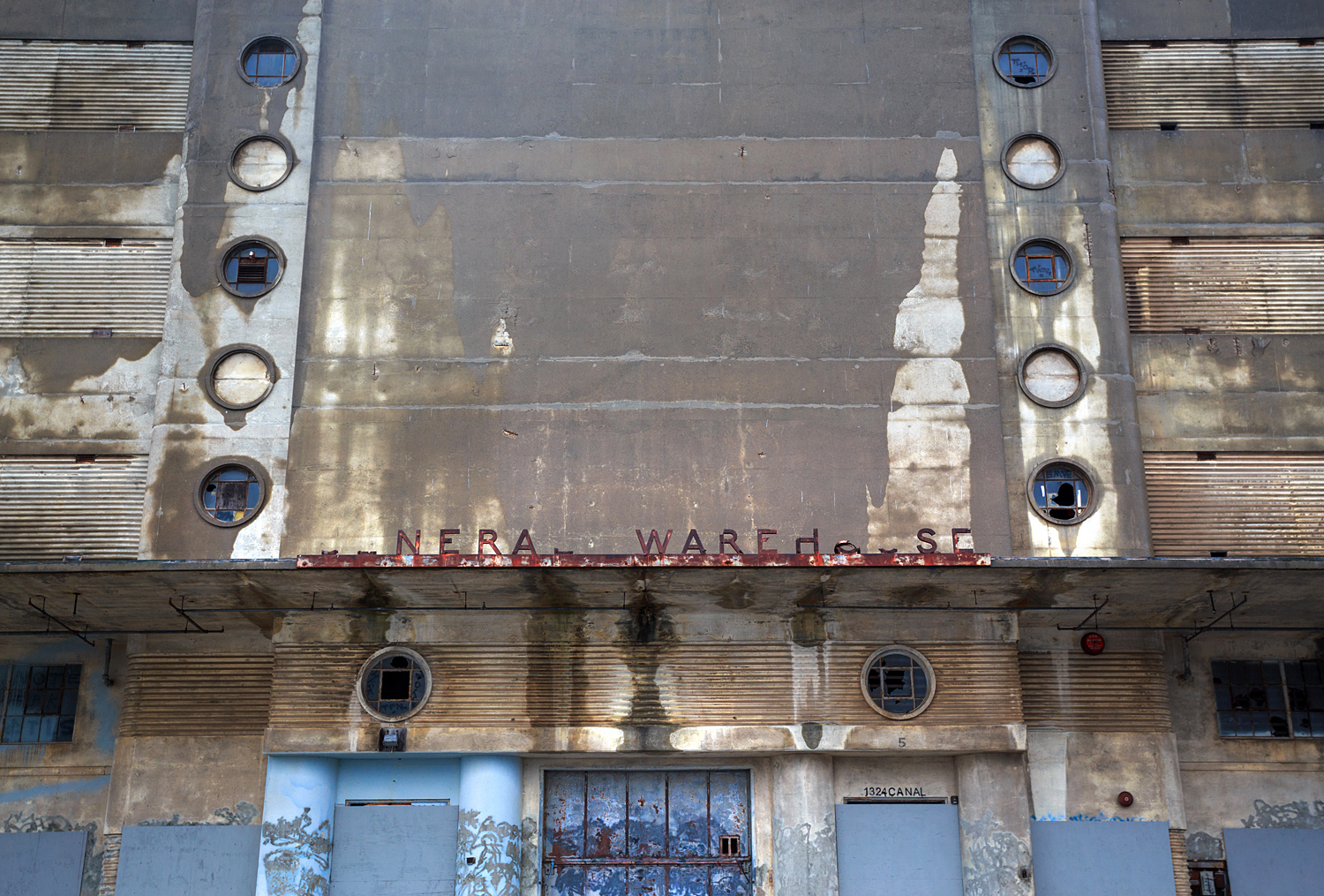
The standard list of Northern California attractions runs long and is well-known to tourists and locals alike. Familiar sights such as Highway One, the Golden Gate Bridge, Alcatraz and the wine country, as well as the sprawling presence of Silicon Valley present an obvious itinerary that has slowly become emblematic of the region.
Few, however, are acquainted with the alternative destinations also part of the local terrain, that offer an experience in many ways more genuine and representative of the overall, complex history of the San Francisco Bay Area. Even fewer still, are aware of the immense military presence that has also been part of Northern California’s history - a presence that has shaped the region for decades and left its indelible, still-visible legacy throughout.
If one starts down this alternate path of exploration, there soon manifest the usual, highly-visible suspects - the infamous Presidio, the Civil War era grandeur of Fort Point, and the vast array of permanent posts and batteries, still watching over Land's End and the Marin Headlands. But just across the water, tucked away in a nondescript part of the Bay Area and much reduced from former glory and size, still rest the remains of one of the region's most significant historic sites. With an abundance of famous places in close proximity, it is easy to see why one could very easily overlook the Richmond Shipyards.
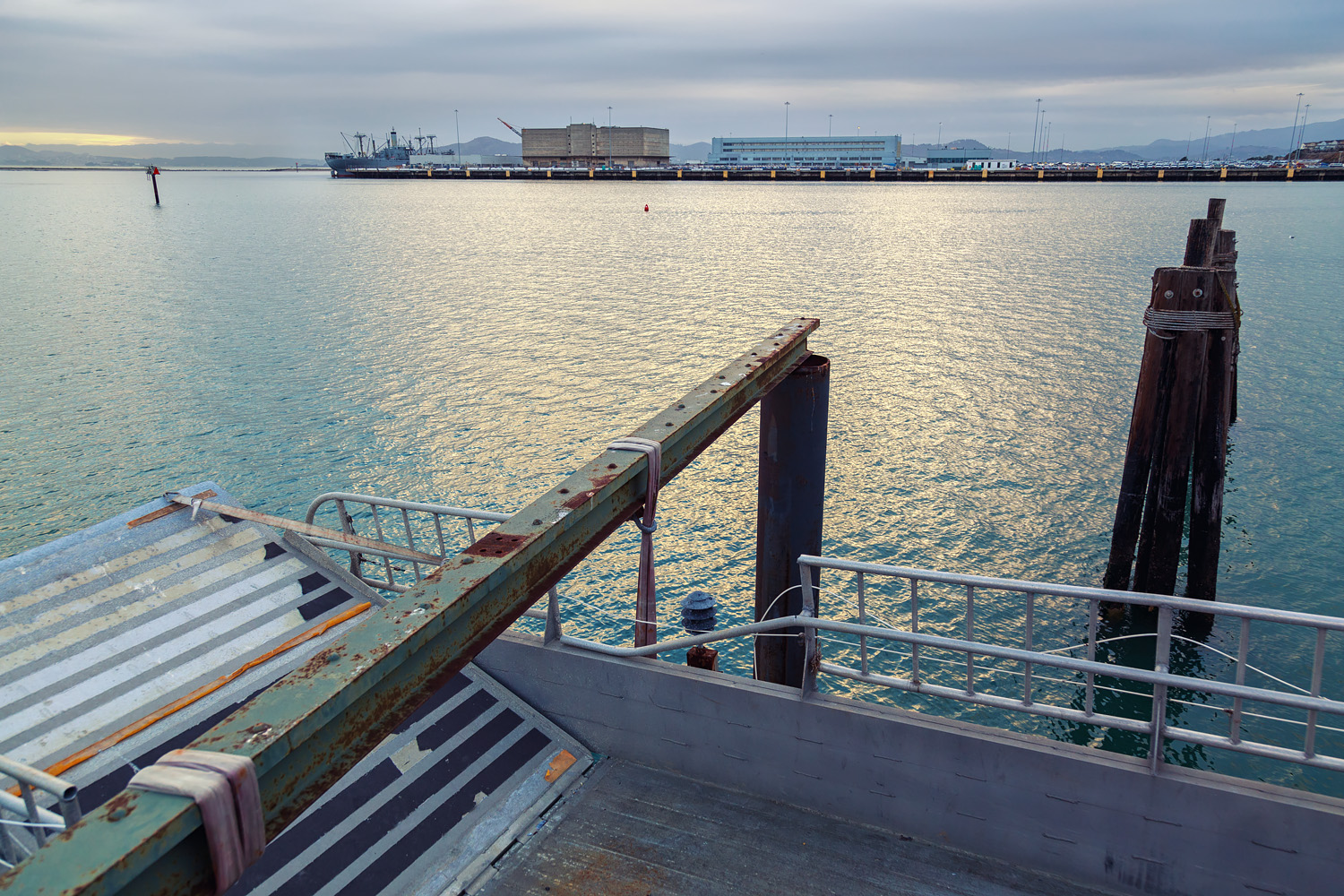
This proud engine of wartime production has been much transformed in the tumultuous decades since its foundations were laid by Henry J. Kaiser - the man whose name it once bore. Nevertheless, it still stands as one of the gems of Bay Area history, both for its contribution to the war effort and the gigantic role it played in changing the social and economic fabric of the San Francisco Bay Area.
At the onset of World War II in 1940, Kaiser's decision to build the massive shipyard complex on the outskirts of Richmond would ultimately change the city's demographics for good. The mass assembly-line type operations of his revolutionary shipbuilding process opened up jobs to unskilled workers and allowed minorities, women and the handicapped to enter the workforce in large numbers for the first time. An influx of Americans from the economically-stagnated climate of the South and Southwest United States descended on Richmond, exploding the population of the small city from 23,600 residents in 1940 to almost 100,000 by 1943.
Today, even though some remains of Kaiser's original empire can still be seen, not much is left of the shipyard operations that produced 747 ships from 1941 to 1945 (a production rate still unmatched by any shipyard in history) and helped propel the Allies to victory. Having always been intended as temporary installations, Shipyards One and Two were completely demolished after the war years, taking most of their stories to the grave.
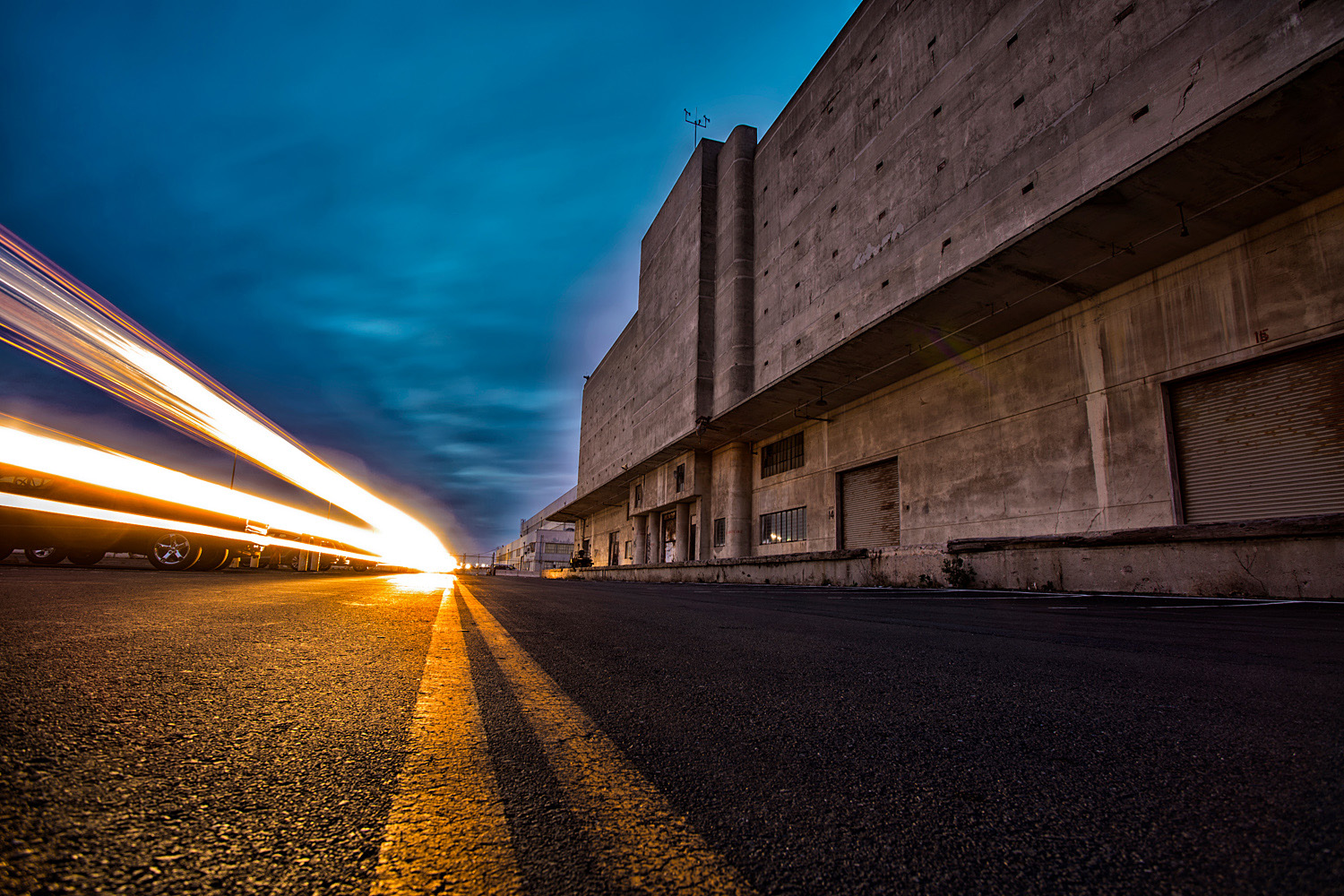
But amidst the modernization, the unyielding march of time and the all-engulfing building frenzy that is the madness of the San Francisco Bay Area, one structure still stands, almost exactly the way it appeared when construction was completed in June 1942. It was a building that provided a vital service to vessels produced at the shipyards before they set off to war, and if you have ever visited Richmond’s Shipyard Number Three, you know it is hard to miss the imposing concrete mass that is the General Warehouse. When I first visited the shipyards in 2015, I took this picture of the General Warehouse building. I did not then know its name, its origins or its purpose, but I immediately became curious when I stumbled upon it in the dark that night. After that first visit, I just had to know more about this unique-looking structure. However, I soon found out that information was extremely hard to come by, and a few years had to elapse before the archives finally divulged their secrets.
It turns out that the design for this monumental structure started out as a rough sketch on the back of an envelope, made by chief Shipyard Number Three architect, Morris Wortman, as he was returning to California after a visit to Kaiser offices in New York. The most important building designed for the third shipyard in the series, was built in by Cahill Bros. in the Streamline Moderne style (a late variation of Art Deco), with curved corners, horizontal banding and decorative porthole windows. Driven by the urgency of war, the General Warehouse took only 120 days to be completed - another feat of expediency in production that was starting to become the norm at the Richmond Shipyards.
Shipyard Number Three was laid out by Henry Bernat, Kaiser's marine design engineer, who organized the zones of work in lines, following the construction progress of the ships produced. The General Warehouse was the last in a series of facilities that were laid out sequentially from north to south, and was a part of the Outfitting zone of operation (the other three being Engineering, Hull Construction and Administration). As the name suggests, buildings in this zone were directly associated with vessel outfitting activities that occurred post-launch.
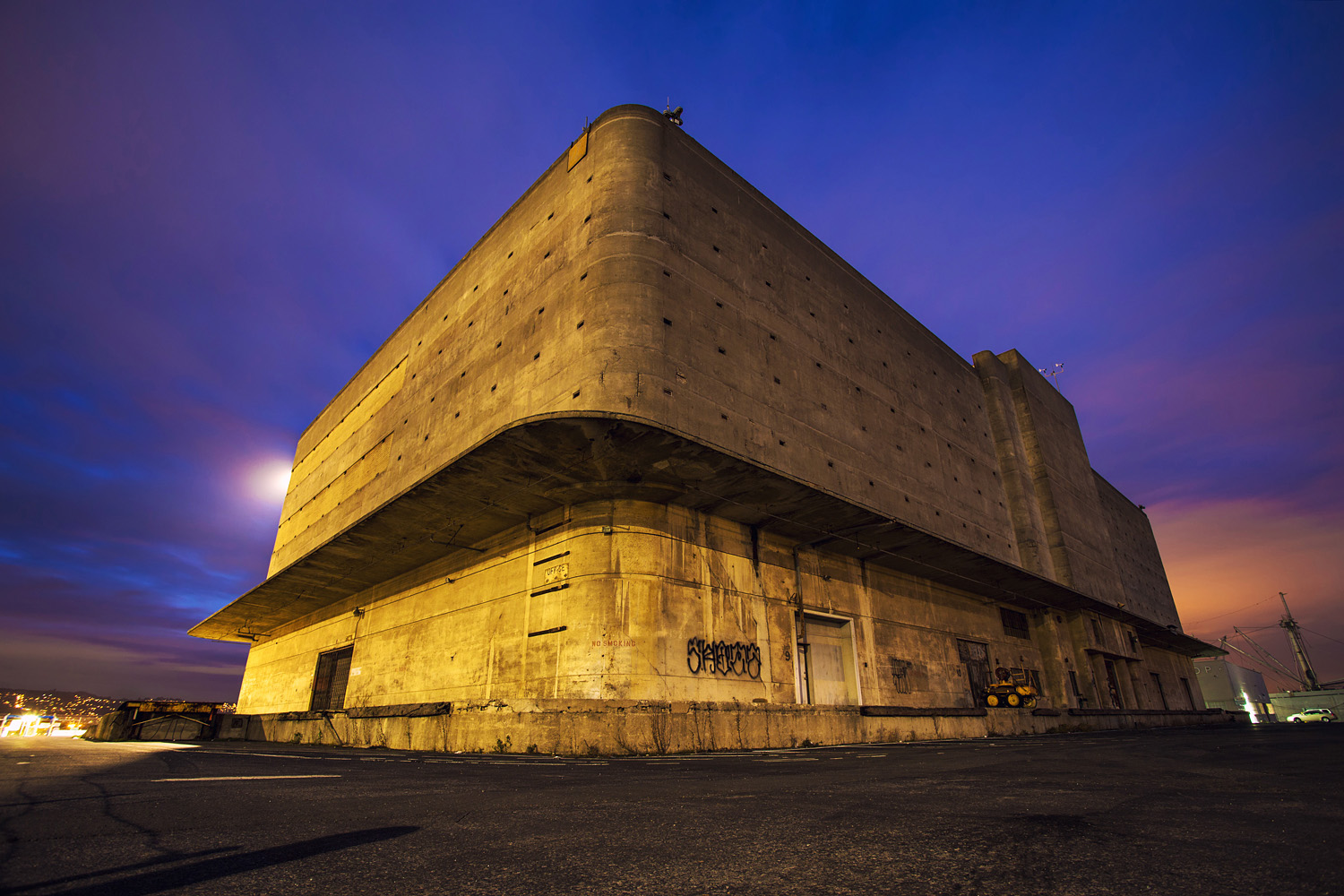
As the last stop for newly-produced ships, the huge storehouse provided them with their final furnishings. Here, the vessels received any material goods and equipment, such as stoves, blankets, waste baskets, mops, and anything else that they would need for full functionality. It was a few years before I finally returned to the shipyards – this time, to visit the SS Red Oak Victory museum – a Victory Ship that was a 1944 product of the Richmond Number 1 Yard. The General Warehouse is located right next to the ship, and I decided to take a walk around before my visit, to see if there was any change in its state of appearance. I started my tour around the periphery of the building, walking on the raised platform that surrounds it. Surely enough, when I turned the corner, one of those infamous white pickup trucks headed my way. It wasn't until we were midway through the usual conversation about private property, trespassing etc., that I realized that I absolutely had to find a way to see the inside of this building.
Unwilling to yield to the harassment, I pushed back, asking about the owners of the building whose platform I was being asked to vacate. She promptly informed me that the Port Of Richmond, whose offices were just around the corner, was now the owner of the warehouse and any permission to be on its grounds would have to come from them.
I very rarely ask consent to visit any of the sites I frequent, for the simple reason that there is often no one to ask from - these places are often abandoned and frequented only by ghosts and individuals such as myself. But whenever there is a chance to talk to a person in charge or a property owner, I always make sure to obtain their permission to enter and photograph, explaining the reason for my interest. Therefore, I now decided to try my luck with the people from Port Of Richmond operations.
No sooner had I entered the offices (which are housed in what once used to be the Riggers Loft, another original Shipyard Number Three building), than I came face to face with a gentleman, who happened to be Jim Matzorkis, the director of the Port Of Richmond. Kind enough to hear me out and present me with his business card, Jim mentioned that if I was to send him an e-mail explaining my intentions and interest in the building, he would consider my request.
Somewhat in disbelief at the receptivity exhibited, I must admit that I was a bit skeptical about my chances when I did send the message that same evening. My years of experience in documenting abandoned historic sites had taught me otherwise.
To my great surprise, a few days later I received an e-mail from Jim, stating that they would provide access to the warehouse on a day of my choosing. It seemed that I was going to be granted a rare glimpse into the historic Richmond Shipyards' past after all.
...
It was a grey, cold and rainy day when I arrived at Shipyard Number Three a few weeks after setting our date. I parked the car and headed over to the port office, where I was literally handed the key to the building and told to bring it back when finished. Not wanting to waste time when presented with such a rare opportunity, I waded through the puddles toward the General Warehouse.
I did not know what to expect when I opened the door, but in the back of my mind I somehow thought that there would be light inside the building. My subconscious inklings were soon dispersed, as upon stepping inside, I was at once enveloped in total darkness. The concrete behemoth had been sitting unused for decades, and it seemed that all electrical power was now disconnected. It looked like my work would have to be done by torch light and tripod.
Making out the outlines of doors and windows, I headed to what seemed to be the first-floor office area directly to my left. My headlamp illuminated the corner office space, the first part of a larger chamber. I could now hear the sound of water seeping through unseen gaps and echoing throughout the structure. The curved corner of the building's northwestern side was clearly visible, as was the decay of the roof's surface:

It felt like being in a giant damp, cold sarcophagus. But signs of life were all around:
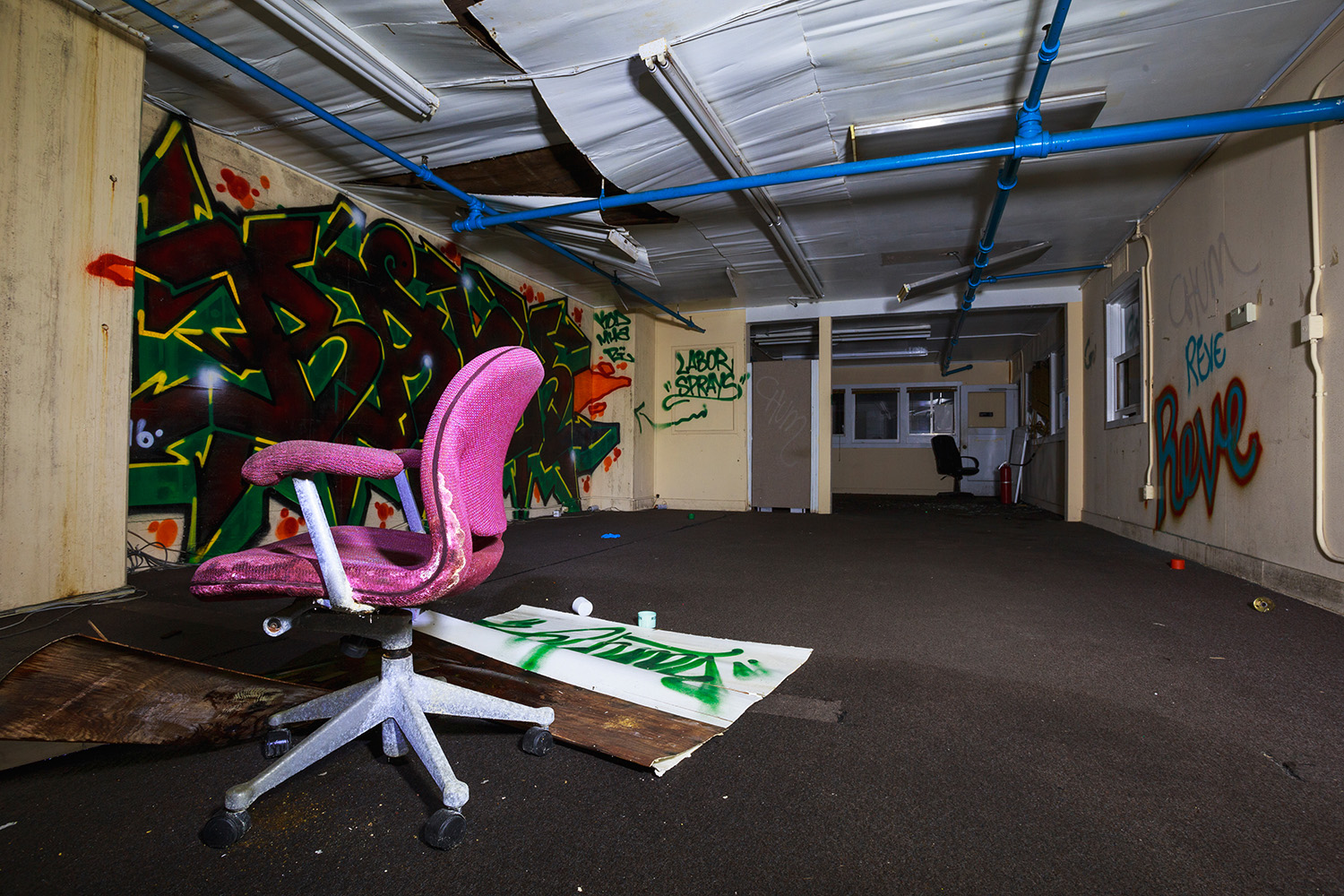
The walls still displayed safety notices from the State Compensation Insurance Fund that seemed very recent:
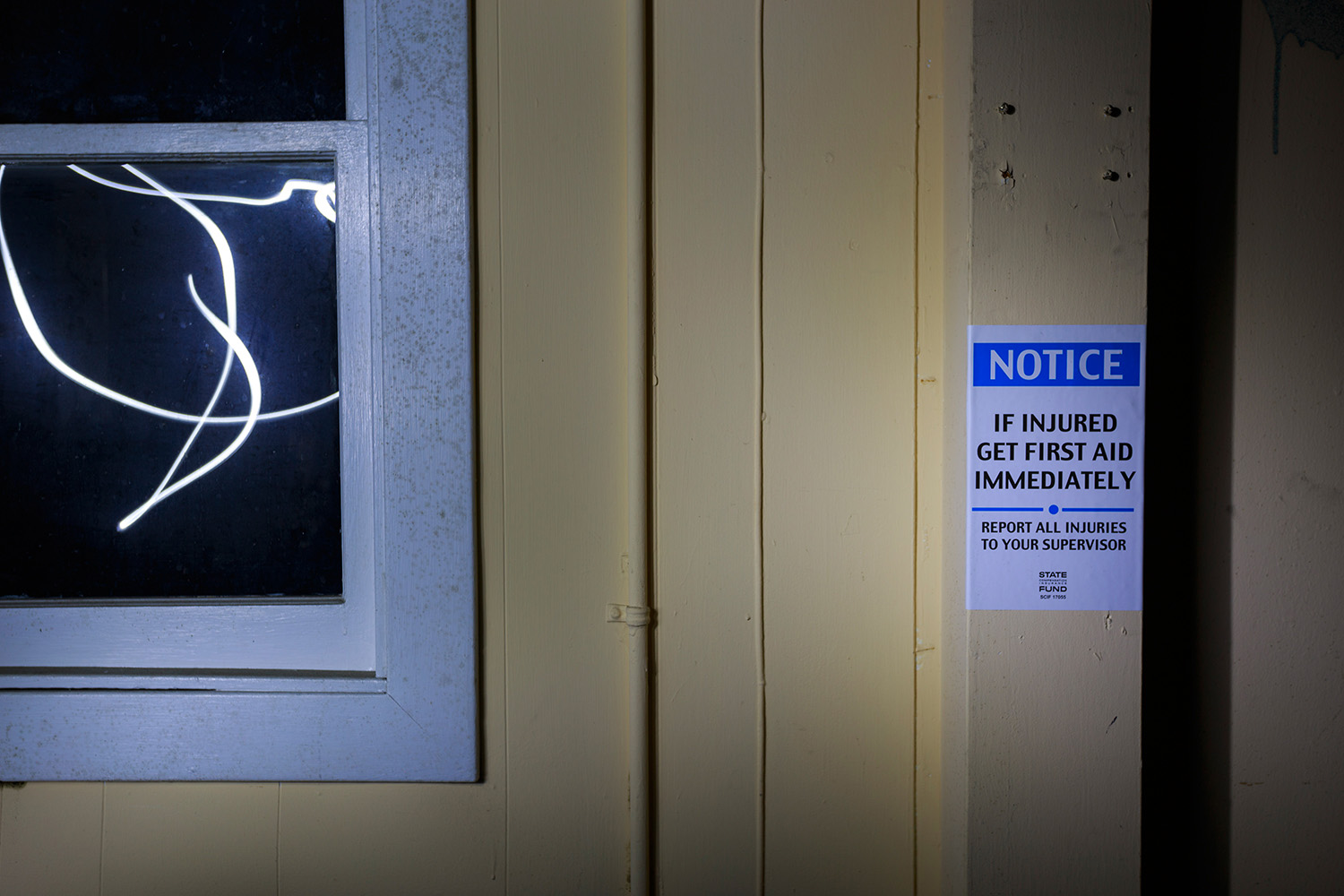
And an apocalyptic still-life scene greeted me at the other end of the hall:
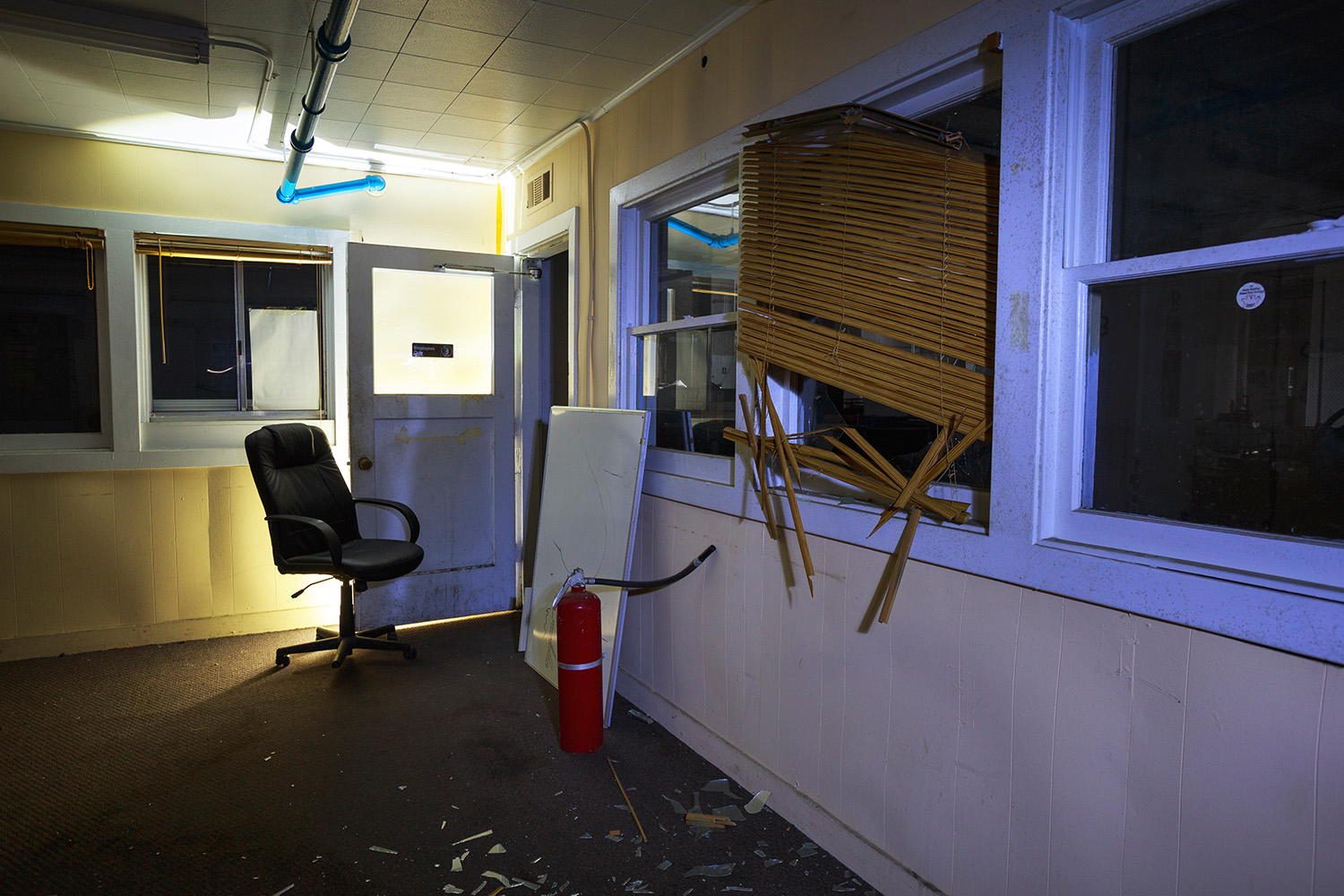
On the wall opposite, a window looked out toward the northern loading dock:
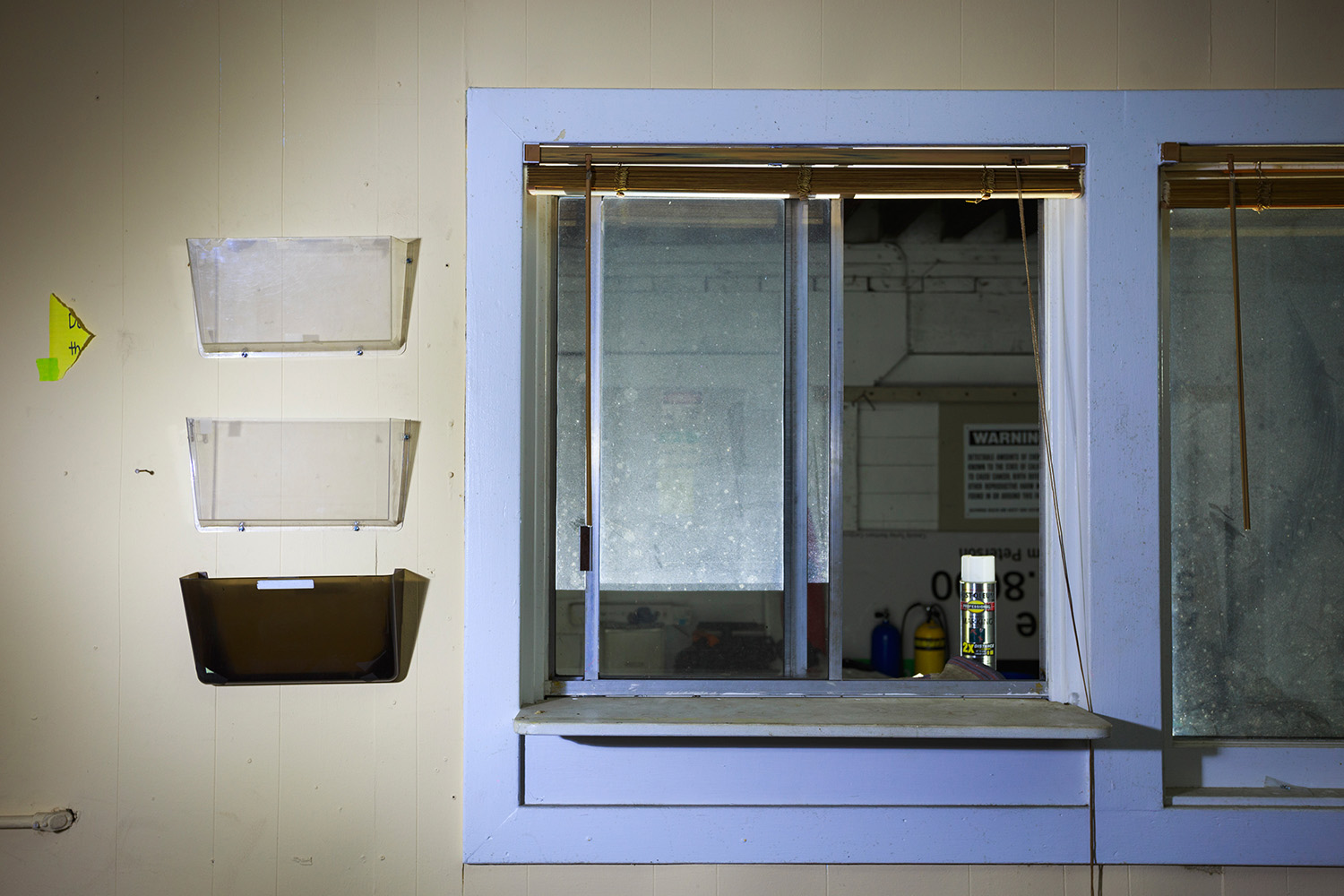
I headed out into the loading dock area, even though I knew there was more to see inside the office enclosure. At this point, I did not yet know how much of the building I would be able to access and I was quite randomly moving from place to place, trying to absorb it all. Even in the darkness the dock seemed strangely alive, as if the workers had just now left everything in place and stepped out for a lunch break:
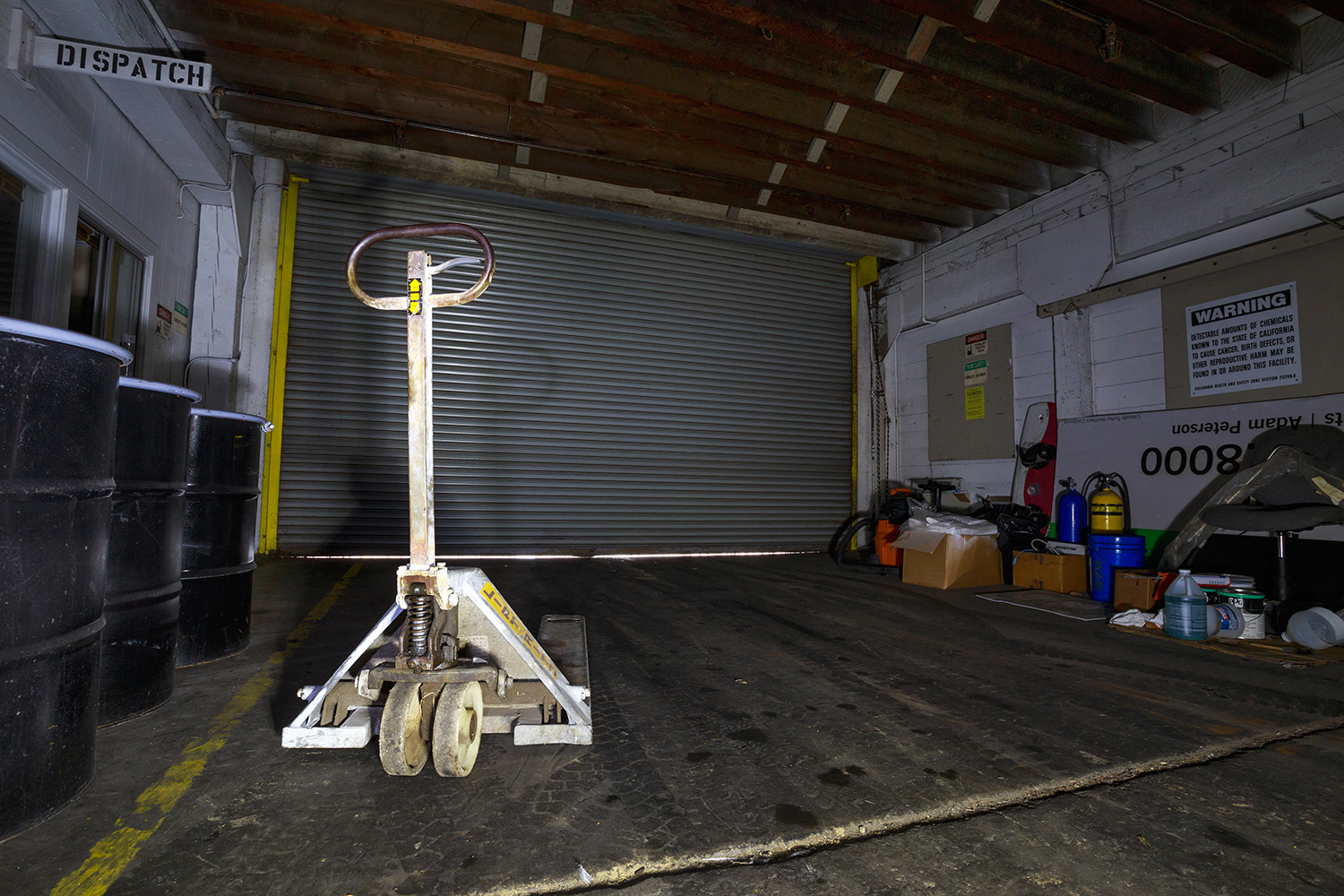
However, I was now realizing the true nature of my endeavor. The task of photographing had become more time and energy-consuming than I had anticipated. It took a long time to set up and shoot even a single scene, as I was working in complete darkness, with the camera on a tripod, light-painting with my torch to achieve the desired exposure. When I first entered the building, I had seen a chain link fence directly opposite the office enclosure, seemingly blocking off the rest of the enormous ground floor and it had briefly crossed my mind that the office space and dock area might be the only part of the building I would be able to explore. I finished photographing the dock and turned around, noticing that the area between the offices and the fence was filled in with different colored barrels and what looked like used paint canisters:
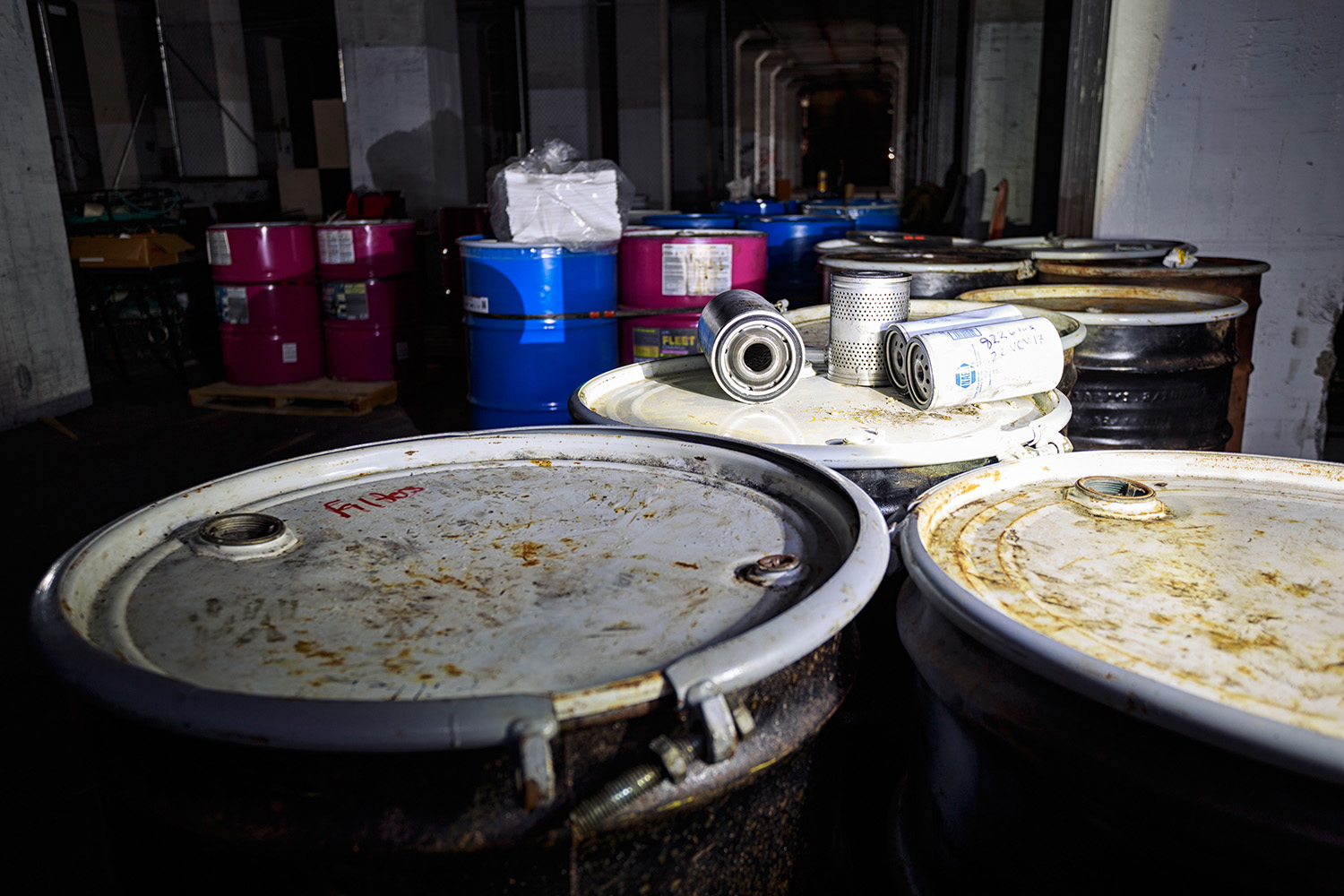
Refusing to give up so easily and hoping that I would at least be able to take some shots through the fence, I headed over to examine the situation at the dividing line. I sensed that the adventure might not end so quickly after all, but I was still pleasantly surprised to observe a large opening cut into the chain link. There was a way in after all!
I was soon on the other side of the barrier, with nothing restraining my further progress. The enormous, gaping cavern that was the first floor of the General Warehouse now lay before me. Gratefully, there was some available light seeping from the windows and I wasted no time in putting it to use. The fence enclosing the office space and storage area can be seen on the left of the photograph:
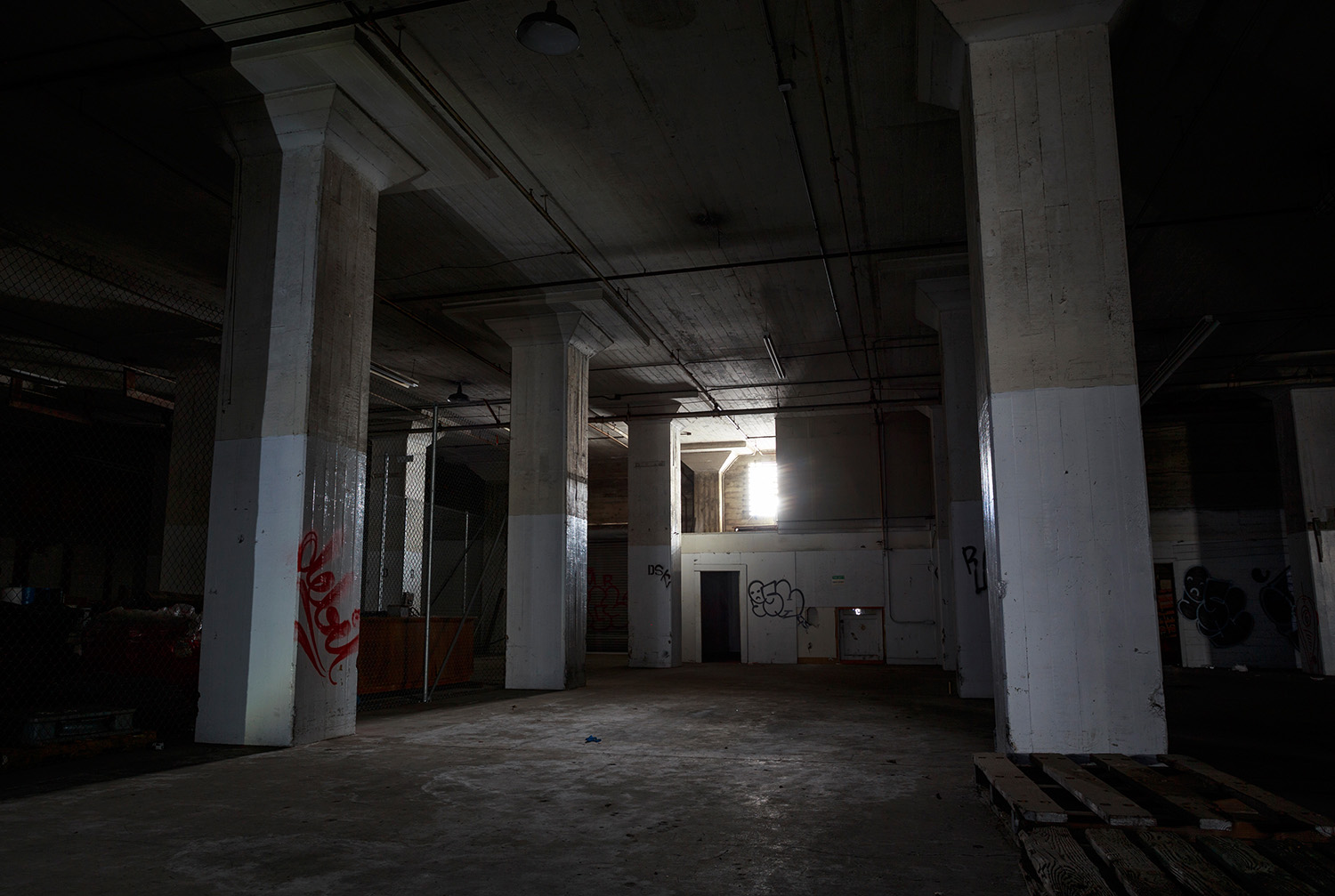
Gigantic columns stood in perfect rows, mutely holding up the massive concrete roof. All around them was nothing but empty space:
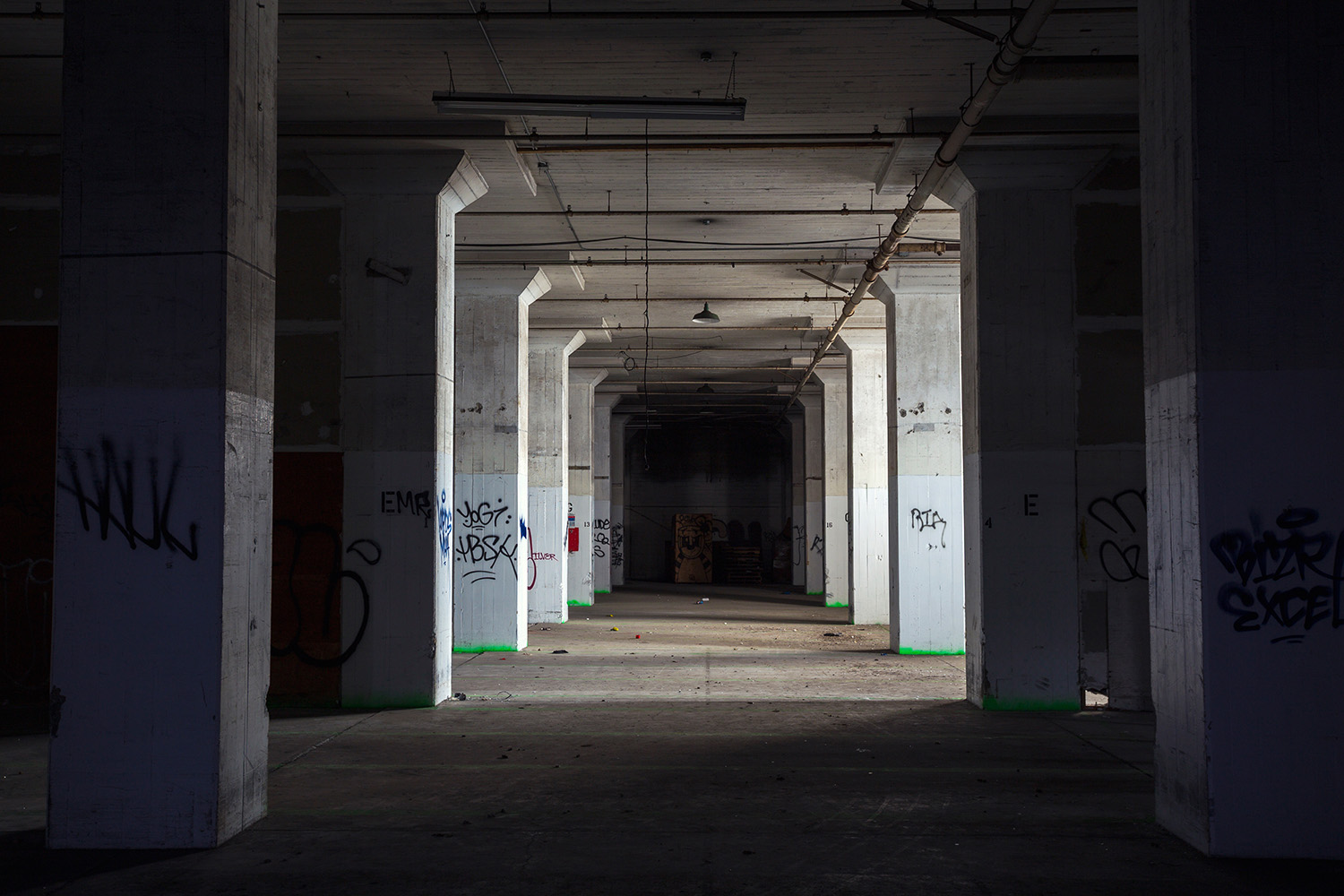
On the other side of the hallway I discovered a boarded up window that had once offered a view toward the adjacent graving basins of Shipyard Number Three:
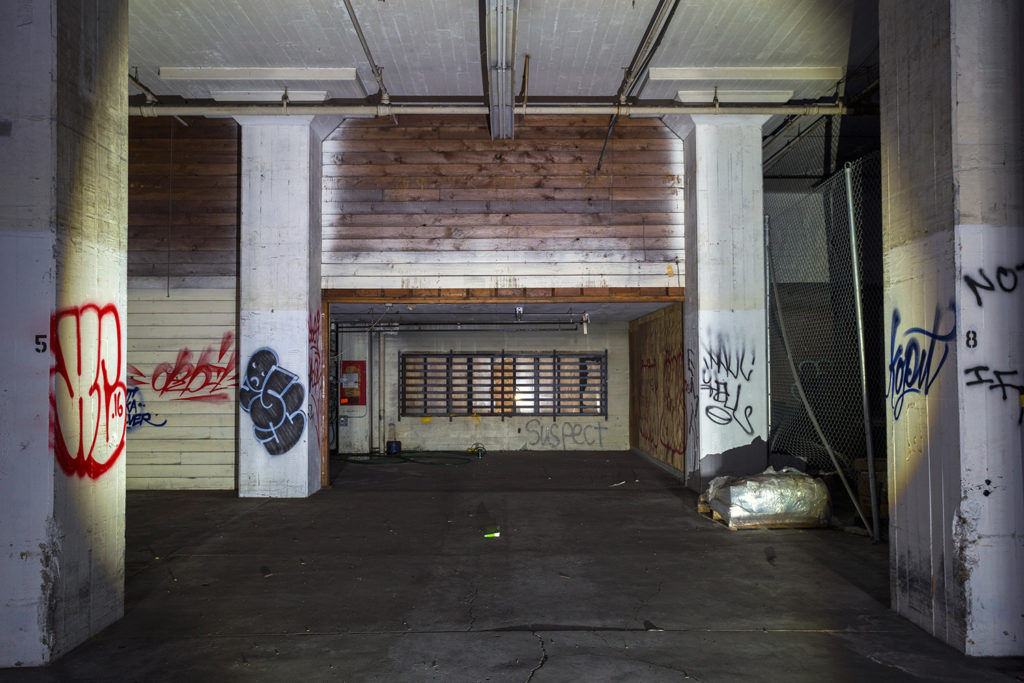
As soon as I got closer and looked left, I saw what I had been hoping for all along - an open door! It was time to make history again:
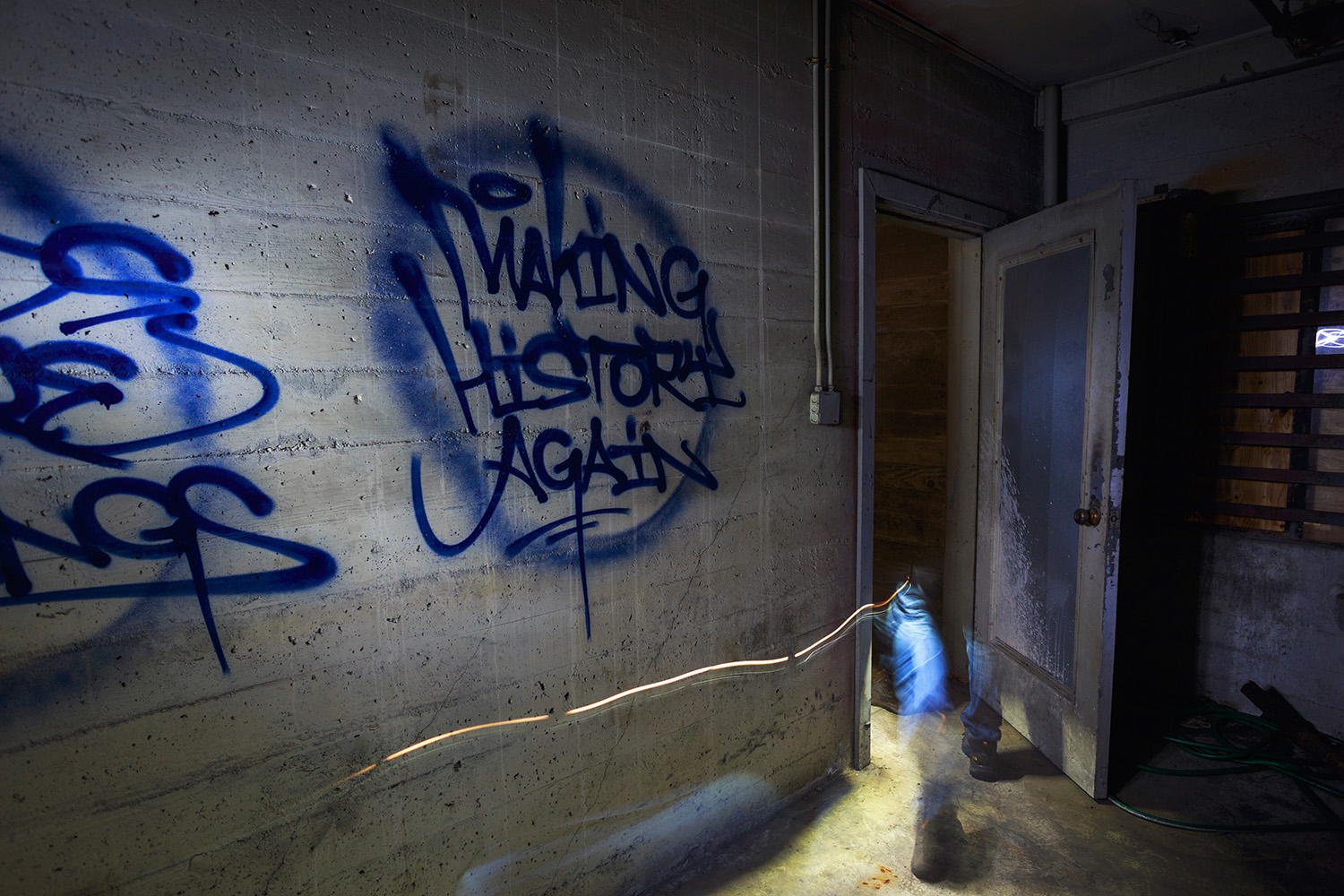
And, behind the door, a stairwell leading up the floors of the old colossus - now things were starting to look real interesting:
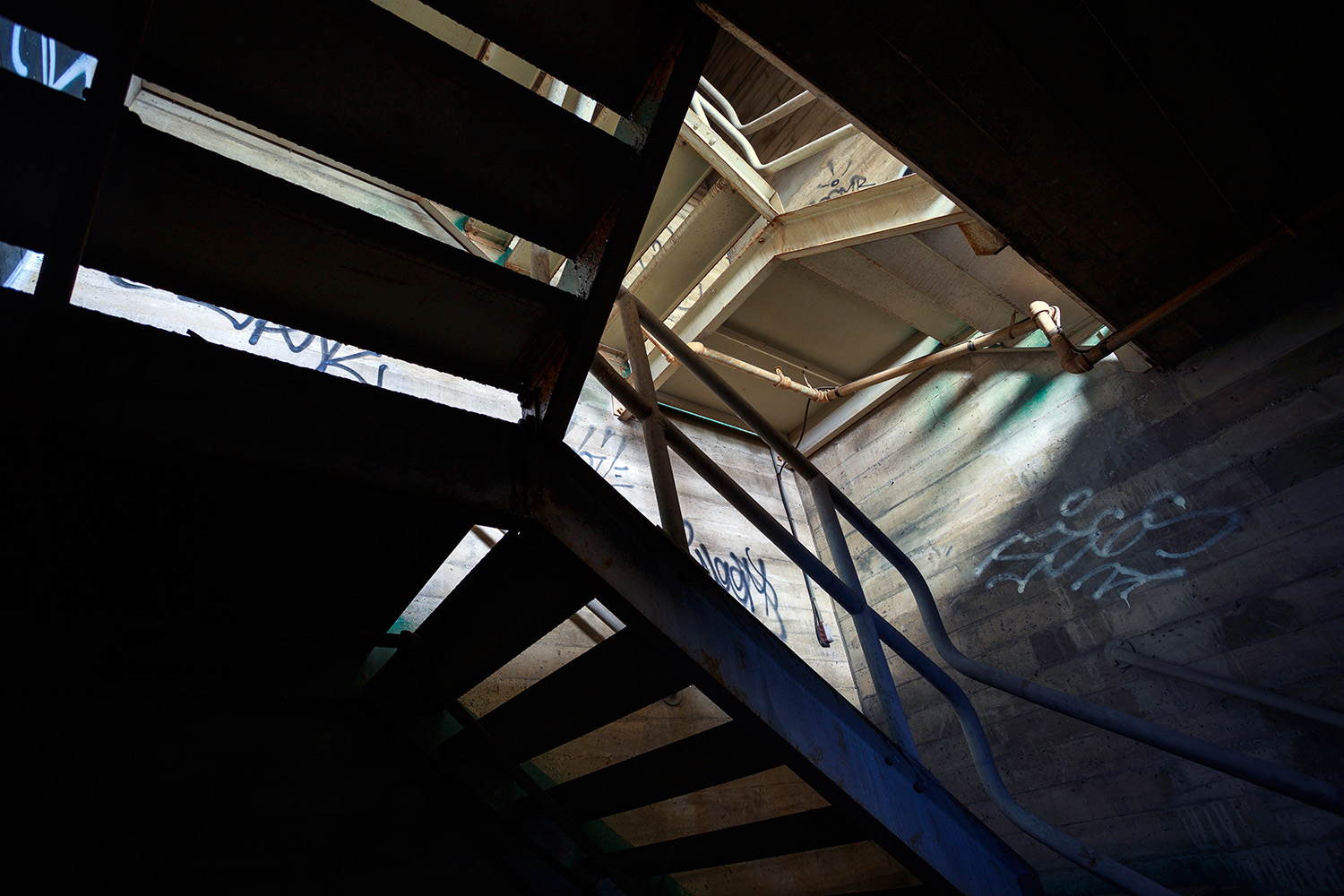
As I started up the stairs, I noticed that the light began to increase. I soon found myself at the source of it - a large, partially broken window:
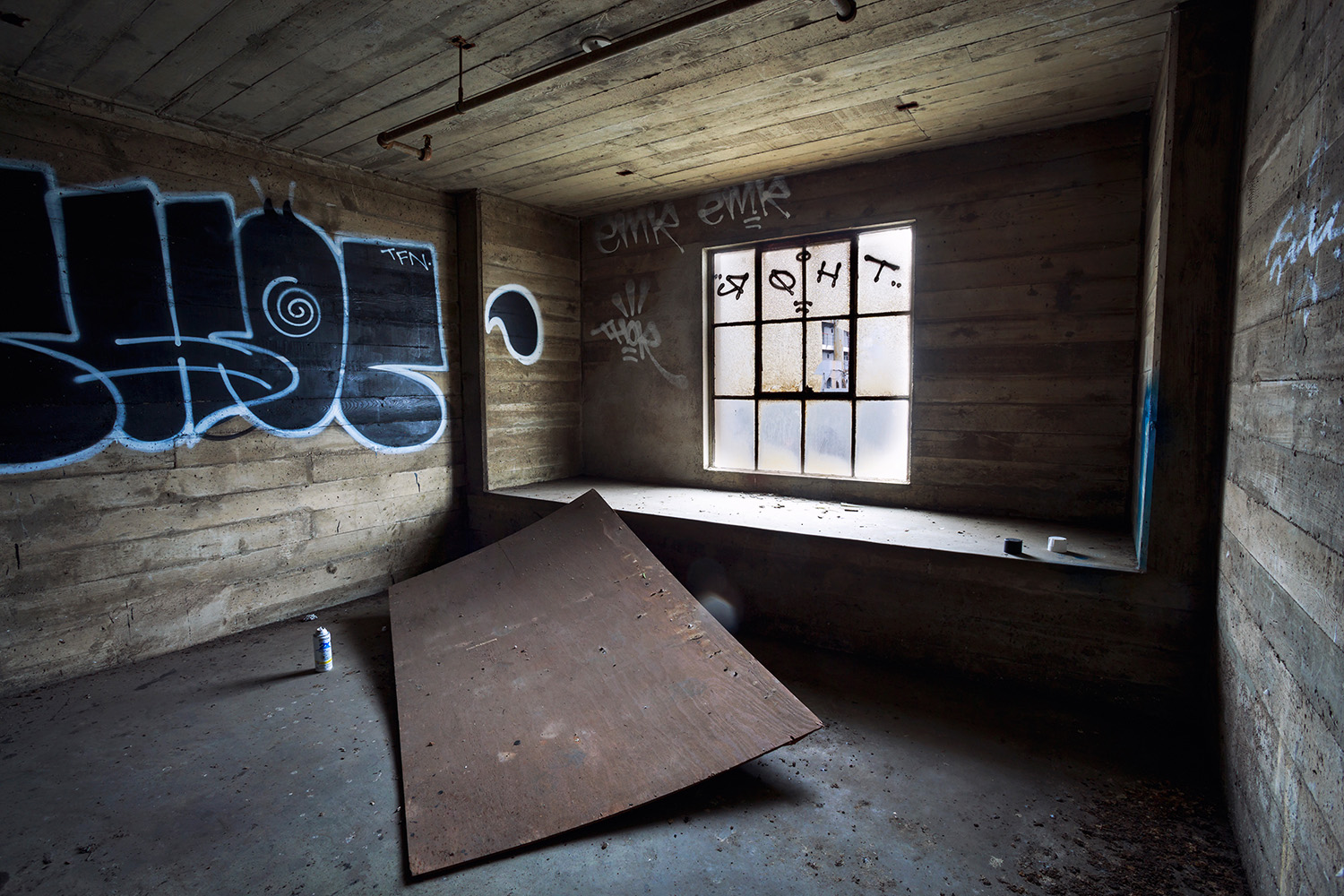
It offered a view toward the SS Red Oak Victory, docked just outside the warehouse:
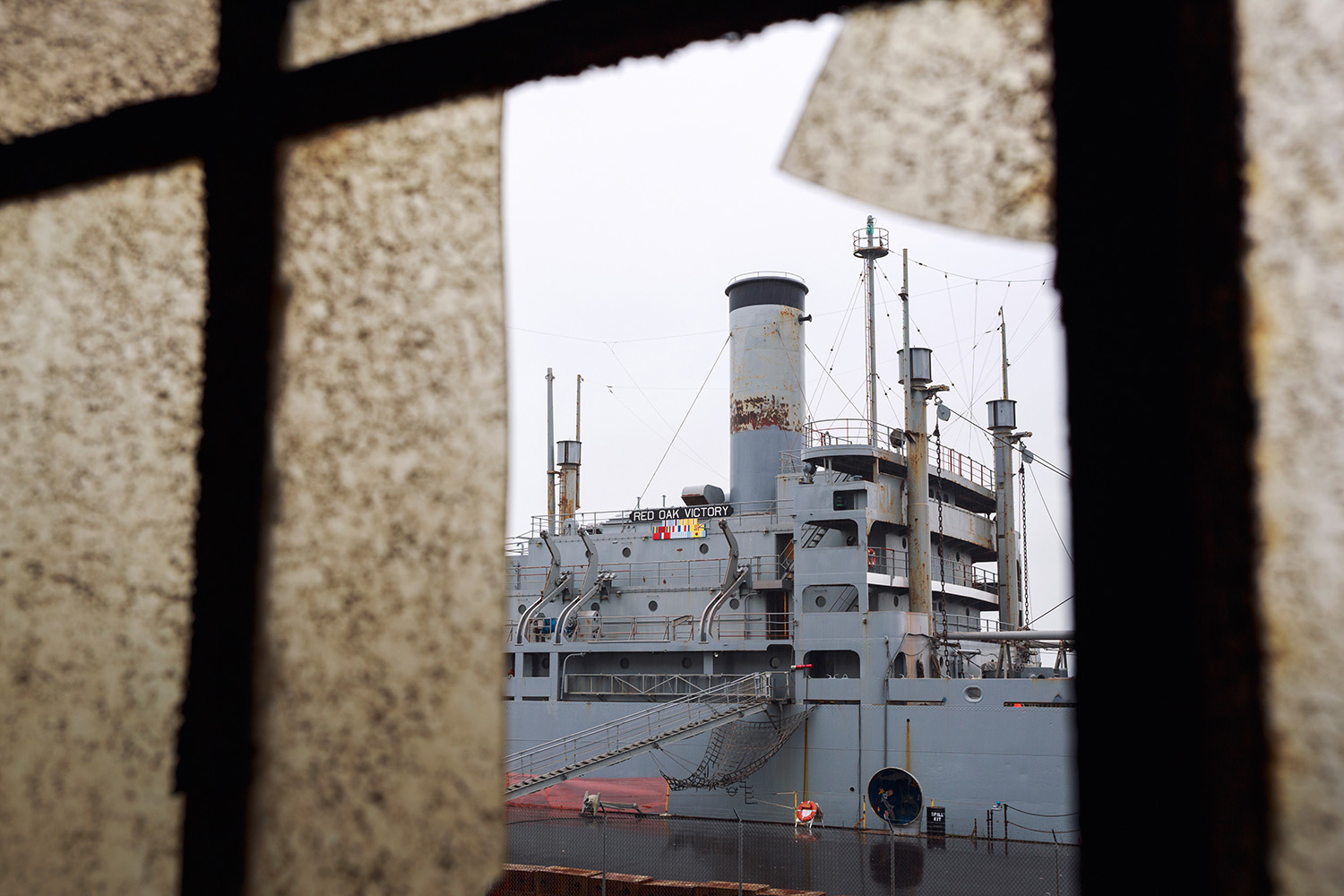
The stairs kept winding up and up through the remaining floors, but for now, there was an interesting-looking room directly to my left that I had to explore:
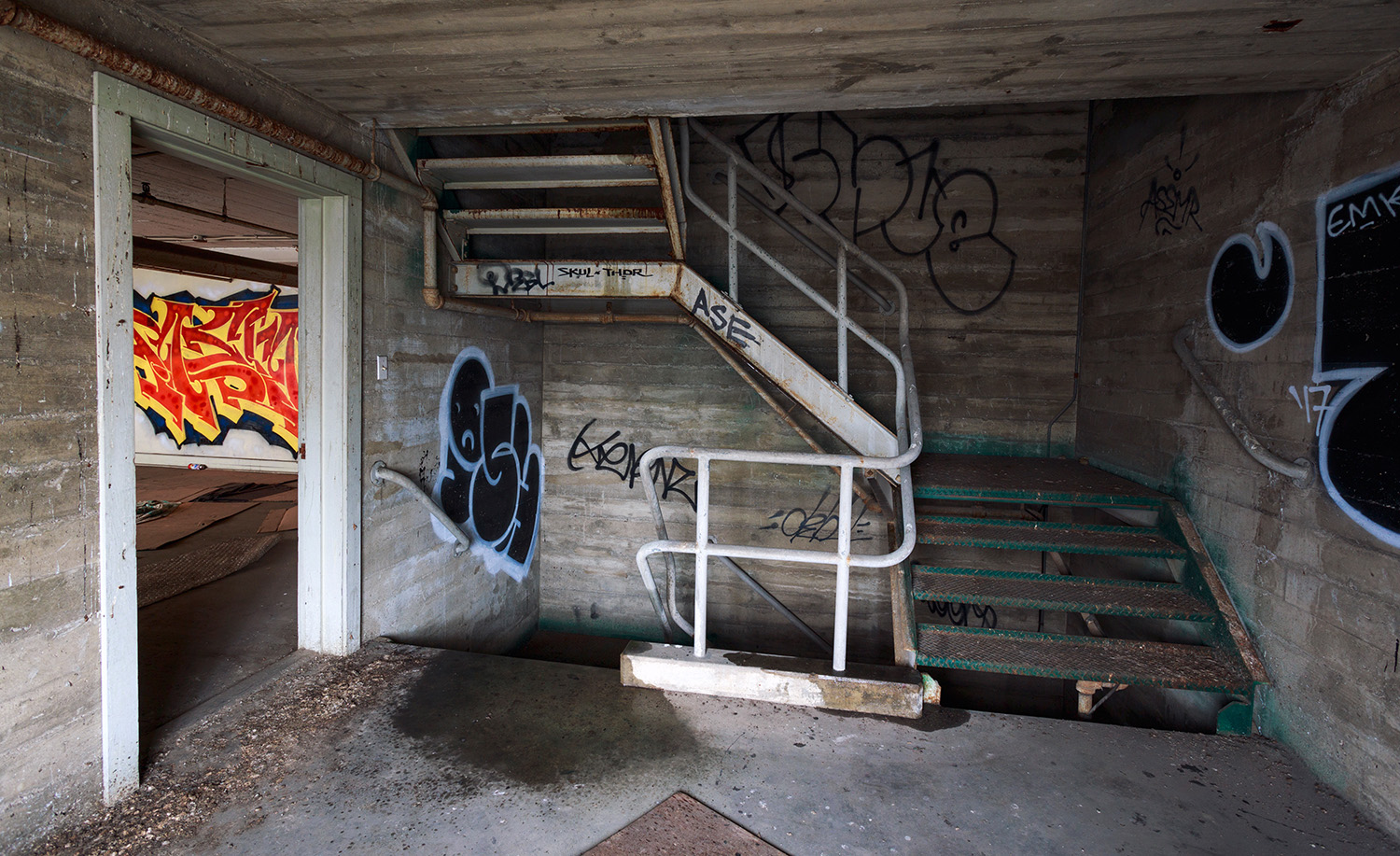
What looked like a pair of car seats decorated the adjacent wall:
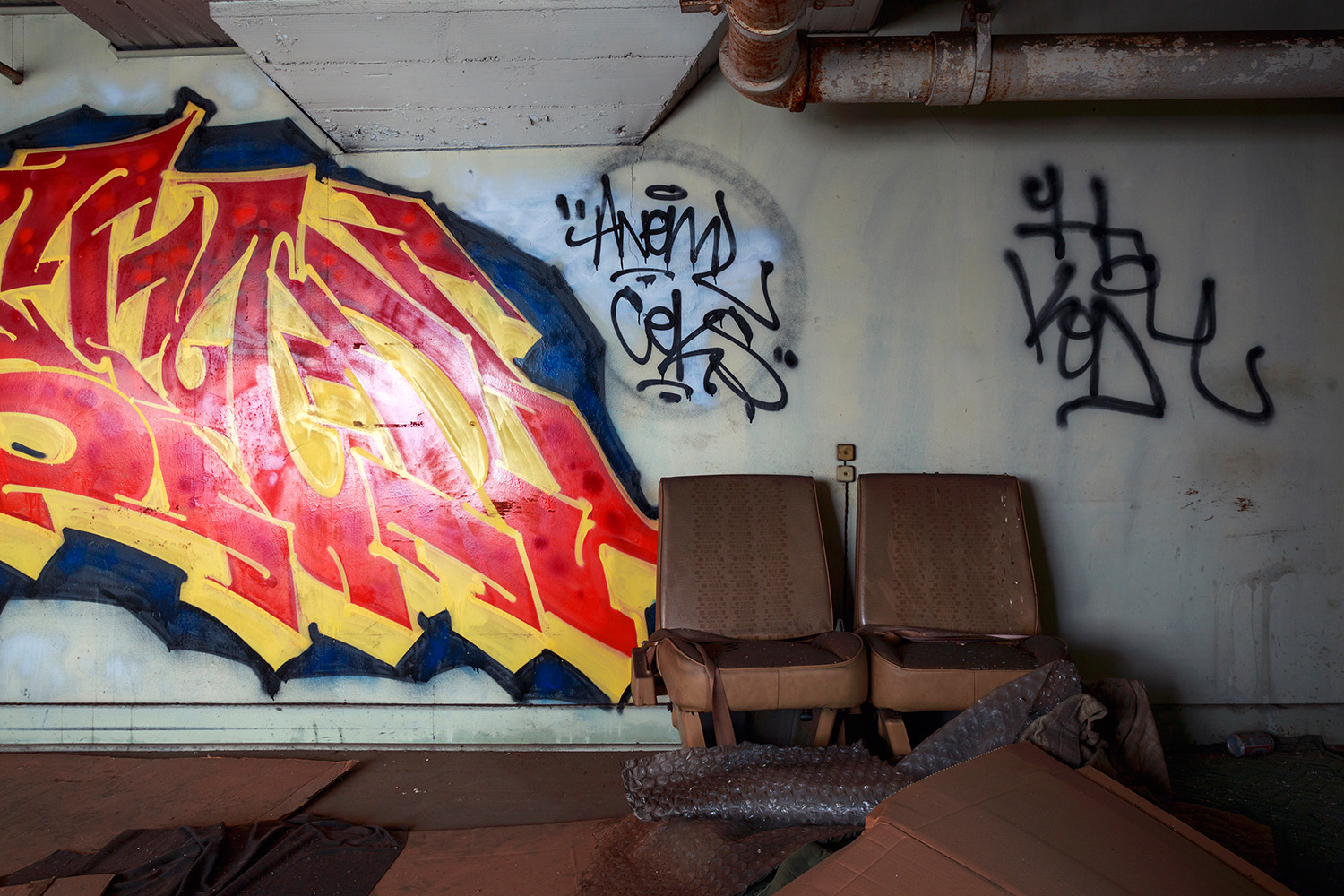
The scene was completed by a lonely chair, placed in just the right spot to create a perfect frame - perhaps I was not the first visitor to witness these scenes after all:
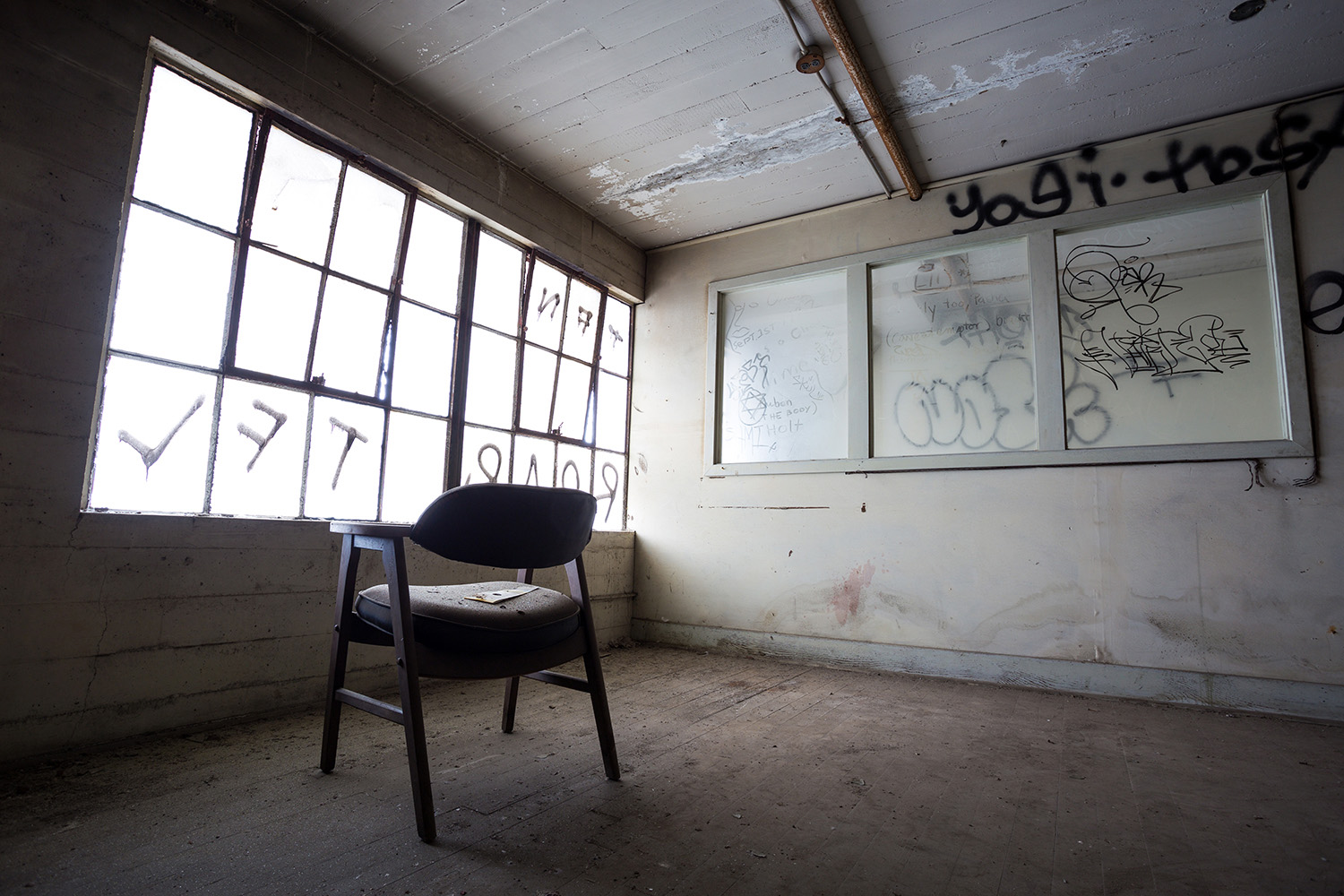
Sensing that there was more to see, I continued up the stairs. My elation at being able to temporarily shoot without artificial light was soon cut short. The second floor was enveloped in total darkness and the headlight and torch resumed their duties once more:

The "No Smoking" sign was attached to a door that led into another huge chamber. I suddenly felt the dampness increase, as if this floor was somehow more susceptible to being permeated by the rainwater. It was time to see what level two had on offer:
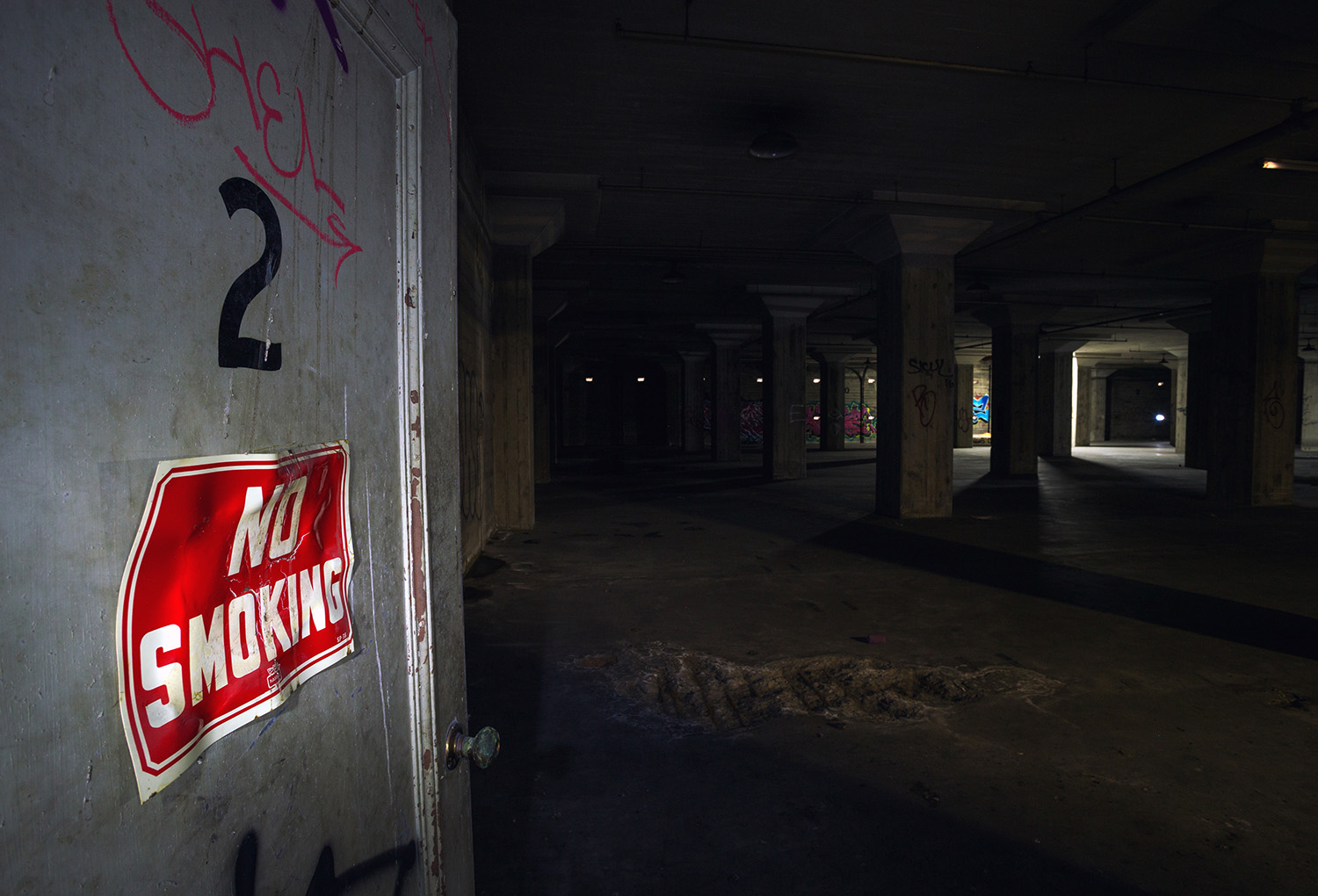
For the first time, I saw an electric light. It appeared there was some power available to the warehouse after all, and that limited lighting was still in place here and there. Illumination notwithstanding, the warehouse spirits soon made their appearance:
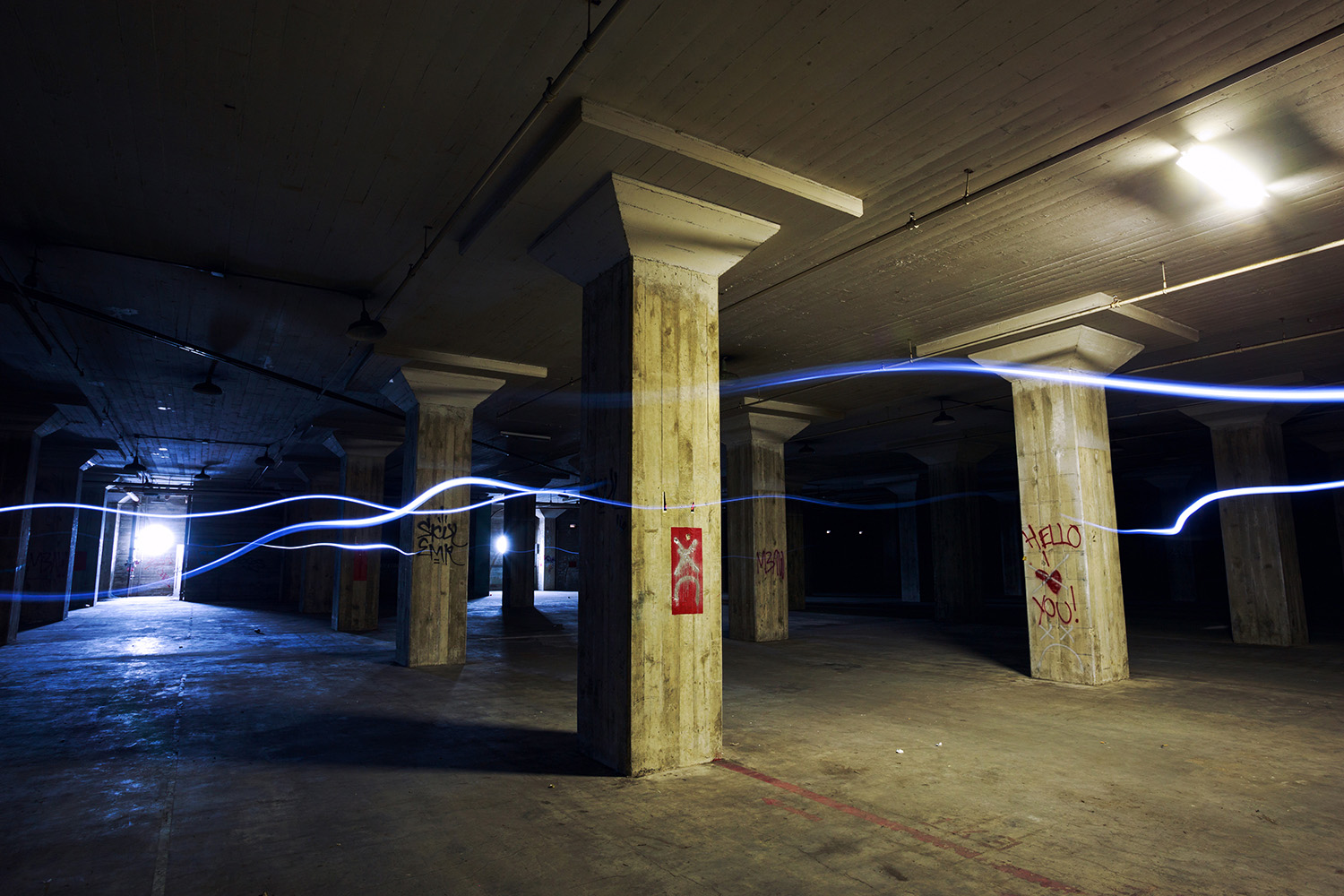
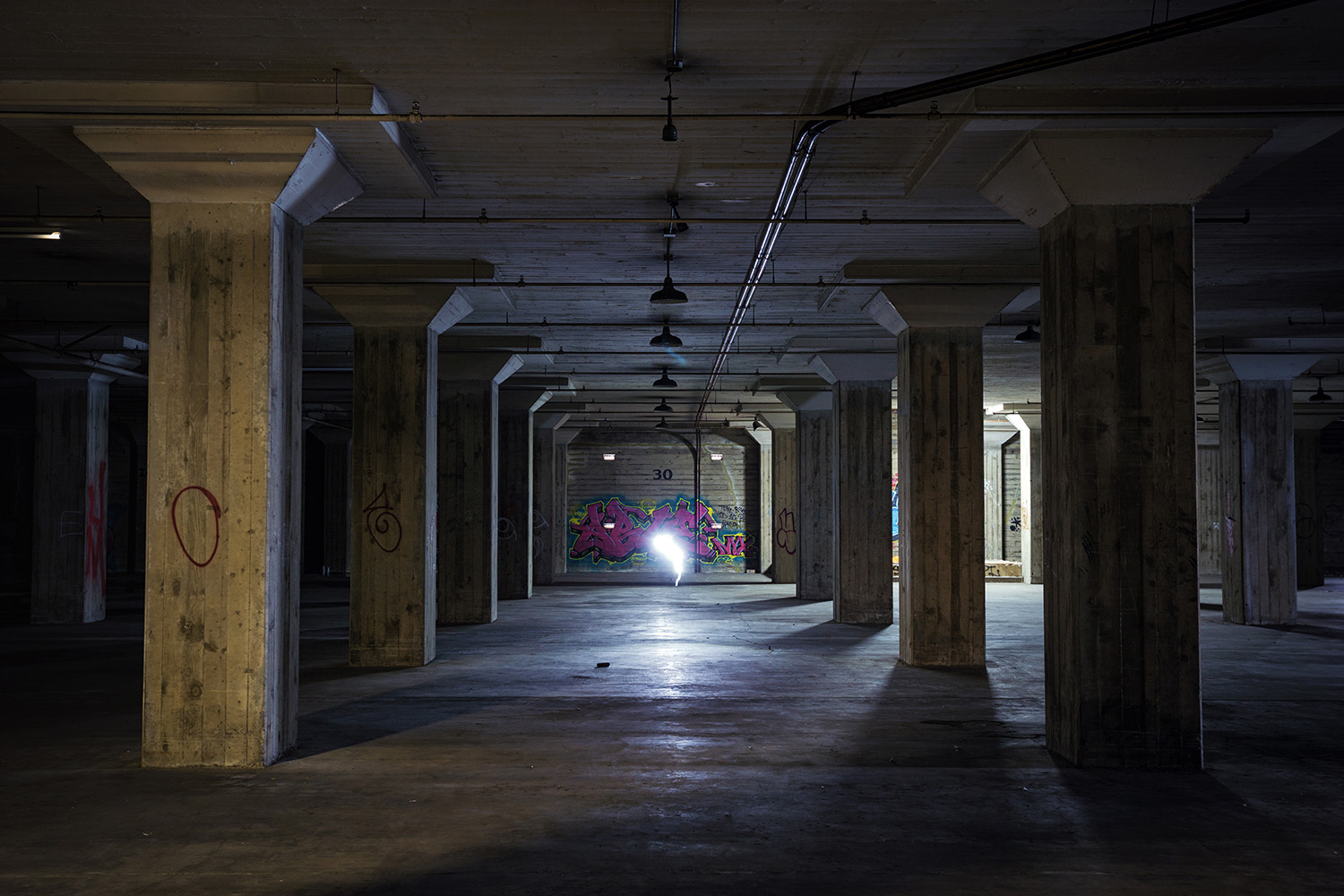
I soon had my first encounter with one of the huge freight elevators that once served both sides of the warehouse:
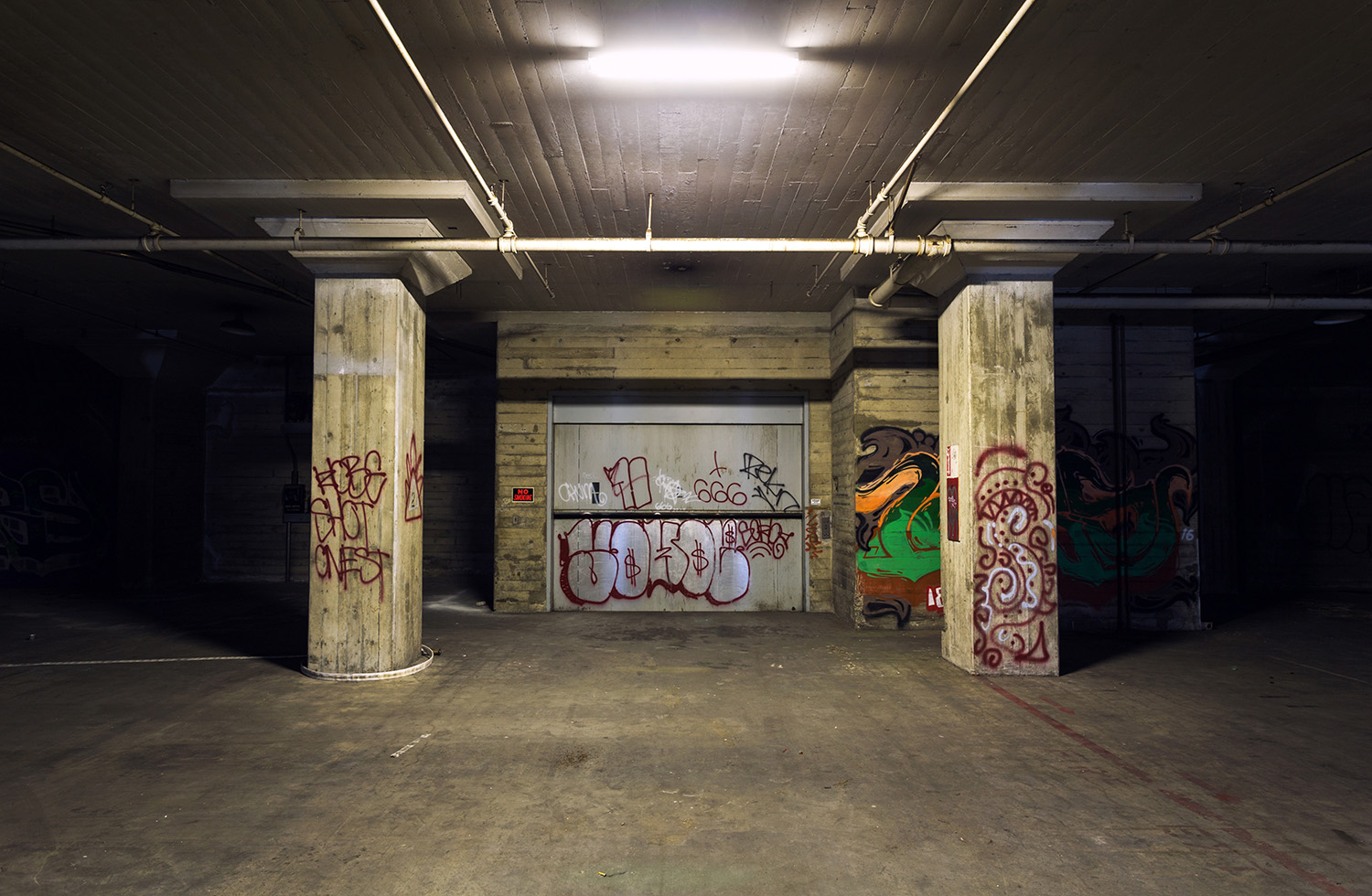
Moving about the enormous open space of the second floor, I began to see where the dampness was coming from - water puddles all around alluded to the multitude of leaks to which the structure was now succumbing. I also cast my first glance upon one of the building's emblematic porthole windows:
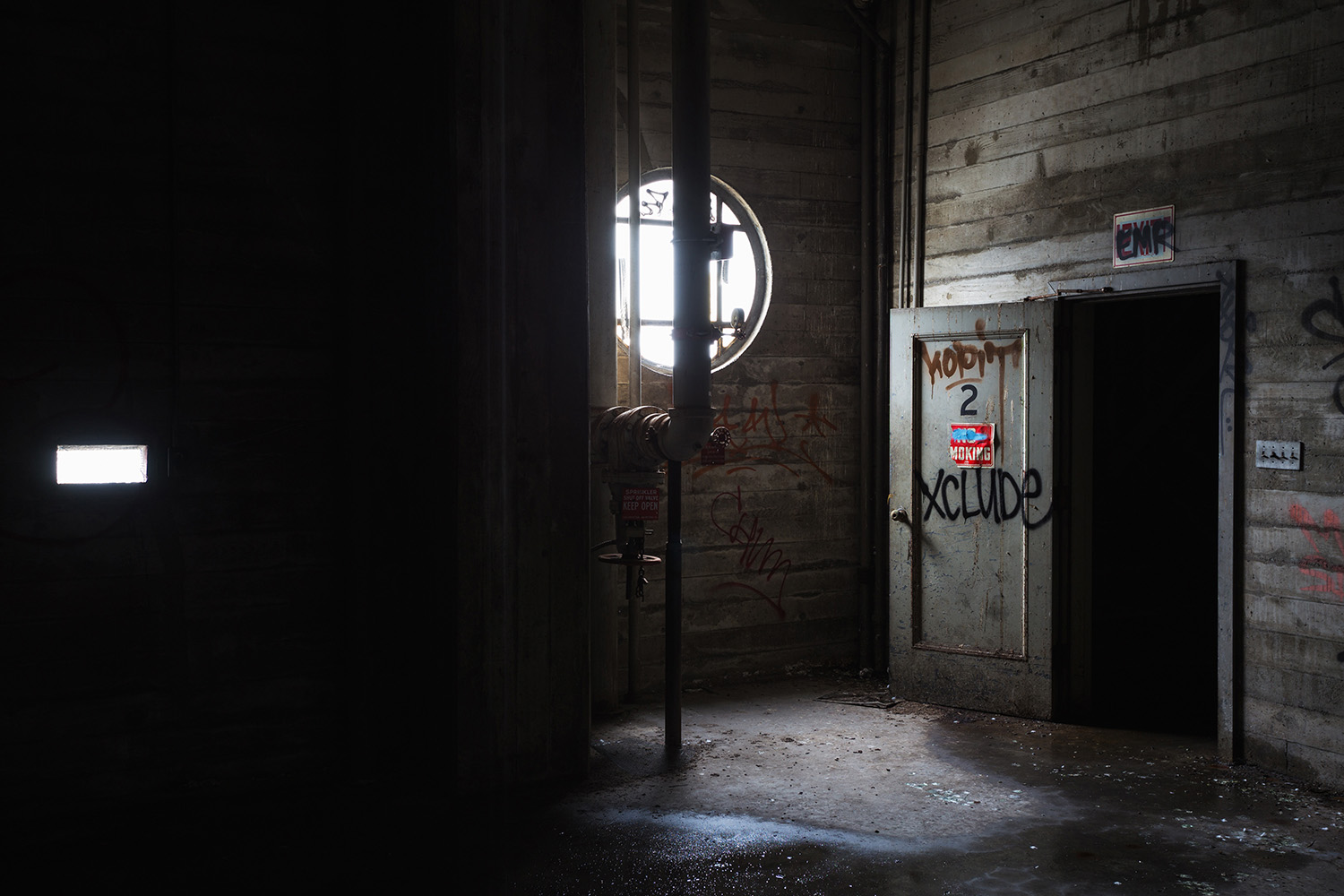
On my left, a long-abandoned fire hose lay uncoiled from its reel:
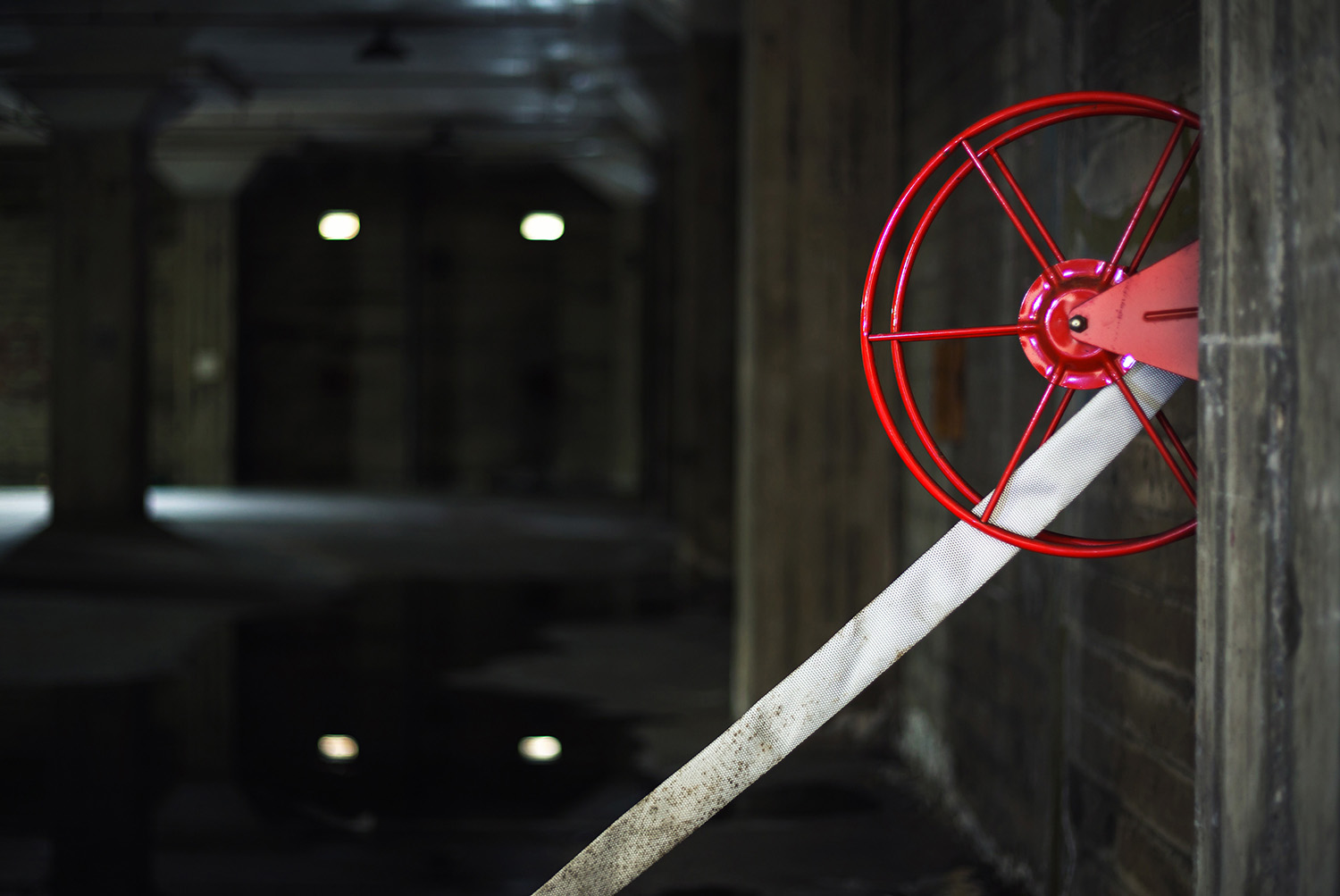
The walls all around were numbered - a diligent categorization that served a now long-forgotten purpose:
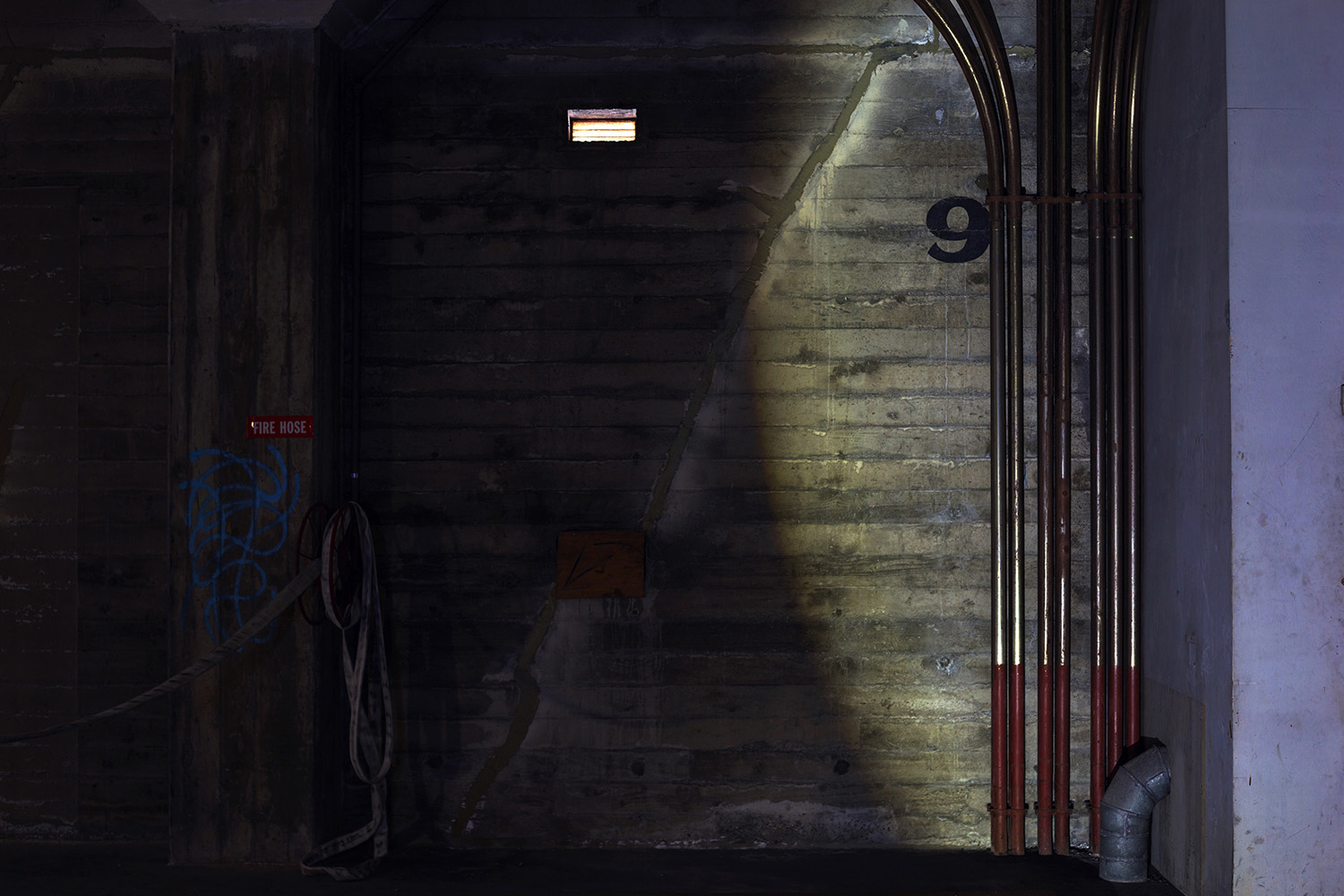
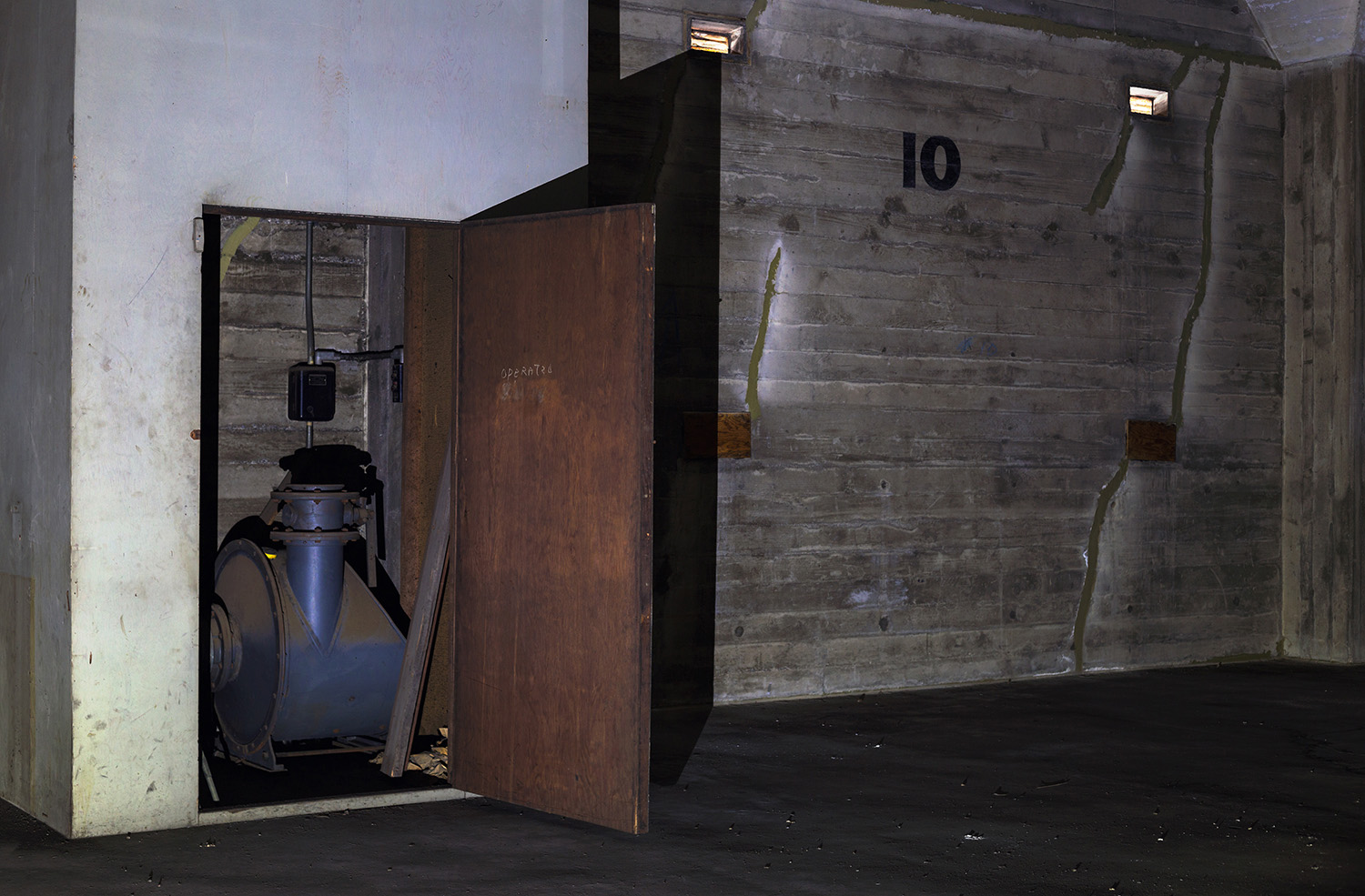
I was now on the side of the building opposite from the one I had entered. I carefully snuck through a door that led to the other main stairwell, minding my step, for the floor was fairly flooded. The birds were also beginning to make themselves known, both by the copious markings they had left on the ground and their cries echoing through the pitch-black staircase.
Making full use of my headlamp, I slowly navigated to one of the circular windows on the eastern end of the warehouse, facing the rear parking lot. A ghostly still-life installation greeted my presence:
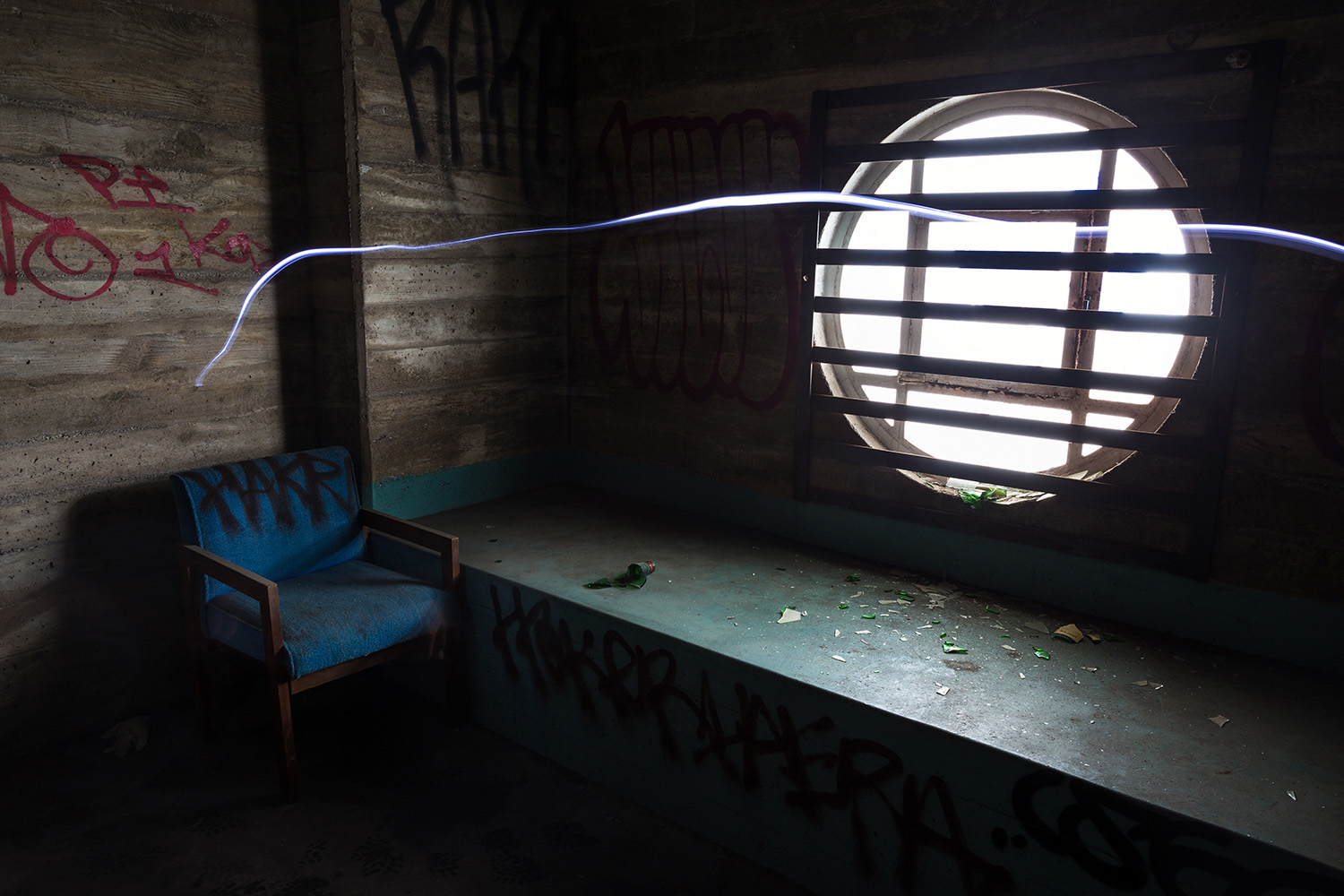
The window offered not only nice, diffused light for photographs, but also a view to the outside:
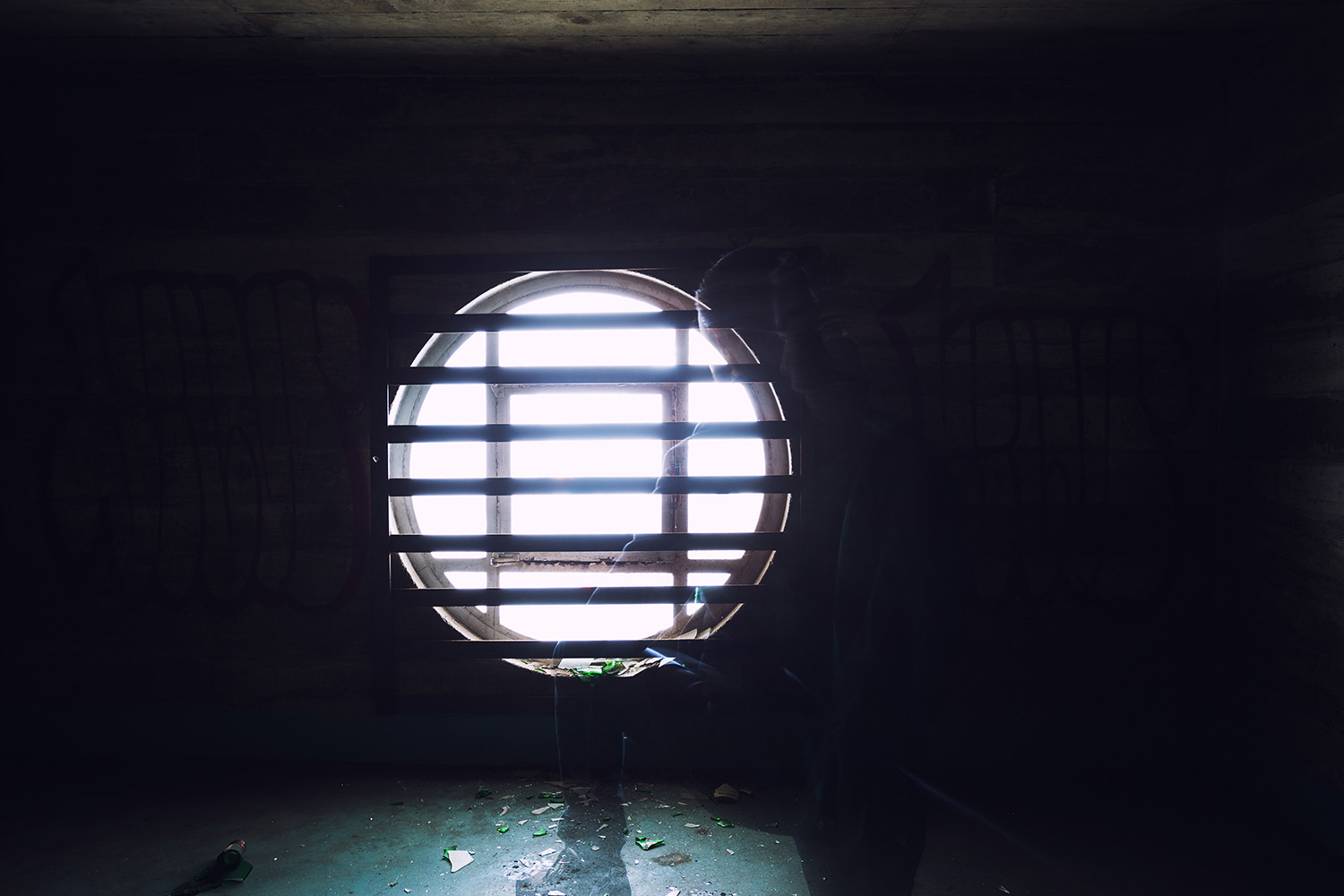
Braving the assault of the ever-increasing water and darkness, I decided to press on and see if I could climb all the way to the top. Despite the foul weather, I wanted to see if there was any chance to exit to the roof. Not only would the elevated location offer up a view of the surroundings but I was curious as to what the very top of this historic structure looked like. I climbed up on abysmally wet stairs, generously infused with bird droppings. The air was heavy with the smell and dampness of the old building.
Mercifully, it wasn't long before the darkness began to assume a grayish tint, until, it finally became evident that light was once more slowly vanquishing its presence. As I inched toward the topmost level, I began to see bright yellow electrical cables snaking up the stairwell. They were attached to light fixtures with new, power-efficient bulbs installed. There was not light, nor a way to produce it using the equipment in sight, but evidently, there was some sort of human presence here on occasion.
I continued toward the dim glow and was soon at a clearing, a sort of wooden enclosure attached to the concrete walls of the warehouse. It appeared to be part of the frame of the fourth floor roof, which, unlike the lower three, was constructed out of wood and supported by wooden posts :
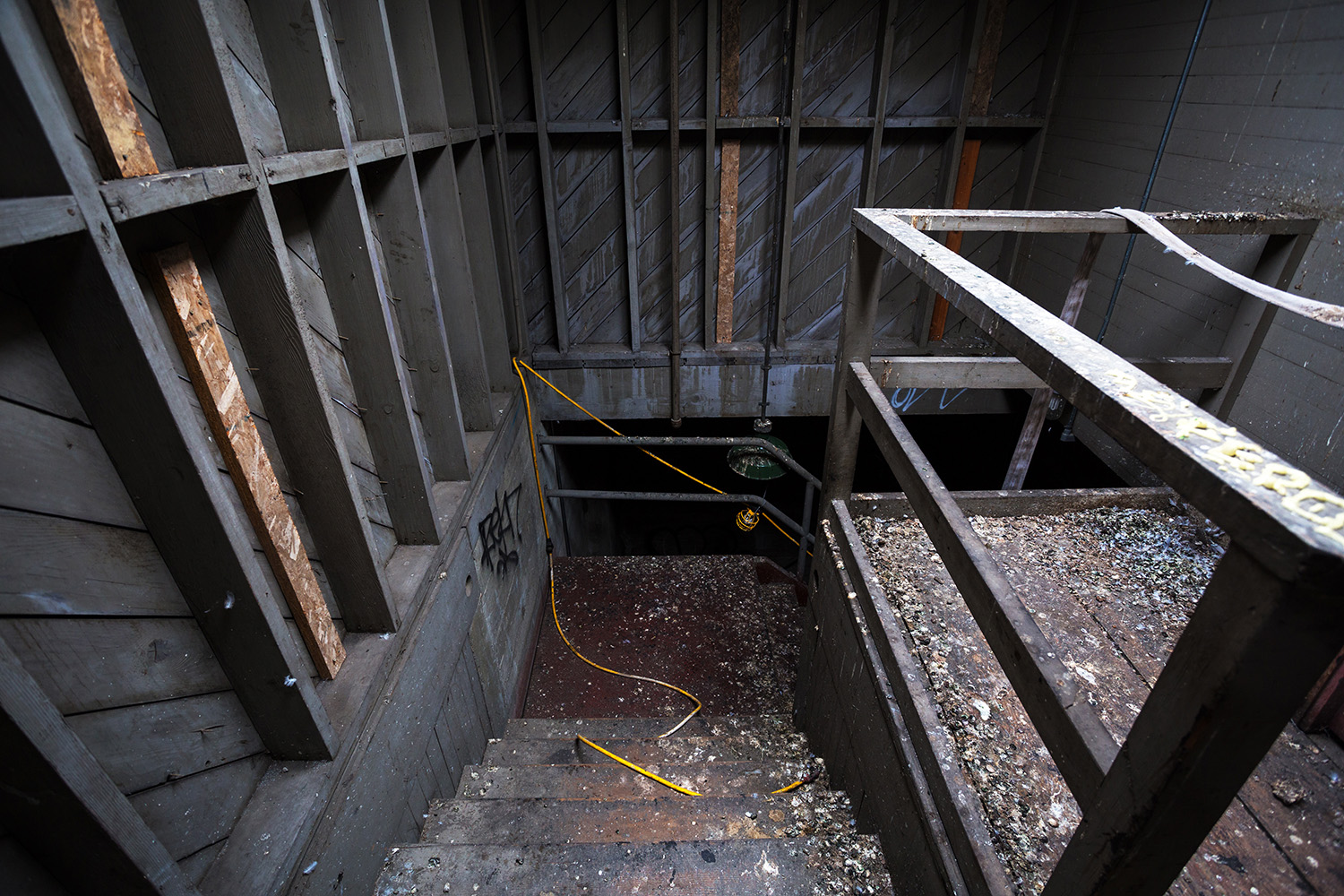
The source of light was soon revealed - another level above, a skylight illuminated my surroundings and part of the stairwell that had led me here:
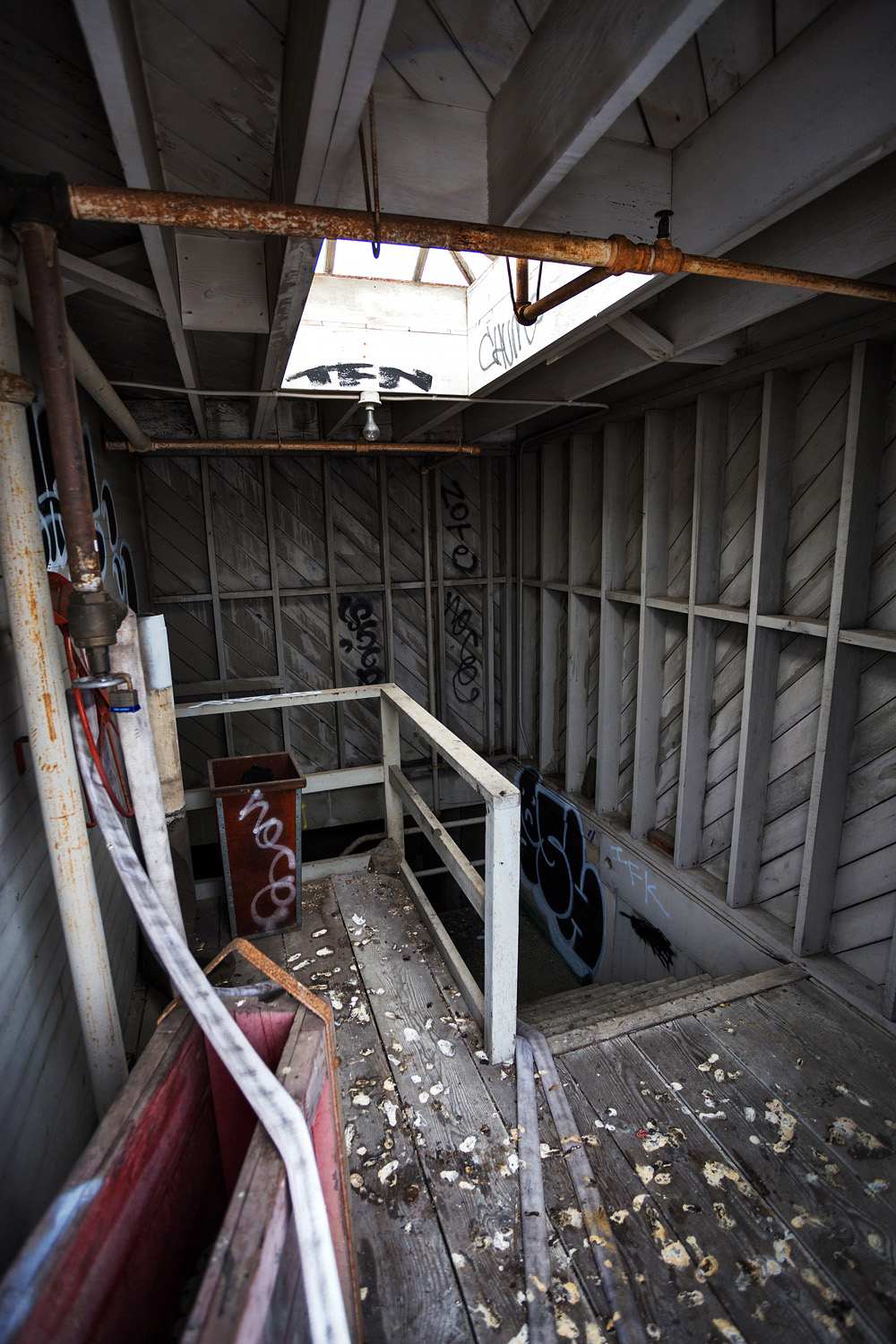
Another fire hydrant, in an equally-somber state, guarded the lonesome compartment, permanently attached to one of its walls:
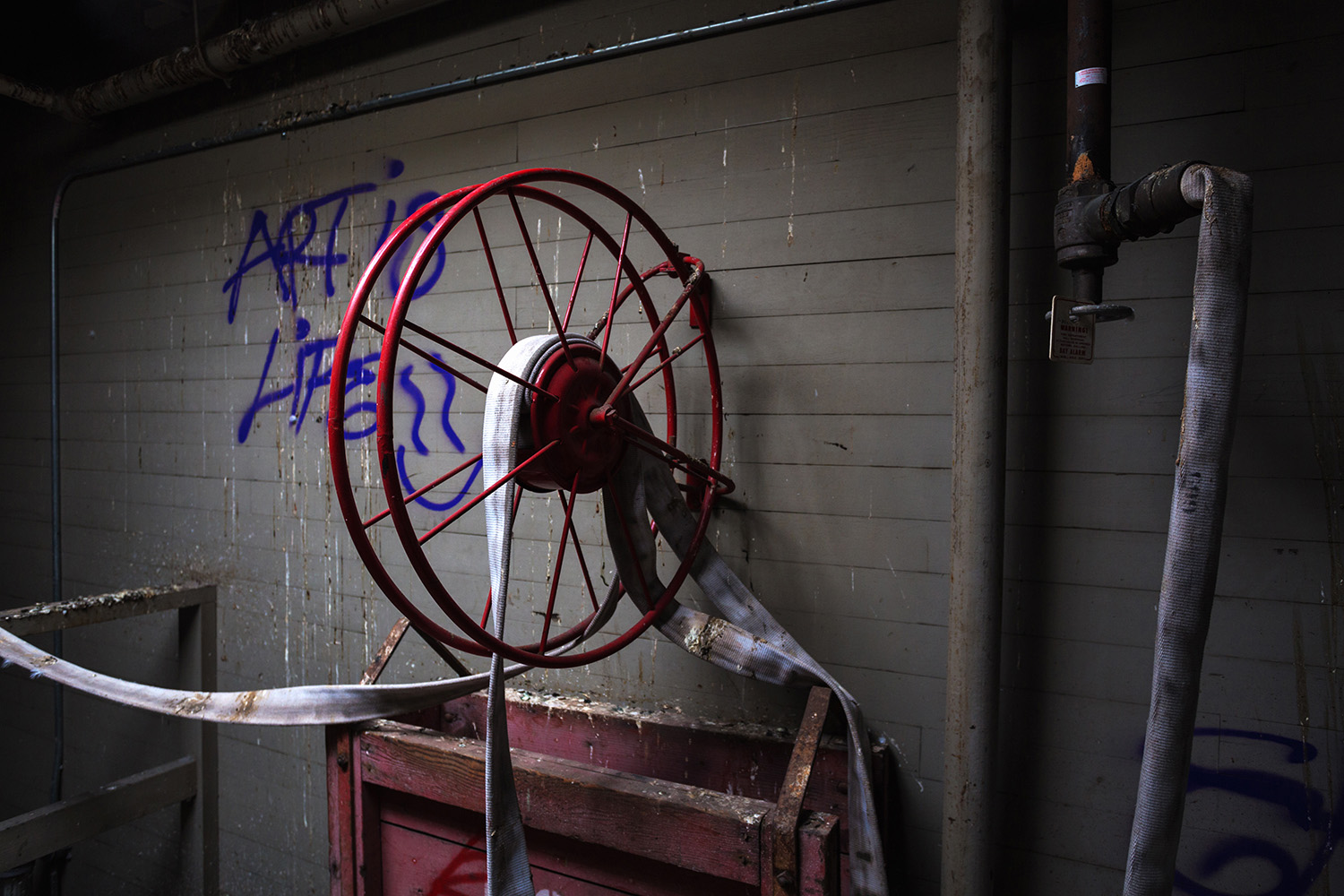
As my eye followed the unfolded tentacles of the dead fire hydrant, I began to realize that they lead to a place other than the one in which I was now standing. Extending their length, they breached the confines of the wooden shed and protruded through an opening in the structure - at last - a door!
I didn't waste time - leaving the tripod behind and tucking the camera away into my jacket in a vain attempt to shield it from the brutal rain-assault, I ventured onto the roof. Turning back, I saw the place that I had exited from:
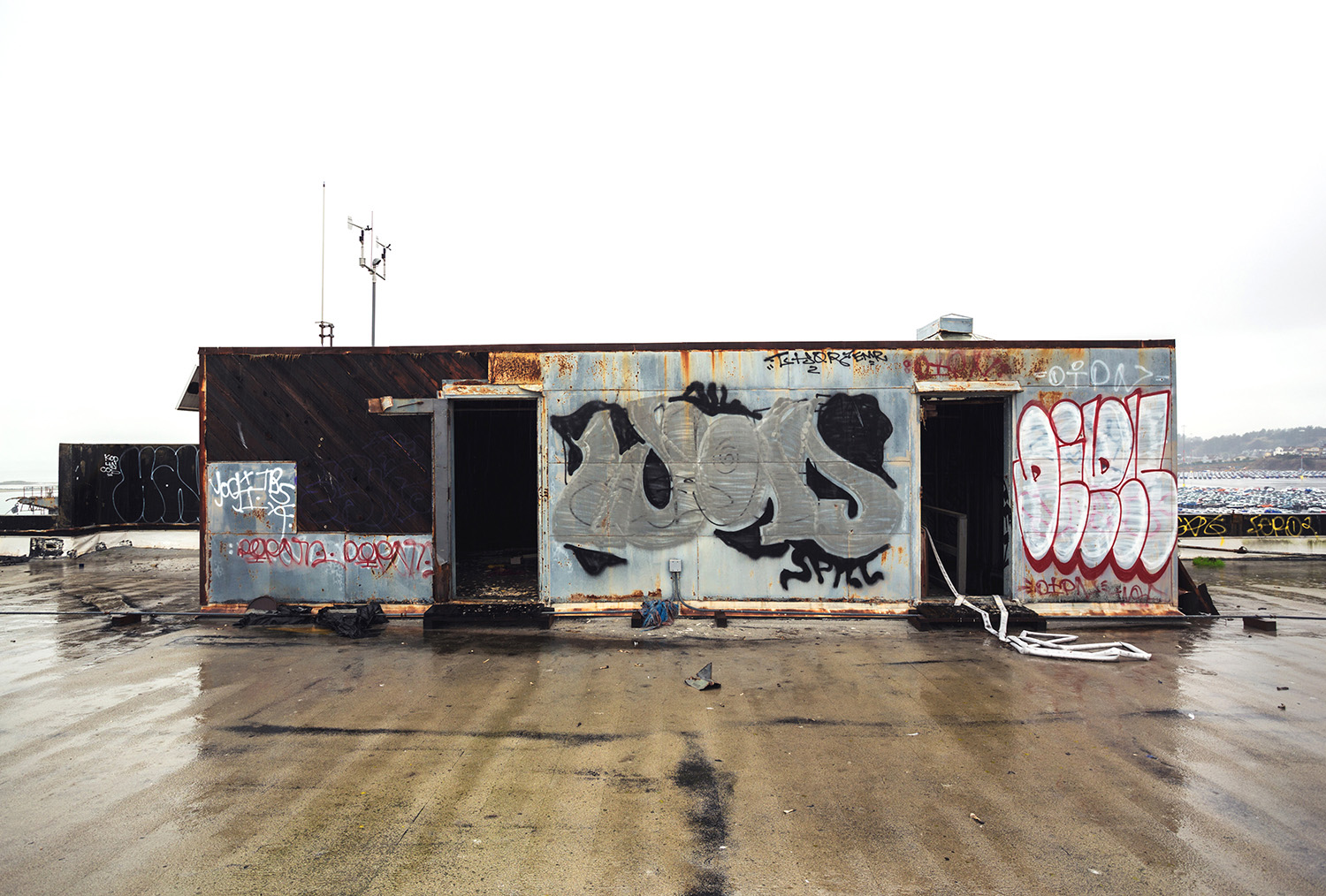
The rain and wind were unrelenting. I could see the enormous NYK Lines cargo ship to one side of the warehouse and the nearby hills on the other, but despite my interest I knew I couldn't stay long. I ran to one side of the roof to check out the view and get an overall shot or two. The termini of the two main stairwells protruded on either side of the structure, a seagull sentry posted on each:
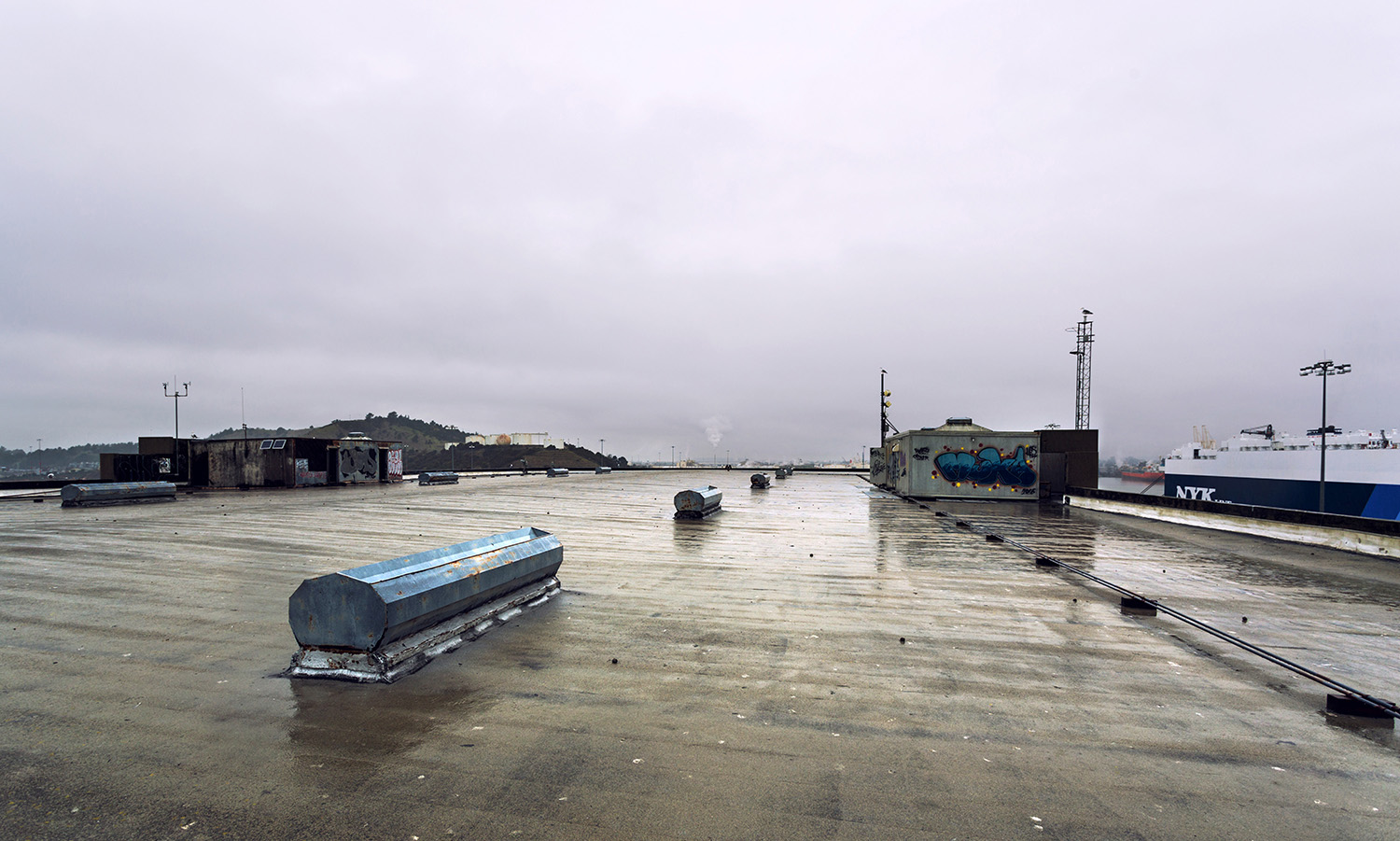
Directly behind me lay the bay's edge and the end of Shipyard Number Three. The yards' lone surviving whirley crane stood off to the right:
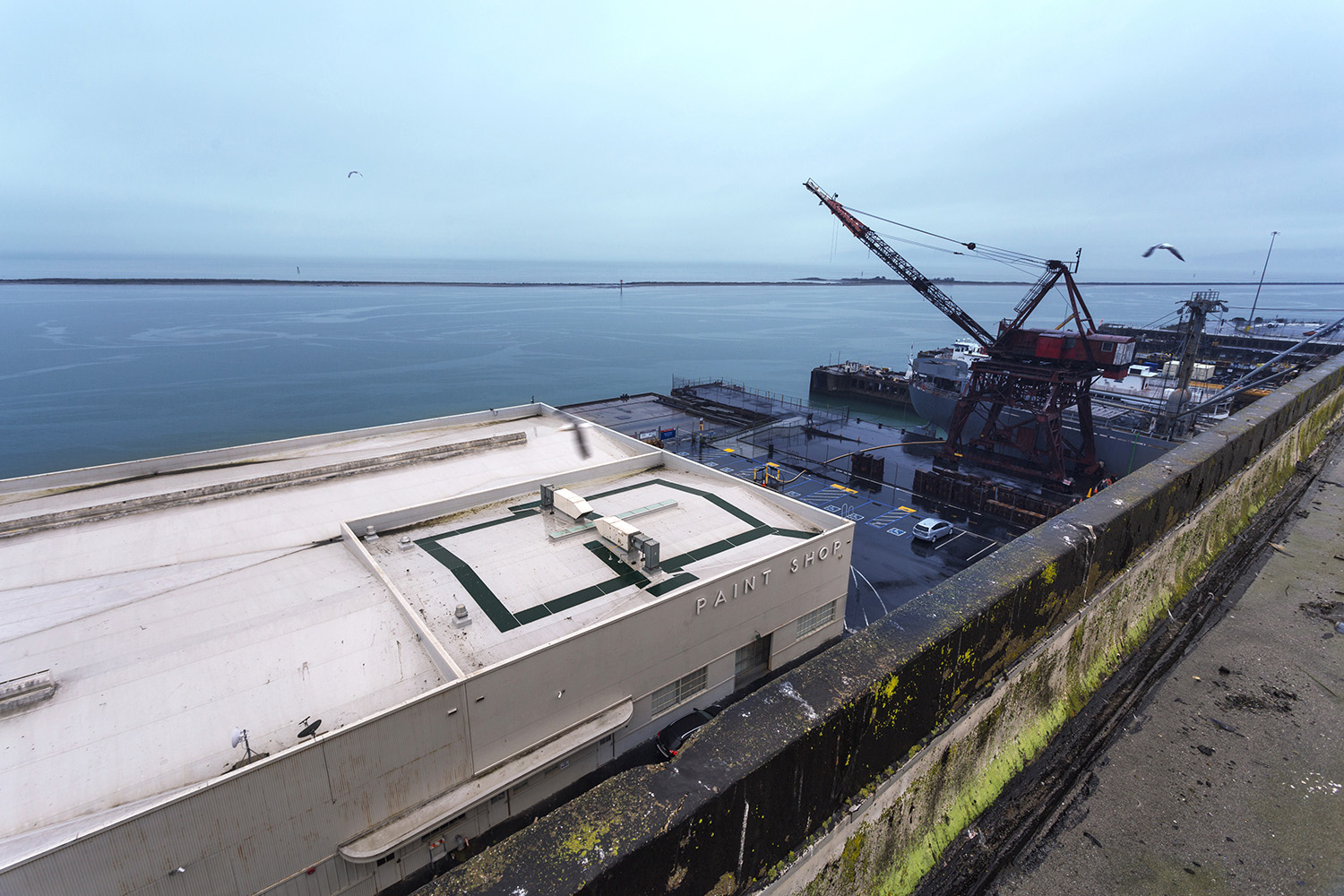
And to the left, Harvest Leader dwarfed all presence around it, resting unperturbed in the falling rain:
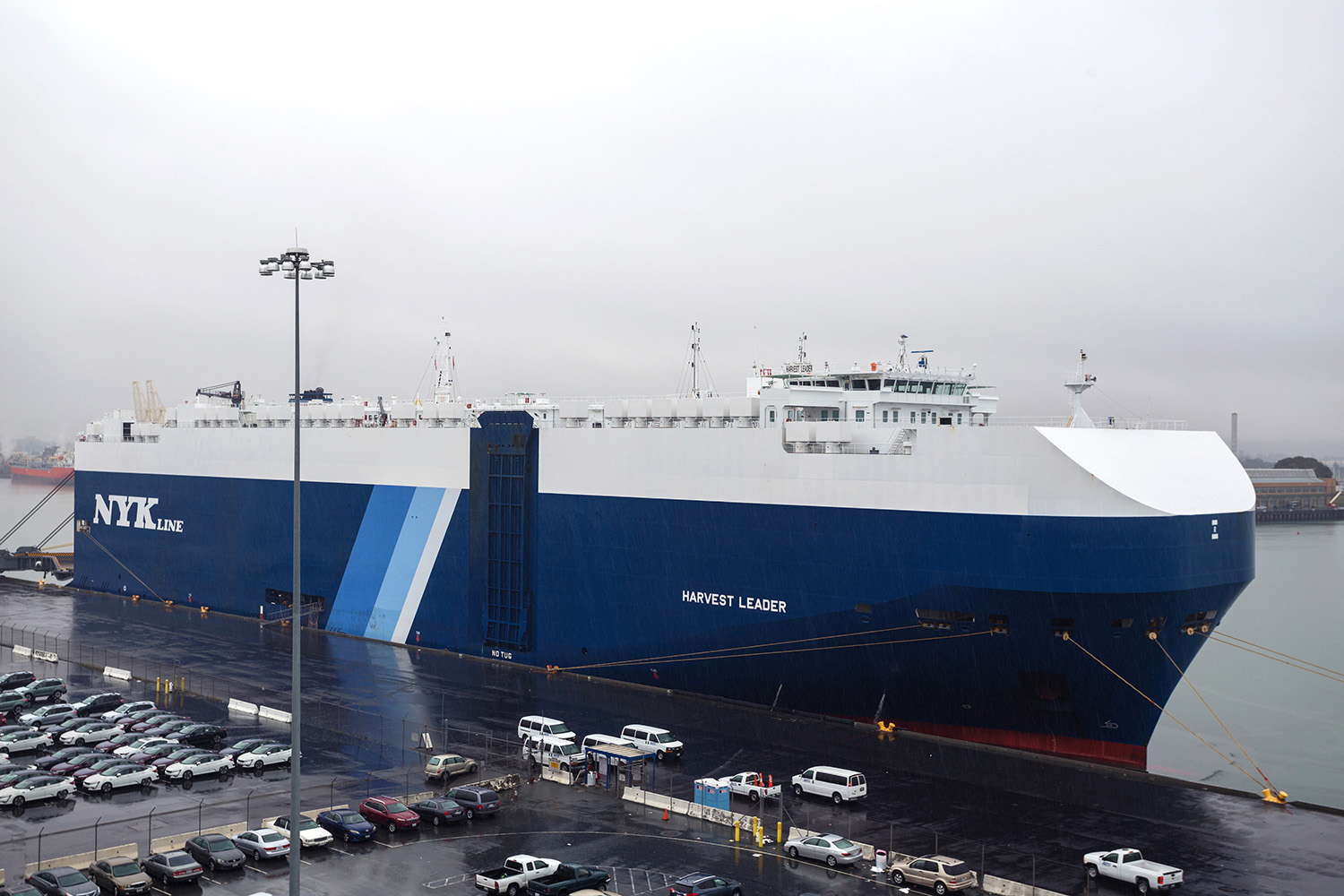
I was fairly soaked, though. Under different circumstances, I could have easily spent an hour on the roof alone, but the weather was beginning to permeate both my clothing and my photographic equipment, neither of which would be of much use to me waterlogged.
I headed inside to shake the water off myself and dry the camera as best I could. Afterwards, I descended the stairs once more, to see what I could find on the topmost floors that I had not yet visited. I soon noticed an epic shadow play on one of the round windows, with a strategically-placed pigeon completing the scene:
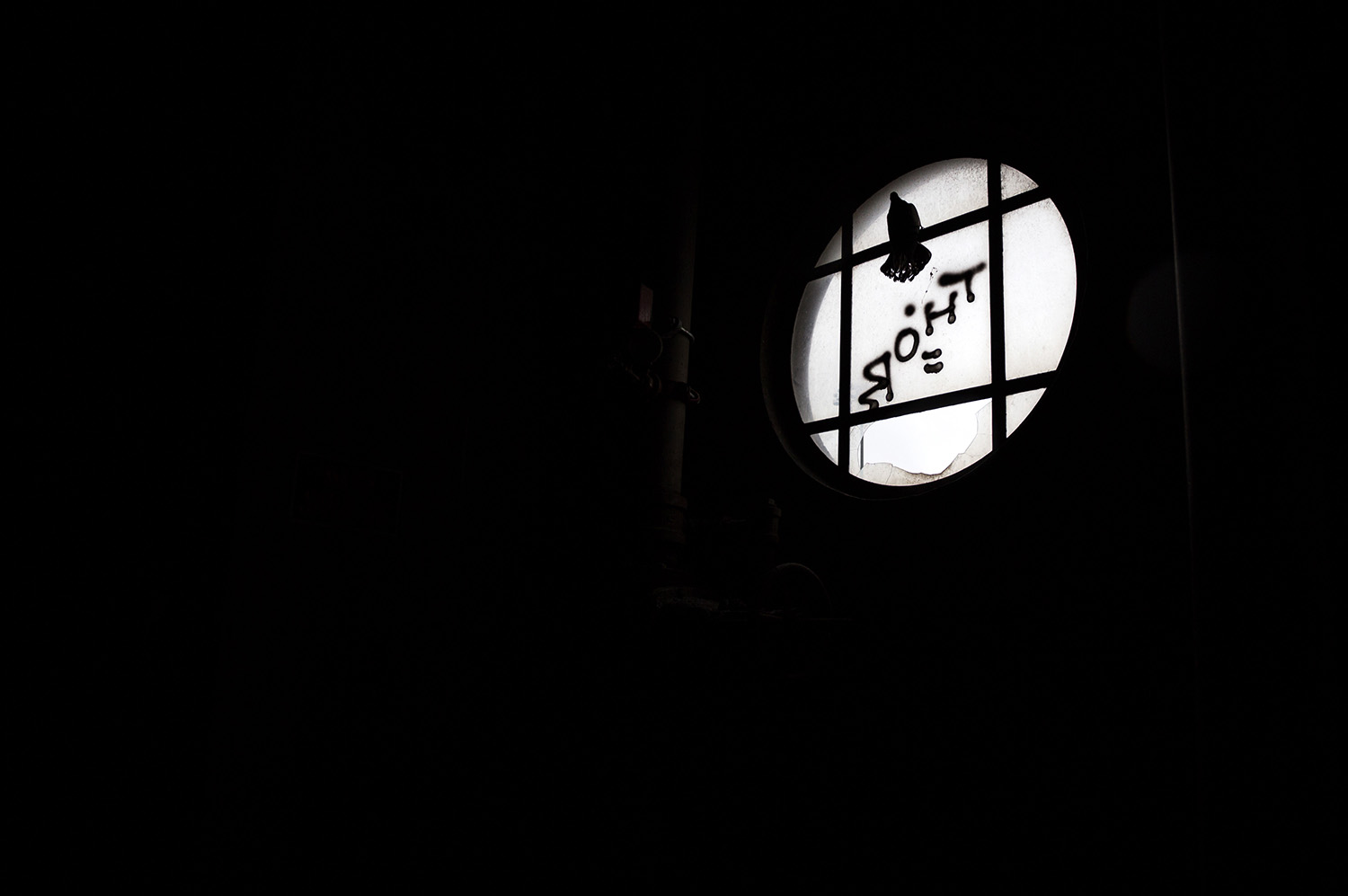
I was now on floor four. Once again, there was a presence of light, dimly making itself known. I soon discovered its origin - a separate wooden compartment constructed within the concrete shell of the outer building, featuring two levels. It was well-lit by two fluorescent light fixtures:
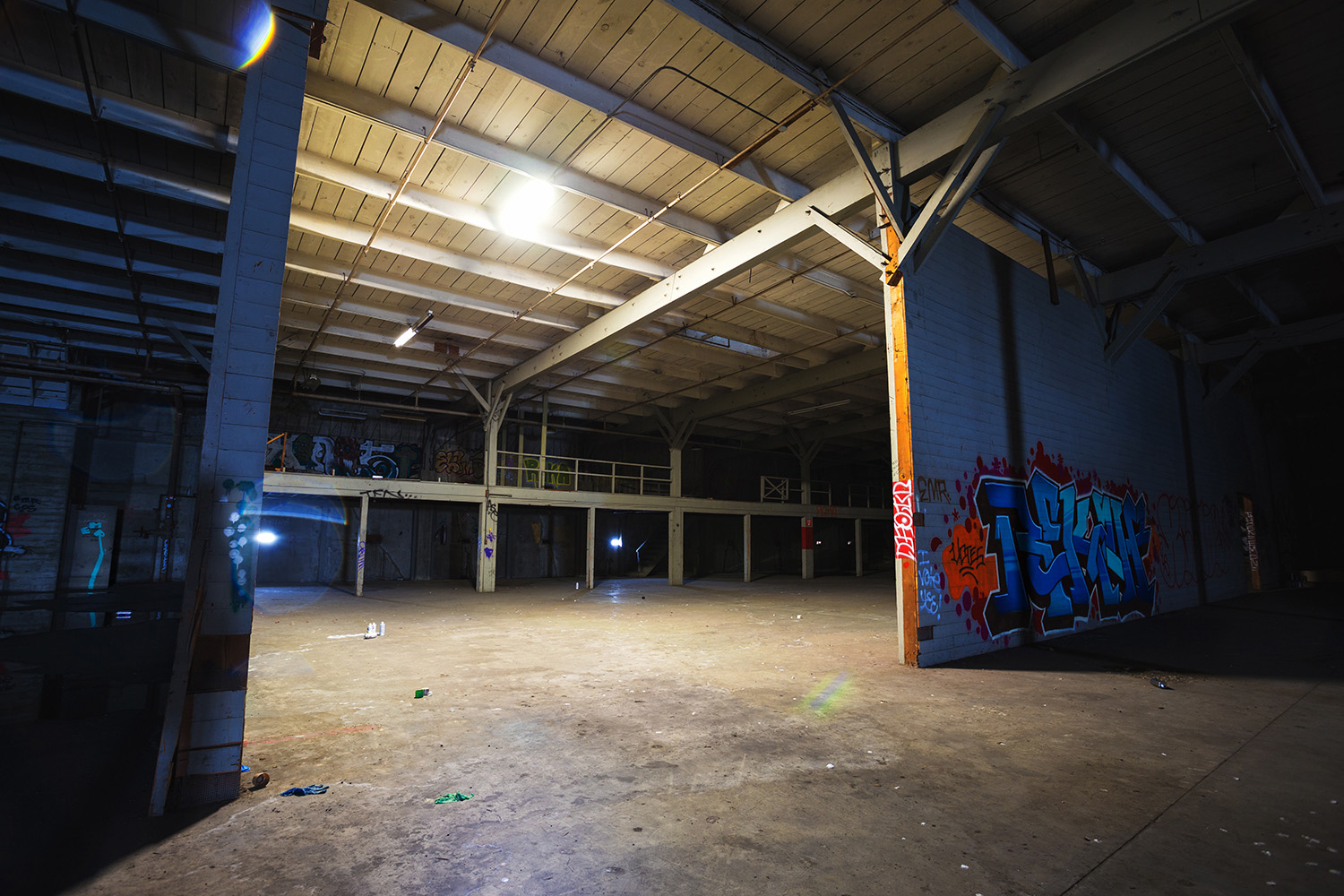

An old ladder rested against a graffiti-filled wall - an uneasy coexistence of two different generations:
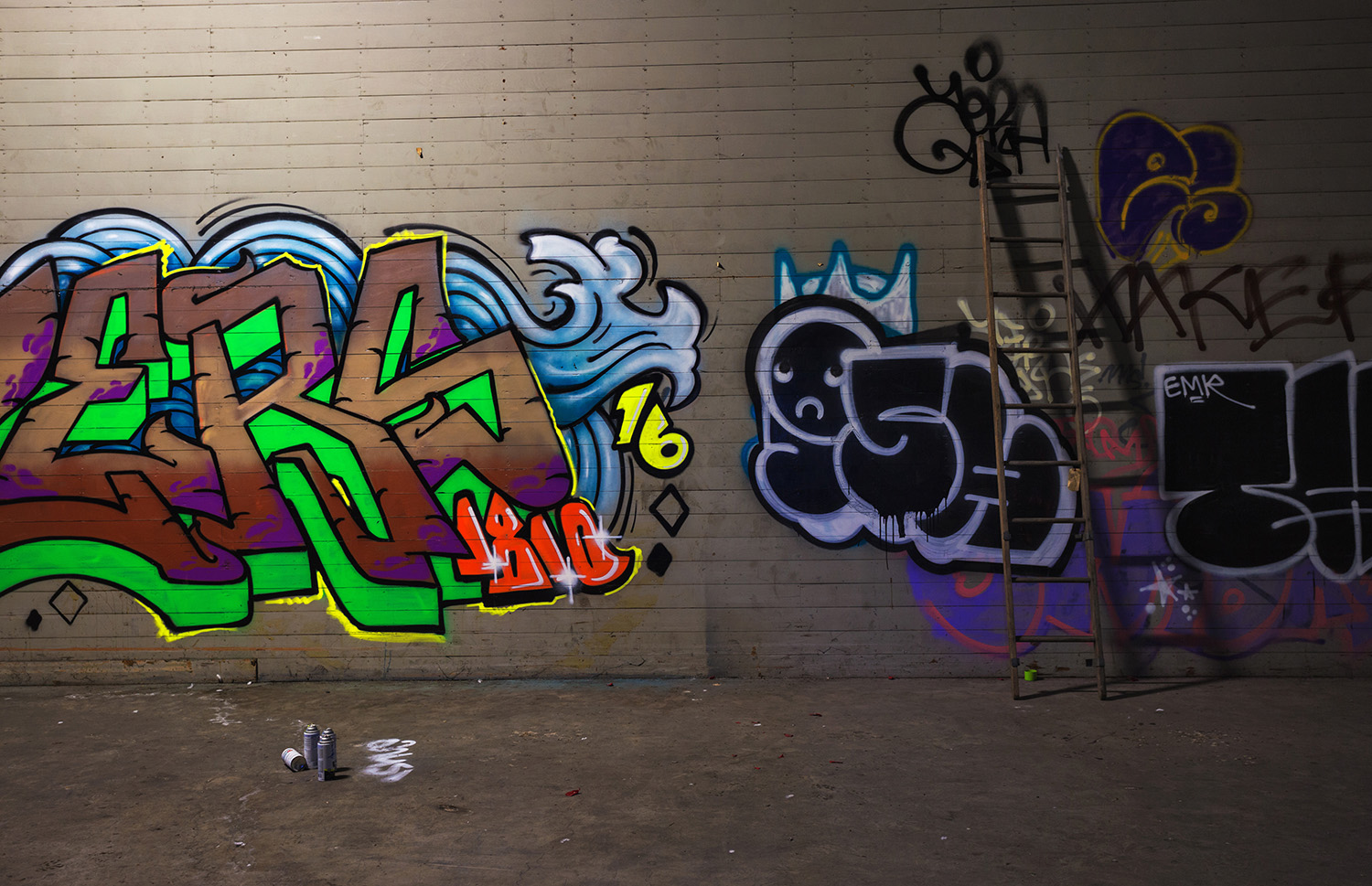
I did not see anything of interest on the second level of the wooden structure, so I headed back out into the semi-darkness to see what else I can find on level four. The wooden roof and supporting post construction, different from the first three floors, was evident in this space:

Not encountering anything but open space on floor four, I descended down one level. On the third floor, I came upon a door leading into what seemed like another secondary compartment built-out on the far left side of the warehouse. It had the look of a meat-locker and a shiny, metal door with not one, but two locks attached:
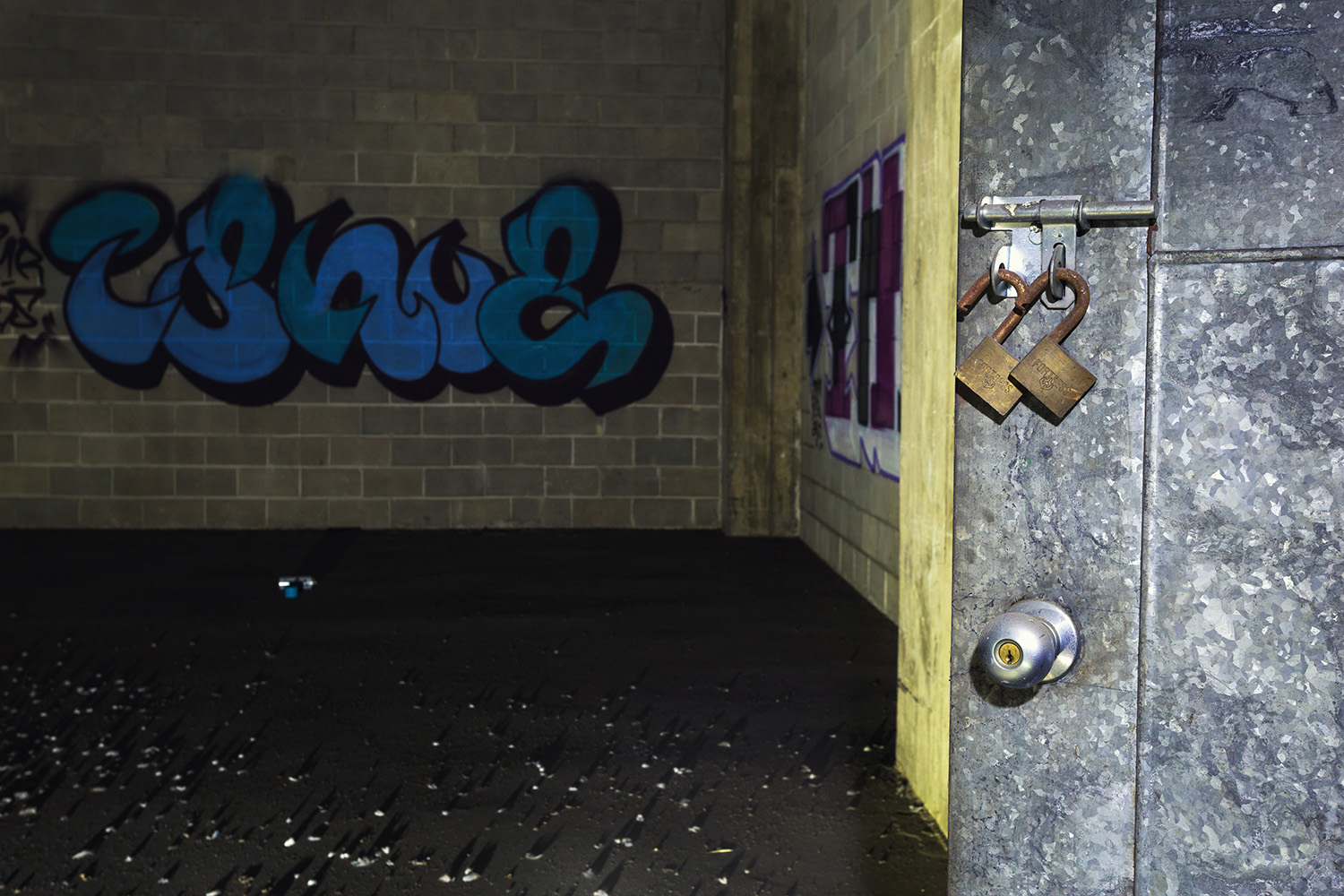
The interior of the space itself was unremarkable, but one of the slit vents in the wall offered an interesting view toward the adjacent Machine Shop building - also an original period piece from The War - now part of the Port of Richmond Auto Facilities. With the rain and smoke in the background, this made for an interesting point of view:
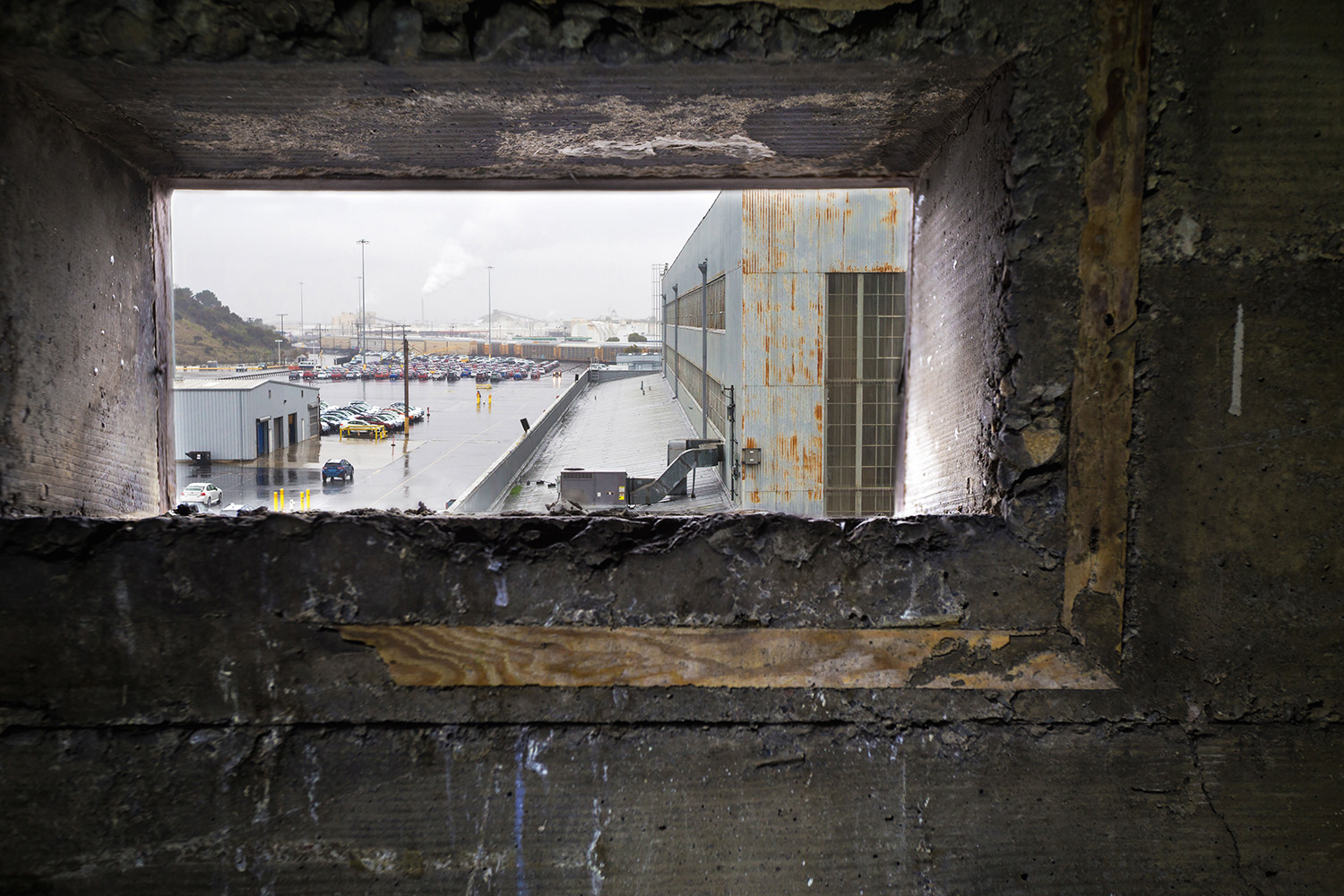
There was not much more to see here, but a lonely "No Smoking" sign hanging right outside the door had the look and feeling of another era:
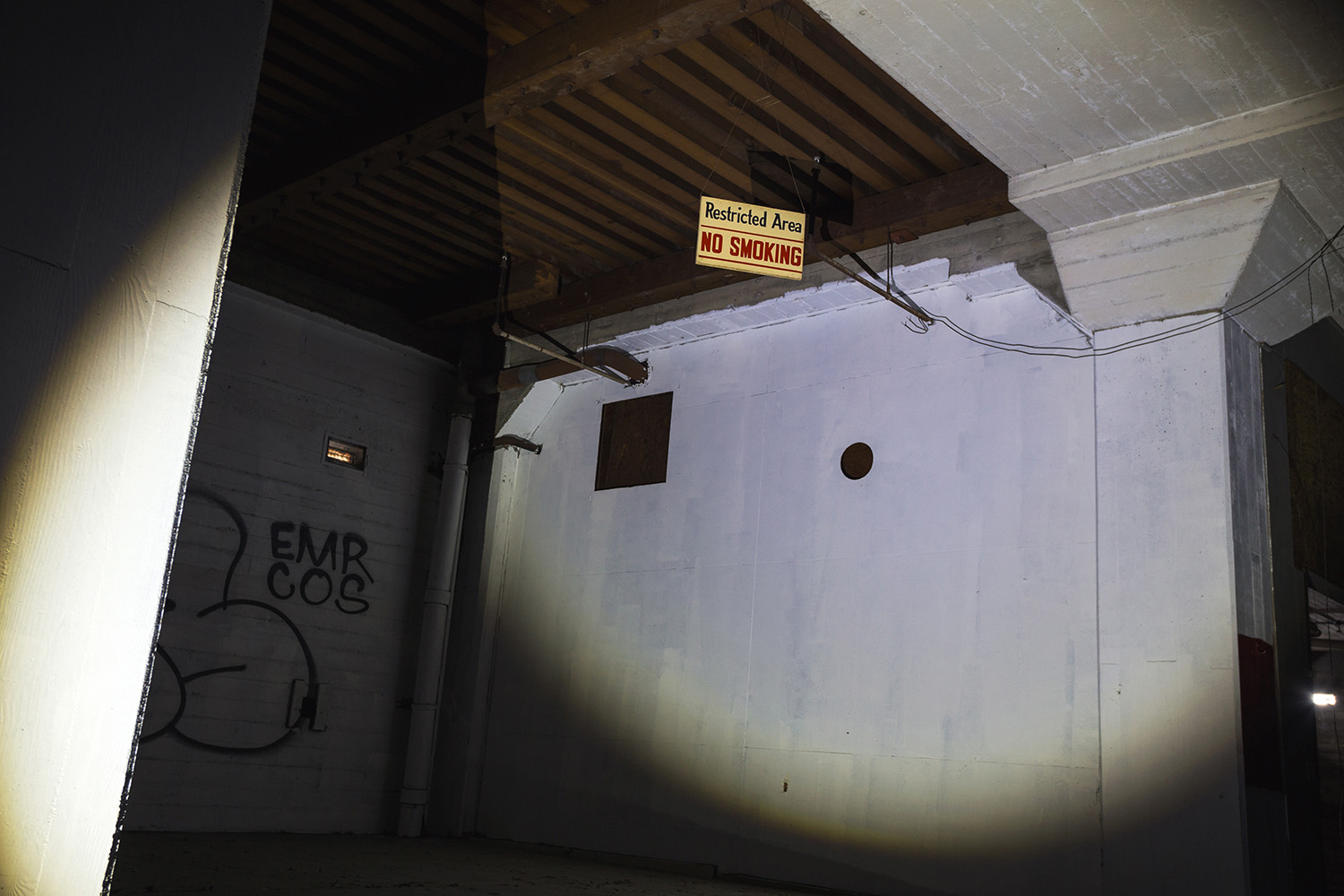
No sooner had I turned away from the once-restricted area than I set eyes on the dim silhouettes discernible on the eastern wall. This particular spot was once again marked by doors - I had found the restrooms. Or so I thought. As it turned out, these were only the ladies' facilities, housed in a wooden enclosure of sorts:
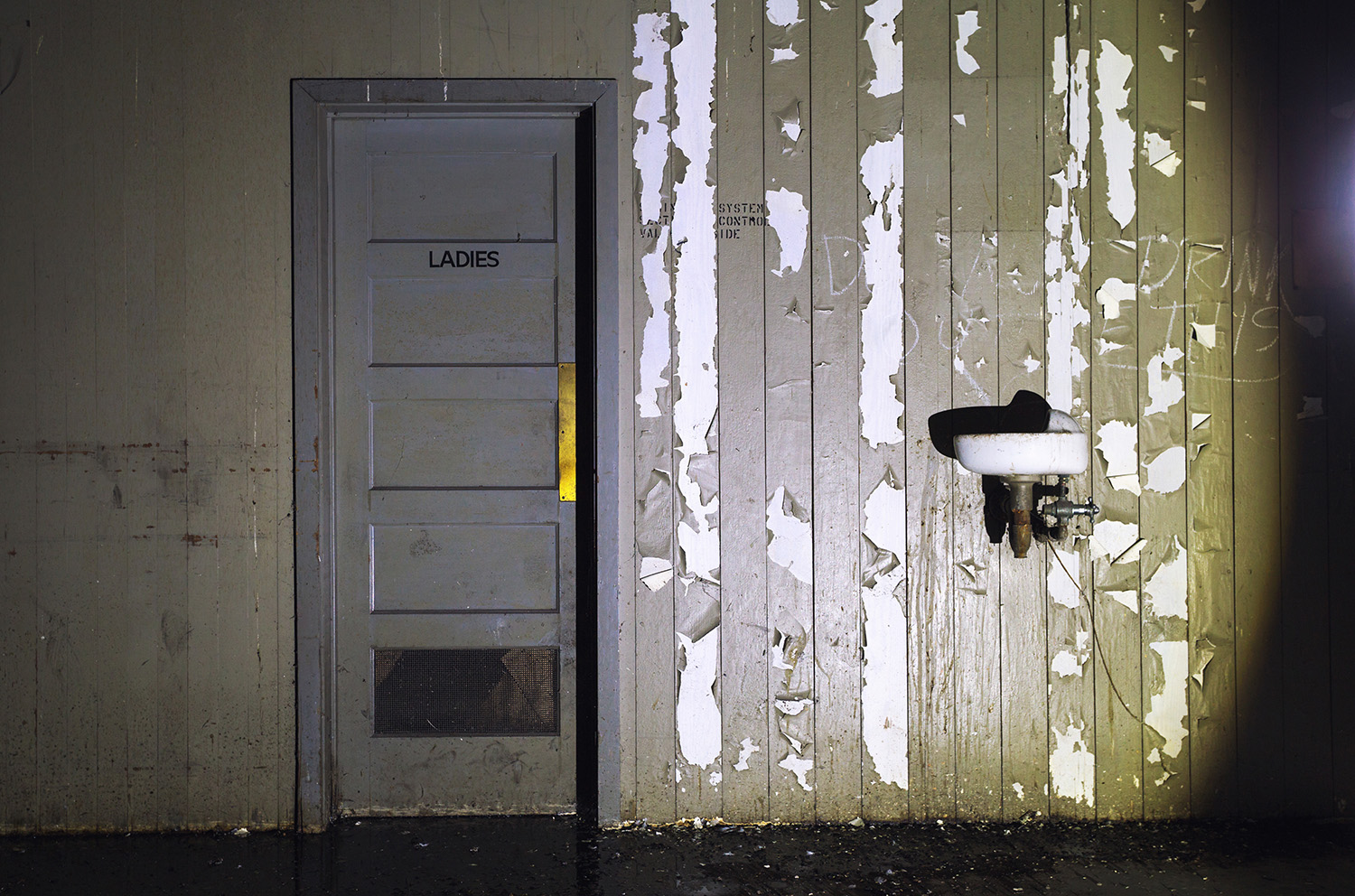
The inside of the ladies' room offered some interesting content as well:
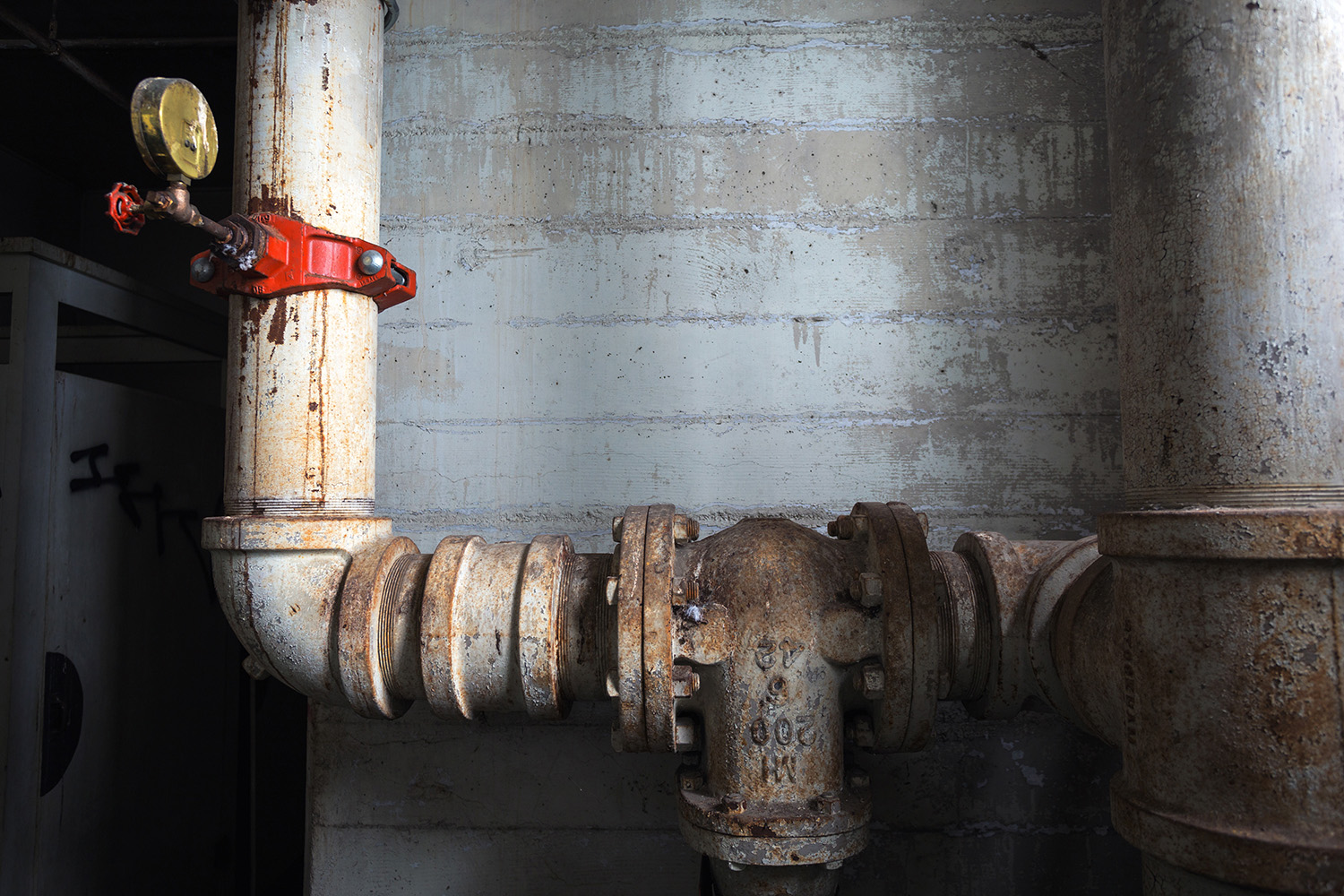
Evidently, this is where system control took place:
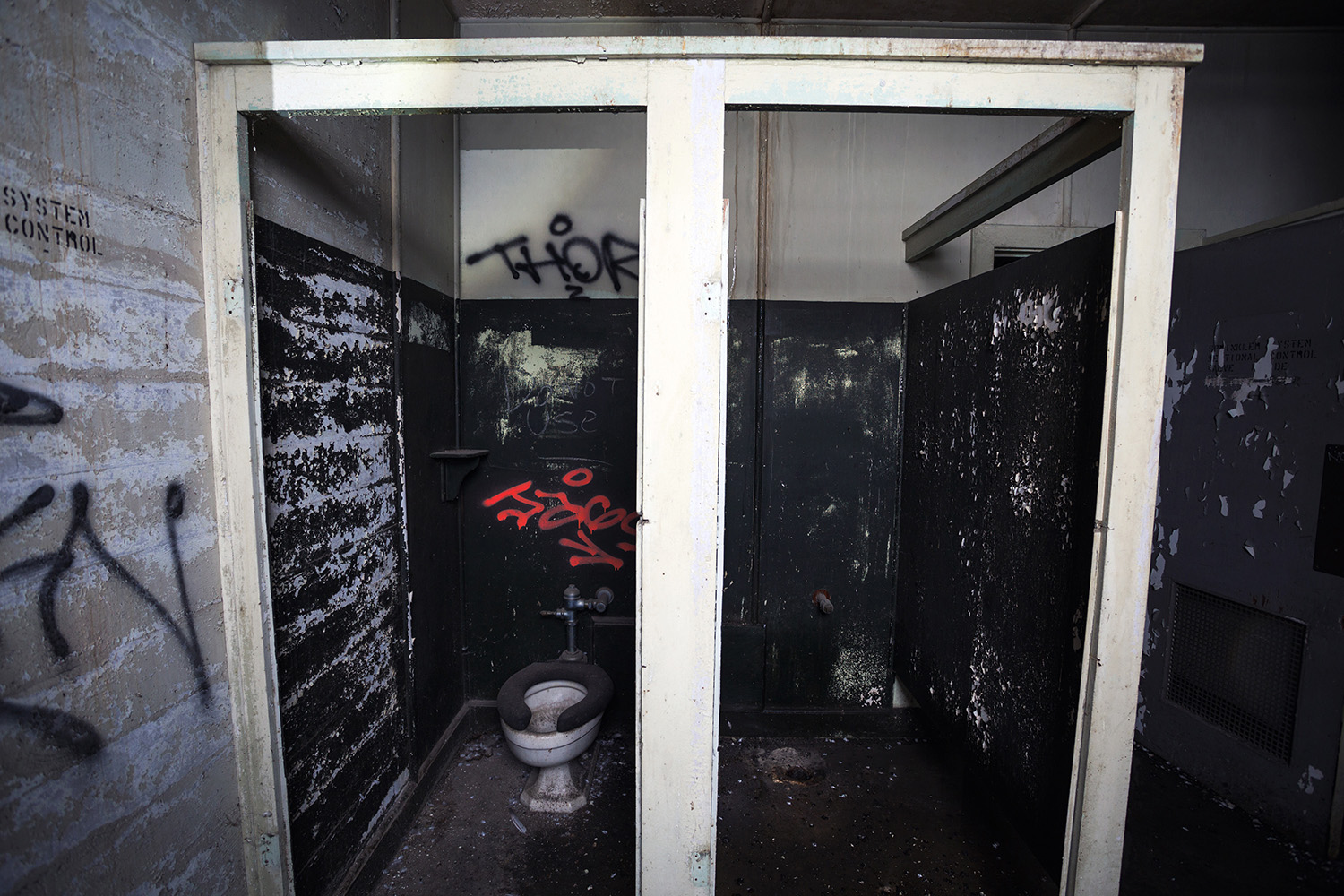
An old paper dispenser, keeping company with the bathroom's circular window, presented a picture of loneliness and decay:
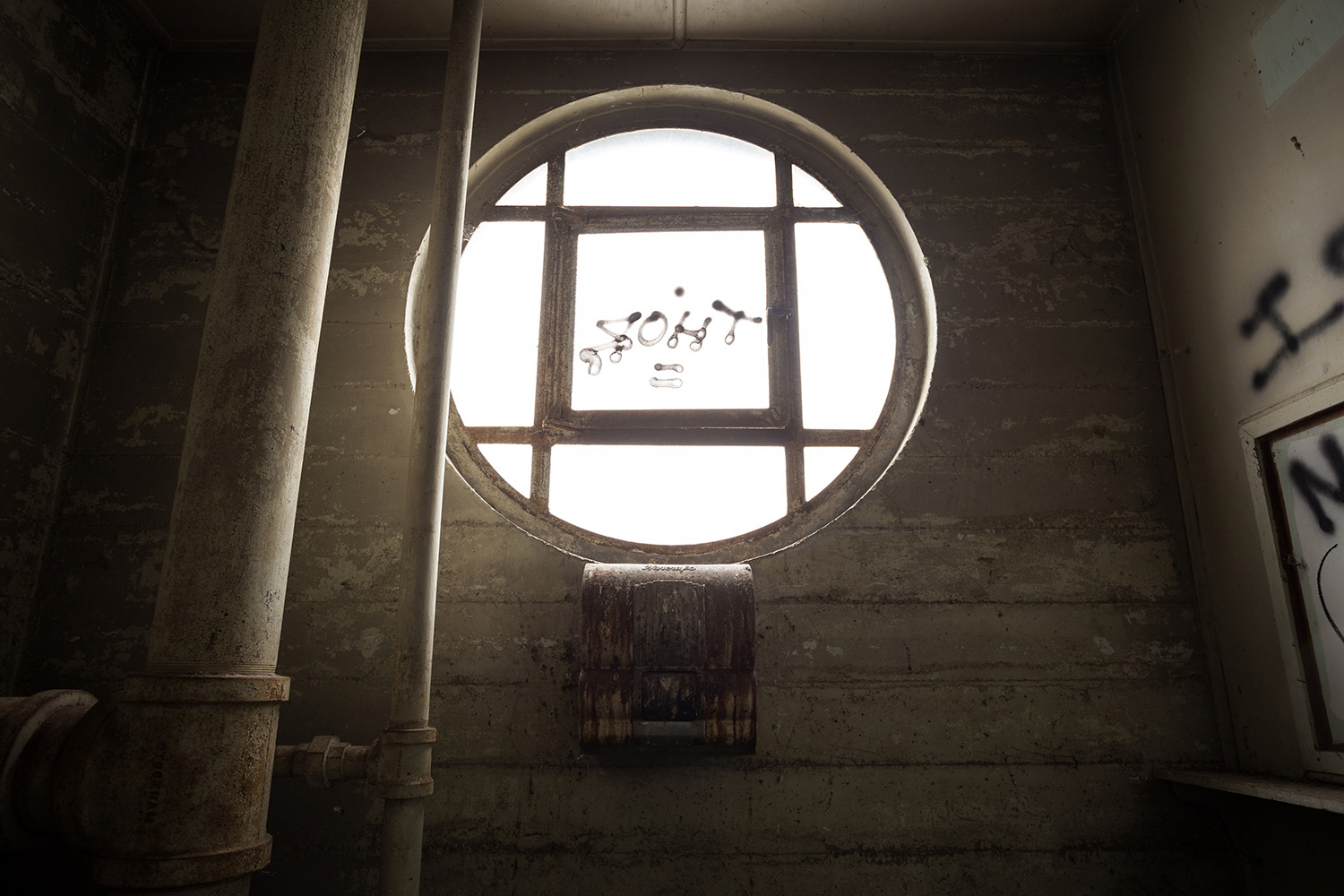
Near the restroom facilities, I also came face-to-face with the smaller passenger elevator that once operated on the premises, for the first time:
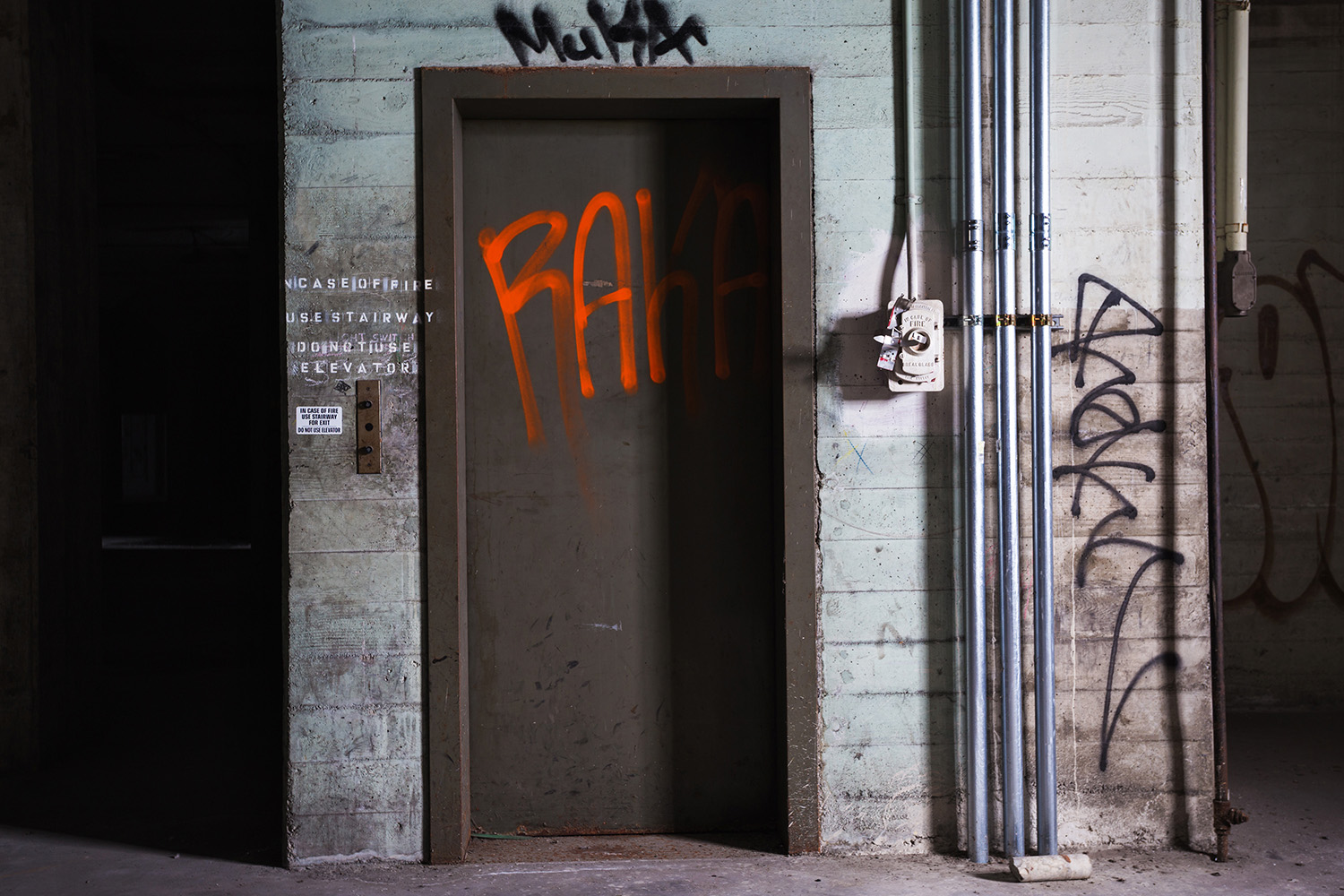
In close proximity, its larger sibling kept vigil over the antiquated remains of a once productive and alive floor number three:
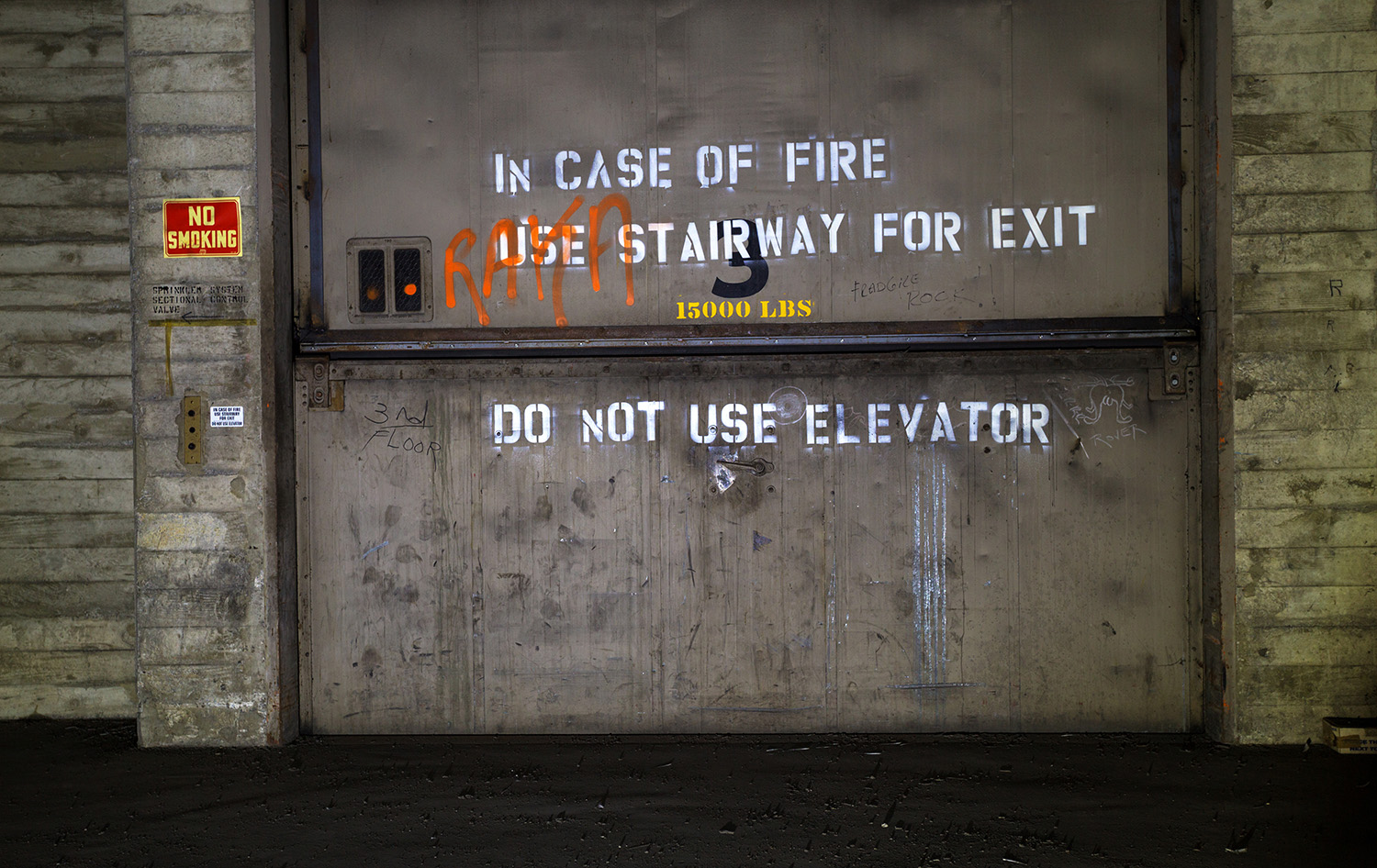
Doors were certainly a recurring theme. This one, with its unconvincing warnings and vintage typeset was going to lead me back down to base level. For it had been nearly four hours since I had entered the infamous warehouse and I had not felt the time pass. But I was beginning to feel the physical and mental weariness of exploring and concentrating for such an extended period and it was time to head back to ground level:
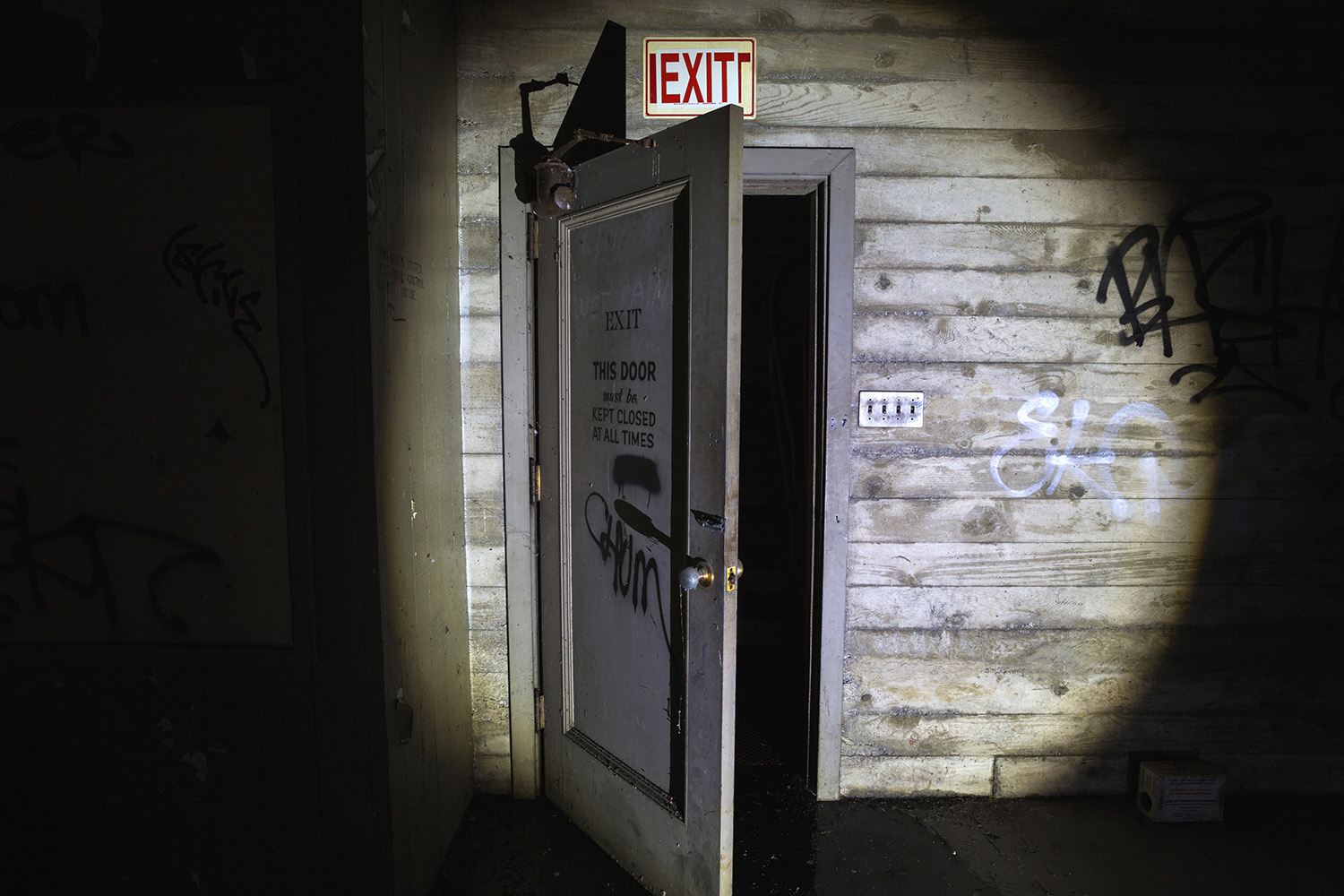
I wanted to finish off the day by re-visiting the ground floor and taking a few photos in the office spaces next to the entrance that I had neglected on my way in. An old Nitsuko America desktop computer (complete with paper user manual contained in the folder right below it) and a dead-looking office chair greeted me as I made my way back into the sarcophagus:
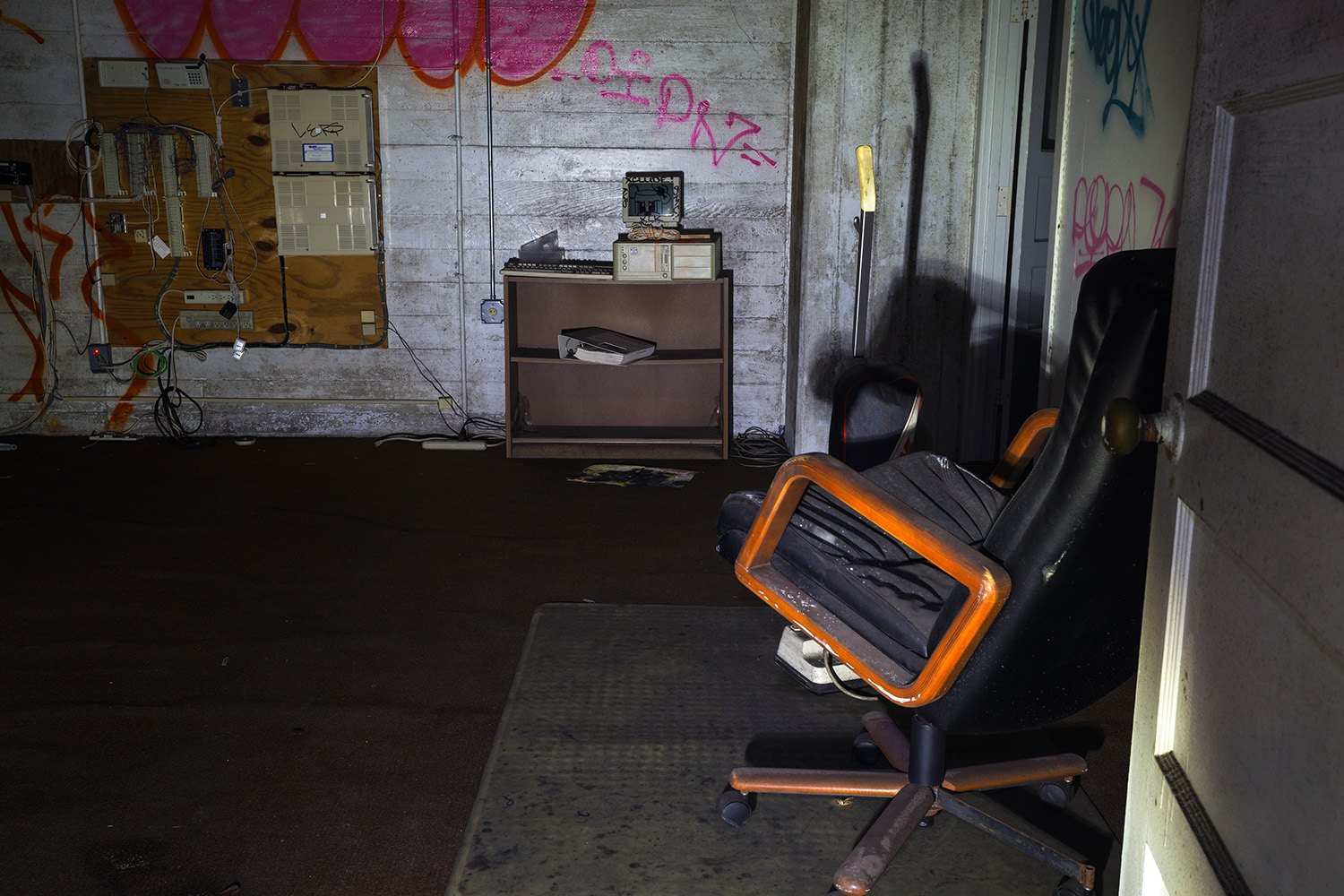
It would appear this one was the network room, so to speak. A dedicated wall space featuring phone jacks, punch down blocks and various electrical connections all testified to its purpose:
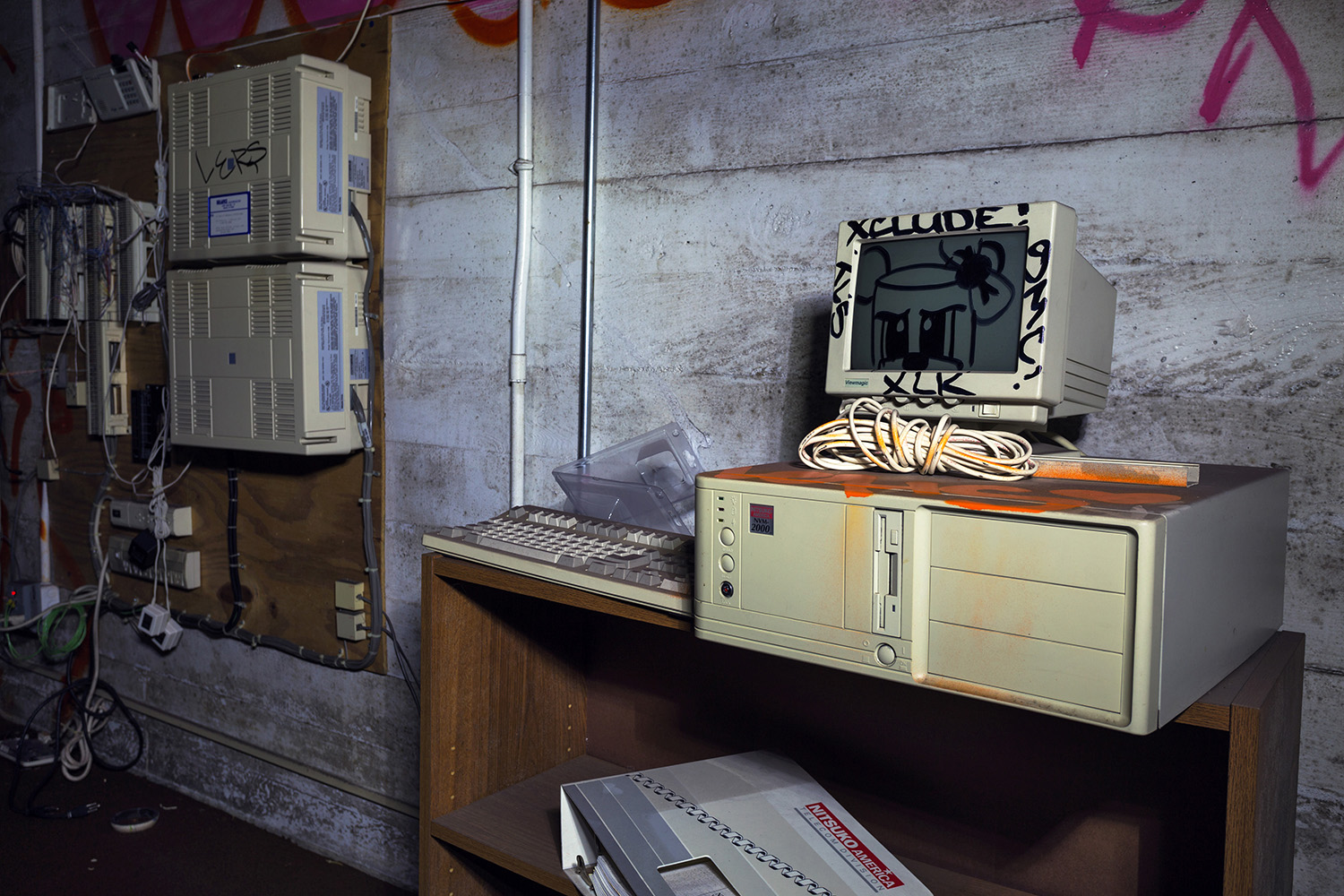
Looking around, I noticed a TNT Reddaway Truck Line calendar still plastered on a nearby wall. According to its display, time here had stood still since the year 1995:
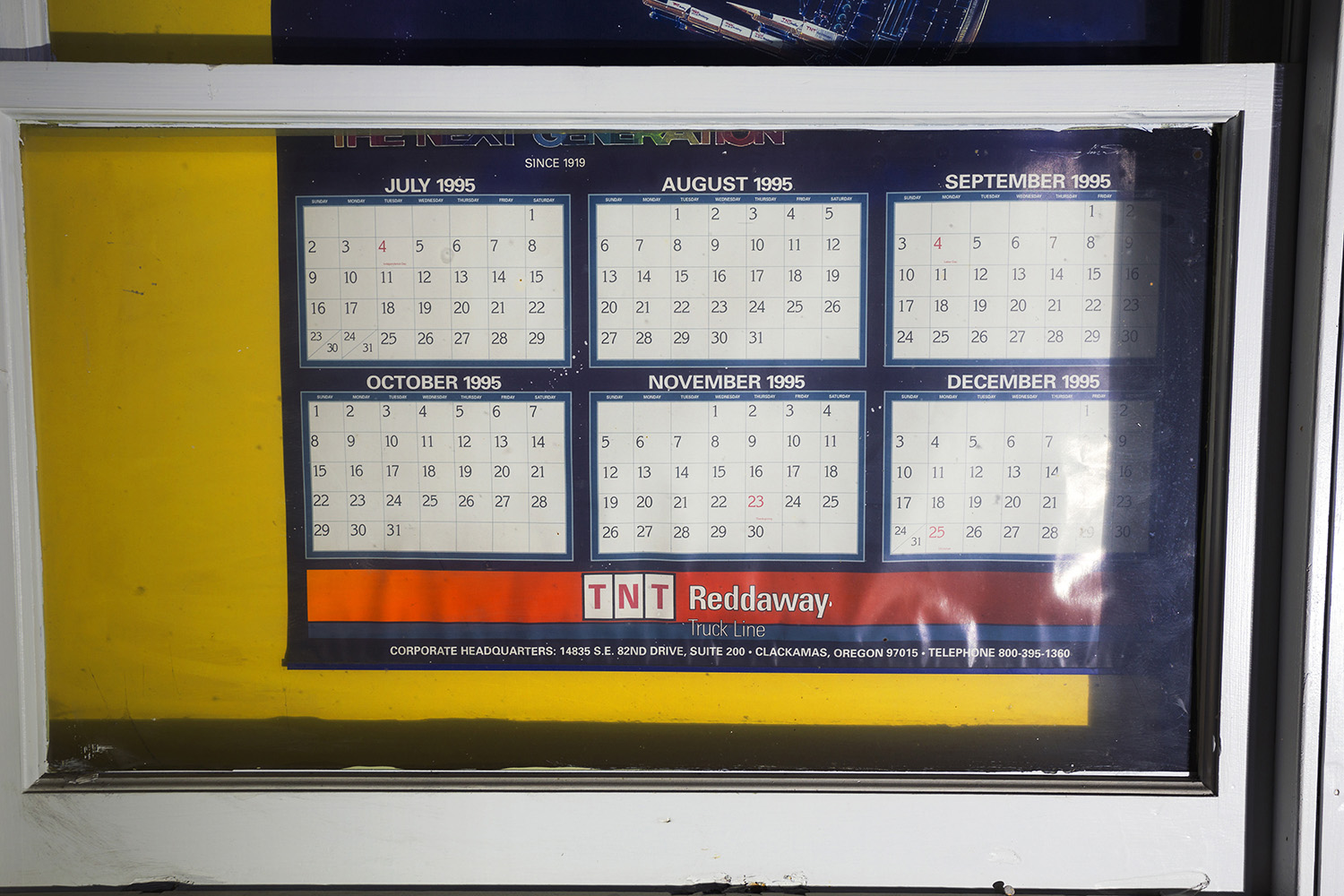
In a hurry on the way in, I had neglected to notice that there was a second "floor" to the office section - it was accessible by an external wooden staircase. I climbed up to take a look around. As below, so above - the office tunnel on the second level also ran the entire width of the first floor. On my way to the other wall, I passed by three windows that looked straight out of the World War II era:
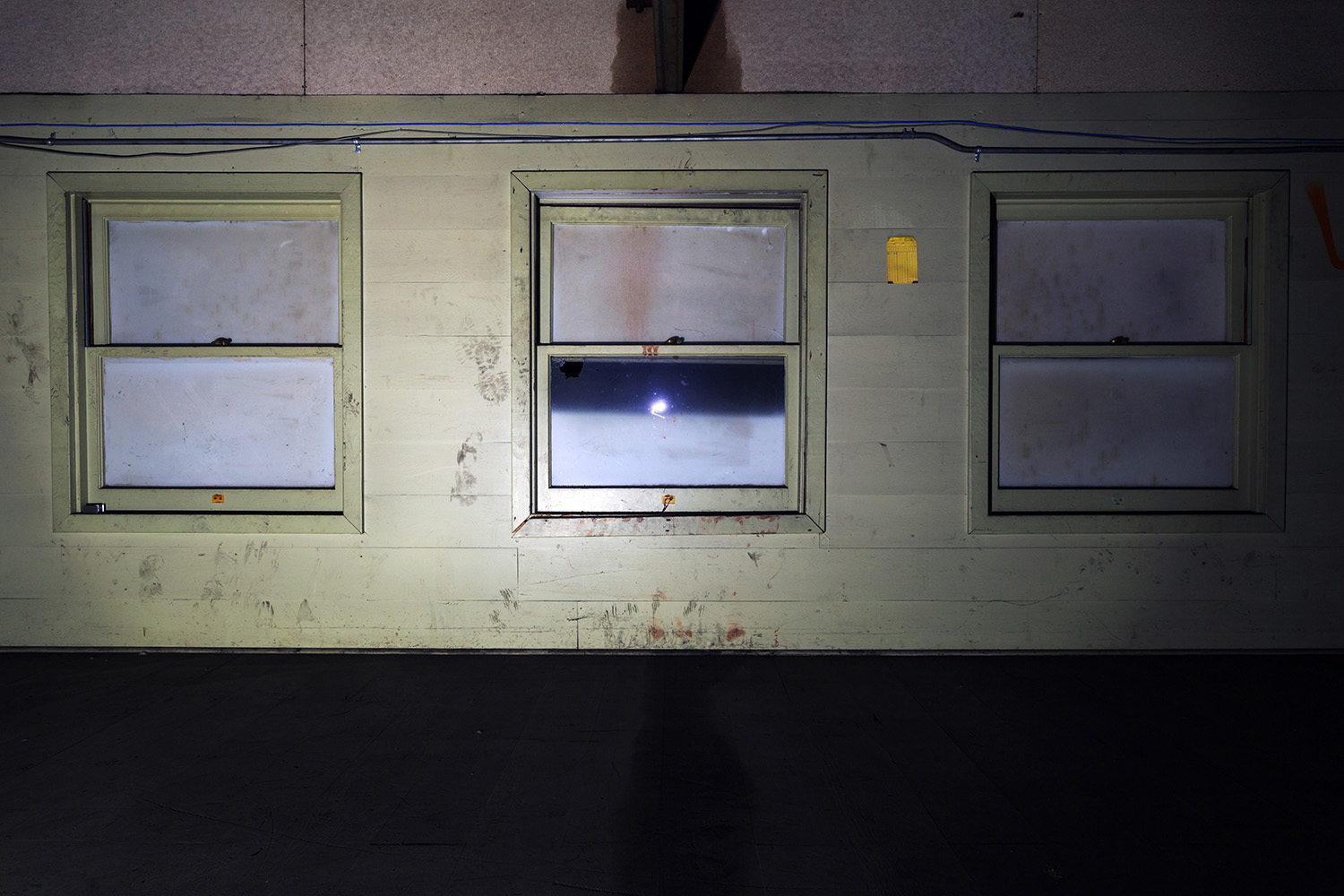
I was ultimately led into a large space that appeared to have once been a file-storage room. Additional wooden shelves of various size and color, as well as the odd file cabinet, now stood empty and alone, left behind by man, who in his infinitely whimsical nature had once again moved on:
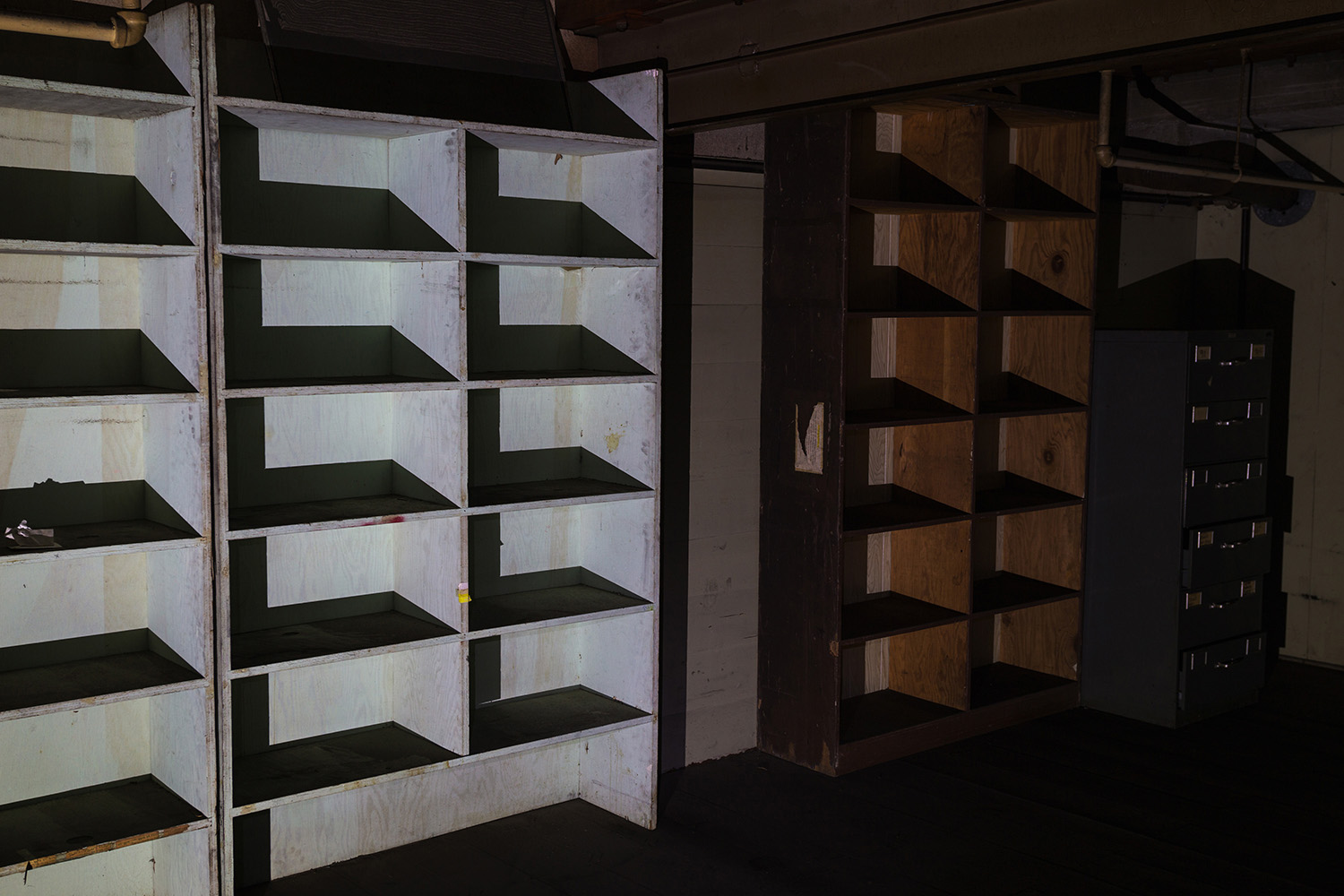
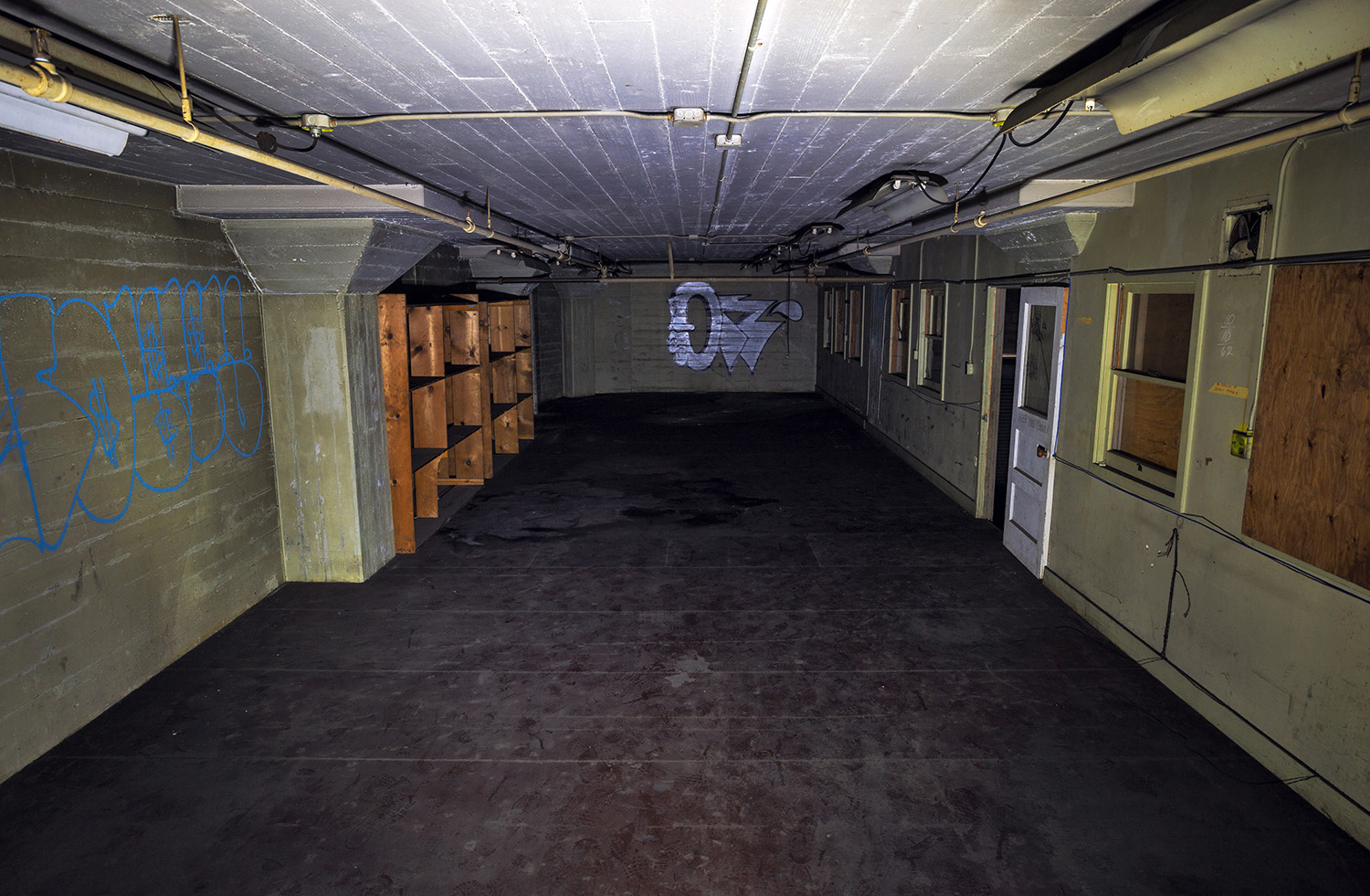
I exited through the white door on the right and stood at the stairwell. I was granted a bird's eye view of the first floor. It was well-stocked with various wares, machinery and materials, likely belonging to the shipyards or its tenants:
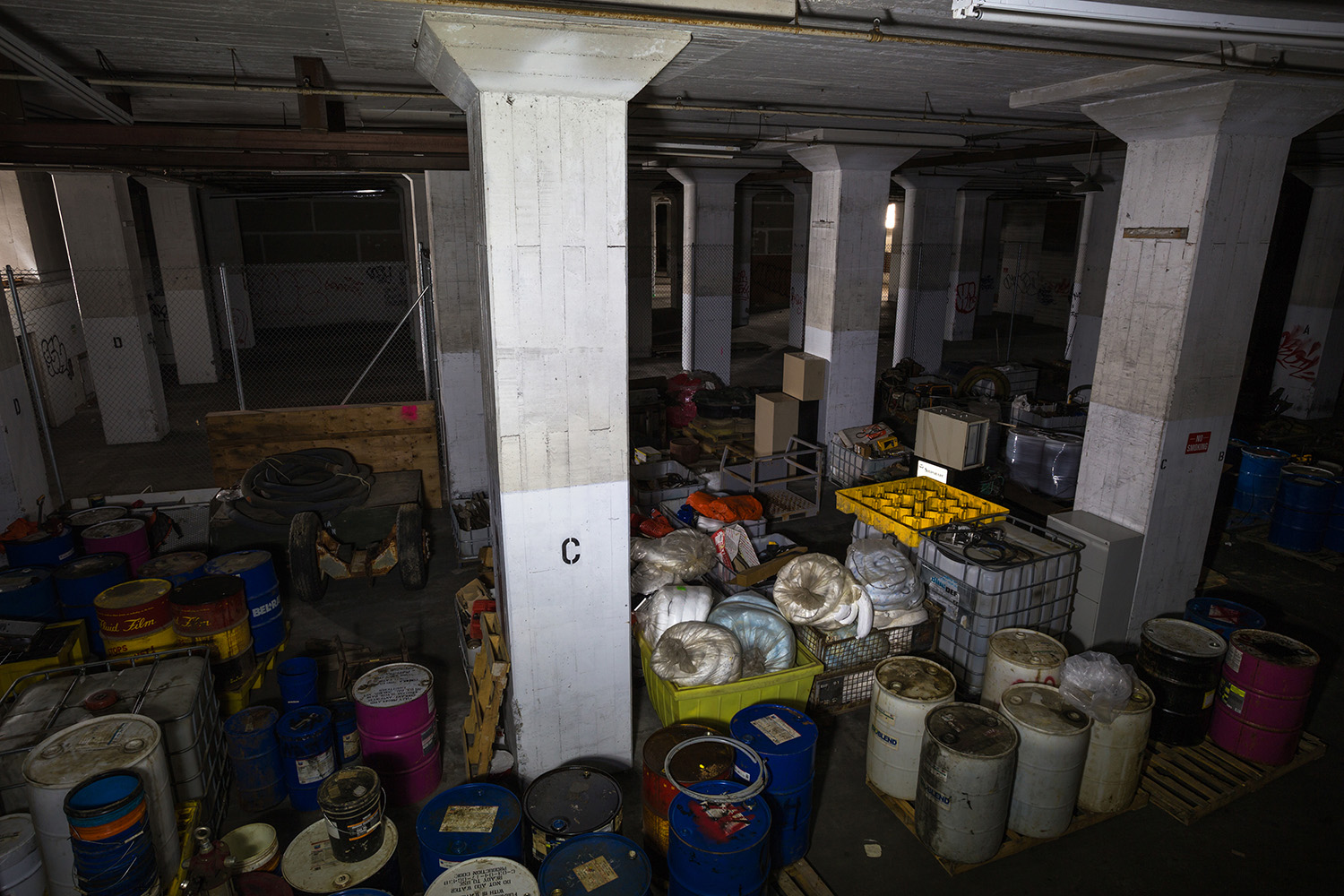
And just like that, I realized that my time at the General Warehouse had now come to an end. While there surely was more that I could have explored, the clock had advanced and I had more or less documented the entirety of the mammoth enclosure. I had walked the concrete ground, climbed through four floors of darkness and decay and had met the building's occupants, either in spirit or matter, who spoke of the history of this once magnificent and important structure. I will admit that it was not without some reluctance that I gathered my gear and headed toward the exit. In a way I did not want to leave, at least not yet, and I definitely did not want to return the key that the nice people at the Port Of Richmond offices had so generously entrusted me with.
As I emerged into the gray, rainy afternoon, many thoughts crowded my mind. Chief among them was the nagging, unanswered question of what will happen to this historic place. Will it survive the changing times around it without an immediate purpose to fulfill, or would this orphan of war become another victim of so-called modernization and ceaseless new construction? In an environment where preservation and reverence of history often take a back seat to over-development, profit and greed without regard for heritage, nothing is guaranteed.
World War II presented a massive shift in consciousness, development and industry that, for better or worse, changed American society and the fabric of the country in significant ways. The San Francisco Bay Area was no exception. But today, it feels like the legacy, culture and physical presence of the generation that is often called The Greatest, are slowly fading into oblivion. It might seem silly to presume that the preservation and utilization of material remnants of an era will help keep its other more important and subtle legacies alive, but I do believe (often against common sense and logic) that there is great value in not letting the physical symbols of our history die.
Sites like the General Warehouse, the SS Red Oak Victory and the Richmond Shipyards as a whole (what little is left of their original form), can bring a whole new dimension to the Bay Area's appeal, if maintained, marketed and presented for all who wish to visit a living piece of history. For visitors seeking an alternative to the usual crowded, clichéd, selfie-stick-wielding touristic experience, the existence of places like the General Warehouse could potentially generate a whole new level of interest in the San Francisco region.
I did end up returning the key after all. As I sloshed through the multitude of puddles on the way back to the car, I was struck once again by the imposing exterior of the building that I had just departed from. For the first time, I noticed that a portion of the original "General Warehouse" metal sign still remained, maimed and rusted, above the entrance at 1324 Canal Boulevard. It was only fitting that I end my experience with a few shots to document the outside of the warehouse. And now, as I end this article, I believe it is also fitting that these images have the last word in this tale of ghosts of past and present. It is my hope that it will be a tale that still has a few chapters left.
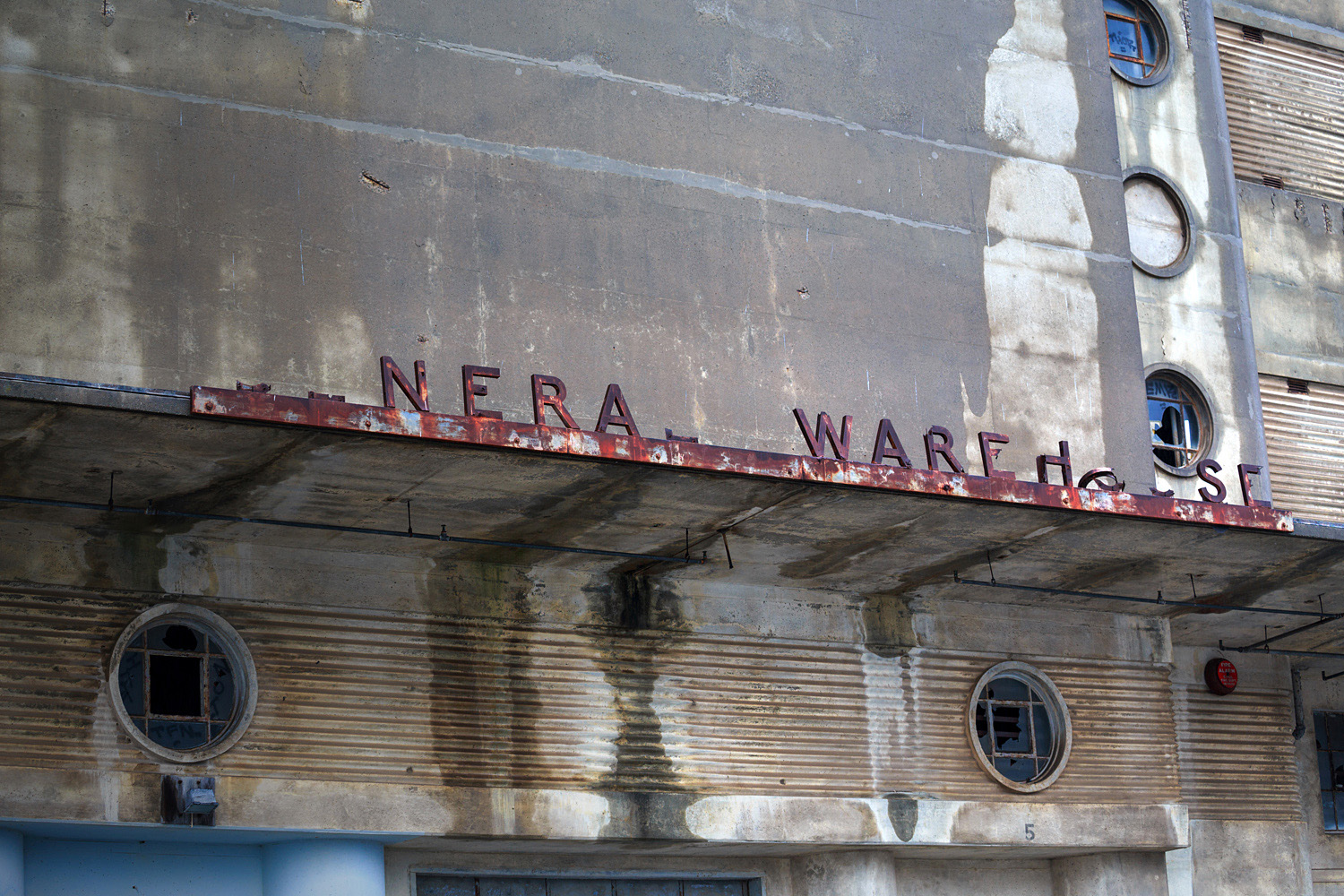
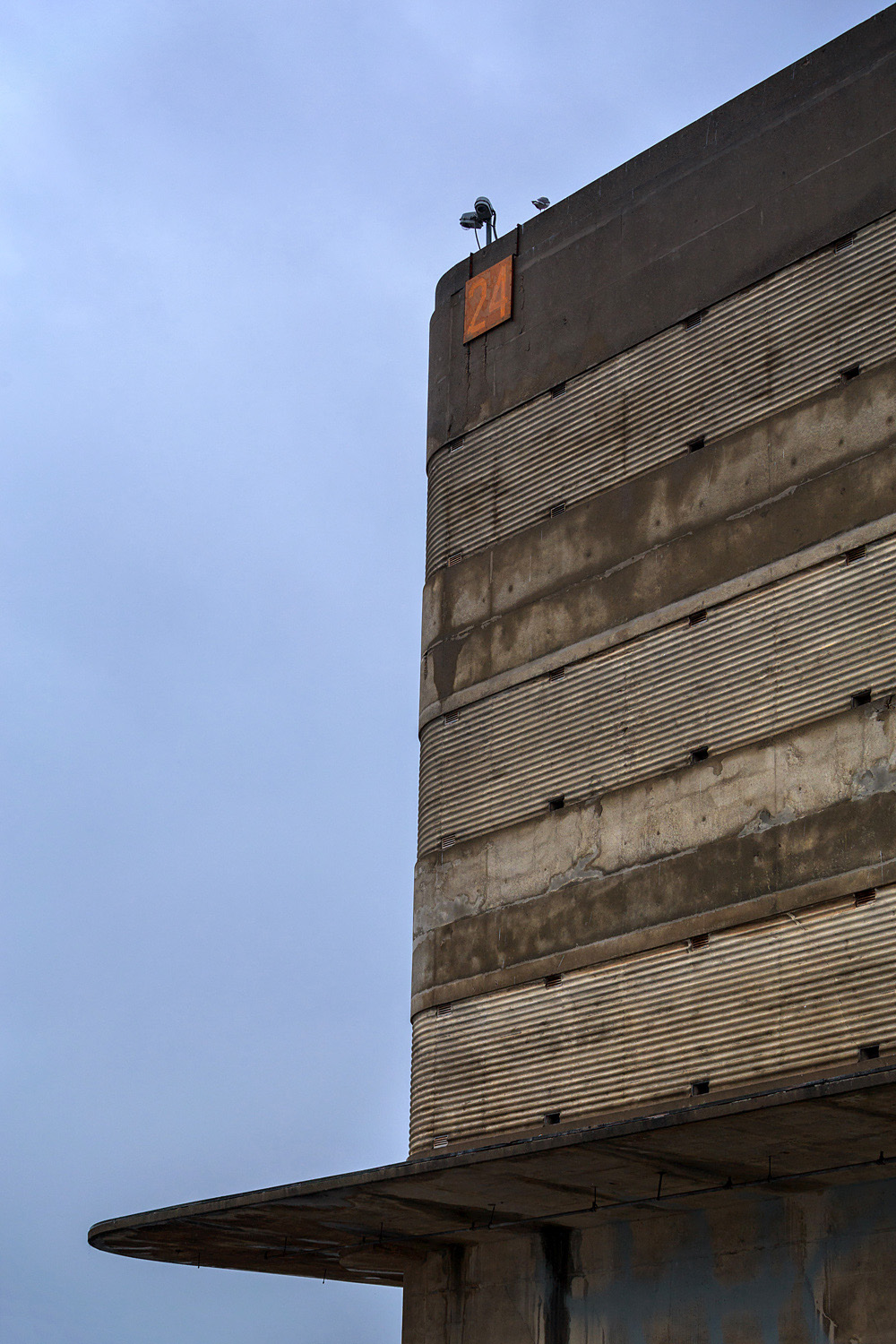
With gratitude to Jim Matzorkis and The Port Of Richmond for their generous assistance, without which, this experience would not have been possible. And, to Jon Haeber, for providing invaluable historical information on the General Warehouse and Shipyard Number Three.
SOURCES:
The City Of Richmond, CA
The National Park Service
Berkeley Heritage
-Wiss, Janney, Elstner Associates, Inc. (2010). HISTORIC STRUCTURE REPORT, Richmond Shipyard Number Three, Consolidated History and Architectural Description, Richmond, California.


Great job!Greatings from Austrian Alps.
Dear Mr. Manolov,
I really like these photos of the General Warehouse! I recently visited the shipyard and a whim and wanted to get inside of the General warehouse.
i have a quick question, what are those light streaks in two of the photos? You mentioned that warehouse spirits made their appearance? I am so curious on what those streaks are. Have you encountered them before?
Thanks!
-Brody
Hey Brody!
Apologies for the late reply - I was having some issues with the site in the past few weeks.
The light streaks are me light painting with my flashlight during a long exposure photograph (you have the shutter continually open for a minute or two and then you move a light source around in front of the camera - you can 'draw' on the picture in that way and create light effects). If there are any actual spirits there (which there very well might be, given all that the place has experienced and seen through the years!), they did not make themselves obvious to me during my visit 😉
All the best,
Manol
Such a great article. Thanks for sharing.
Thanks, Leslie! Glad you enjoyed the writeup! Best, Manol.
[…] is still standing proud, though its sign has crumbled and there’s no getting inside (though one photographer did a few years ago). Anyway, a few shots from the yards one night last week. Amazing […]
So jealous, I have lived here my entire life and never been inside. I appreciated the photographic journey.
Will recommend this to others who are workers at Rosie National Park
Thanks, Pat! And apologies for the very late reply - I've been having some issues with the comments here. All the best! -Manol
Thank you so much for this wonderful story and pictures.
I have long wanted to see inside this building. Now I feel I have.
Thanks for perusing getting in and for sharing!
Thank you for checking out the story, Kathy! And apologies for the late reply. I was also very happy to finally have a look inside - felt it might be the only chance to document this place before it metamorphoses into God-knows-what. Best regards, Manol.
Mr Brody Manalov,
Thank you for all your effort to give us this very enlightening experience! It's a fascinating building with so much history. Hopefully it will be used and useful soon now and maintained for other things. The magnificent Craneway Pavilion and the businesses in that complex give us hope! It's so sad that some of the docks where they built the ships are crumbling because they are unused. I live nearby and take walks close to hear on a regular basis, so it's nice to see behind those walls.
MaryLou
Thank you for reading, MaryLou! Sorry for the great delay in replying to your comment. I agree, the building is absolutely fascinating, and the decrepit state I found it in did not diminish the awe I've felt when seeing it from the outside one bit. I truly hope that the warehouse will survive and find a renewed purpose, as it is an iconic part of the region. I've always felt sad that more of the shipyards complex did not survive as it is. All the more reason to pursue the preservation of the few original buildings that remain. All the best! -Manol.
Thanks for this remarkable piece. I think you were brave to enter and explore the place, which seemed full of pitfalls and risk. Any idea what has been decided for its use? Mayor Butt said "cannabis," which explains nothing. Seems way too big (and dark) to be devoted to growing and selling dope. Would be way better to make a mini-museum for people to learn about Richmond history. Sort of like an Exploratorium, if Richmond could raise the funds.
Hi Elizabeth,
Thank you for your kind words. It was great to finally be able to see inside this building - I've been curious about it for many years. The experience is definitely not for everyone, but being able to explore this forgotten bit of history up-close was worth it! I haven't heard anything concrete in regards to the warehouse's future, except, as you mentioned, a vague rumor about turning it into some kind of cannabis facility. To me, it doesn't really matter all that much, as long as the building gets to stay and finds some kind of use. But yes, it would be far more ideal to have the warehouse turned into a museum dedicated to the history of the shipyards and World War II in the area. One can hope, but seeing the disregard for history and its preservation that is continually exhibited in the Bay Area, I am not sure how realistic this is to expect. Time will tell! Best, Manol.
Awesome photo essay!! Amazing to see inside that building at long last. My dad worked at Shipyard Number 3 and was also, in the 90's, instrumental in getting the Red Oak Victory ship brought to Richmond. He probably was in that warehouse hundreds of times in the 40's and maybe even later. He would have loved your essay. I'm curious how so much graffiti could be in there if the building is kept locked. Are kids crawling in through open windows? The graffiti on the "antique" computer monitor was kind of chilling, like a science fiction movie about the world after human civilization is gone. Thanks for the photos and the vicarious trip inside. Great work!
Hi Martha! Sorry for the late reply. Thank you so much, glad you enjoyed the 'walkthrough'. It was awesome for me to finally see this monster from the inside, as well. That's really cool about your dad - I bet he had some great stories to share from the time spent in the shipyards. Would have loved to meet him and talk to him about his experiences. Did he have any photographs from those times, by chance? All the best! -Manol
Thank you for this very interesting look at a most mysterious building. The grafitti, which I don't usually like, was welcome in this grey atmosphere. I'm sure there is much more to the story. Beds and blankets?
Hi Jan! Thanks for your comment. I agree, the graffiti, in a way, worked well with the drab colors of the structure. It definitely helped the pictures out! I'm sure there is a lot more to the warehouse story - and, as for the beds and blankets, I believe that at one point access to the inside of the building was far easier than it is now, and it seems that anyone and everyone could find their way in. Would not be surprised if people spent the night/lived inside. There are definitely traces of some level of 'occupation' Regards, Manol.
Thanks for your curiosity....!! i walk past that building a few times a week......would love to see it 'repurposed' as with every other dockside structure.......the graffiti reminds of the old molasses tanks at Pt San Pablo...the 'artists' had gained entry and painted the insides......really beautifully!!!!.......i have the slides from a visit in the 90's.....i can't wait for your next exploration......i think the Bay residents would love a 'coffee-table' book......with your photographic skills
and historical 'reveals' of places and structures....'hidden' from most citizens.......i felt similarly about the decommissioned bases of Mare Island and Alameda......would love to see a compilation of the 'Bayside Treasures'
left by that 'Greatest Generation'........can't wait for next exploration!!!! stew
Hey Stew! Apologies for the super late reply - I've been having some issues with the site that are now resolved. Thank you for the kind words, I am really glad you enjoyed the "walk" through one of the most fascinating buildings in the Bay Area, surely! I really hope we can keep this kind of history alive for future generations to see, hopefully those with the resources to make that happen, both legislatively and financially, are of the same mind. As for a book, my book "Left Behind" pretty much documents exactly what you were describing. It was released in 2020 and available through the "Book" page on my site, if you are interested. Otherwise, I am always exploring (though it has been a bit slow lately), so new material should be popping up on here (and hopefully also in book form) sooner or later. All the best! -Manol
So great to find your photo/essay of the building. I”m a Bay Area Native and have biked through Richmond dozens of times. This time the friend I was with said lets go this way - the “dead end” to the General Warehouse. So Amazing to be able to find your informative piece and learn about its’ use. For indoor cannabis - all they need is lots of electricity and water….maybe that on the top two floors to fund a museum on the ground floor? Combine $ making with Public Space/Art/etc. Bit “out of the way” but on a historic part of the Bay. Thanks for your energy and info
Hey there! Thanks for the kind words and for taking the time to write. I'm glad you stumbled upon the Warehouse and found my adventure and write-up useful. Funnily enough, the whole thing came about because I was also fascinated by the building and frustrated that I was not able to see inside it and learn more about its origins. It makes me happy that the words and images I had so much fun making are still helping inform others about this really cool and important piece of Bay Area history. I sincerely hope that the future has some good things in store for the General Warehouse, and that some sort of educational/museum component is part of the story. The shipyards and the remaining buildings of this emblematic place deserve it. All the best and stay in touch! -Manol
Excellent job. I've been sailing out of Marina Bay for more than three decades, wondering about that building. I'm very grateful that you put the effort in to document it.
Hey Tony,
It was the same curiosity that motivated the exploration of the warehouse in the first place. Thank you for reading, I am glad that the writeup was interesting and helpful. Happy sailing, wish you all the best!
-Manol